
So, you’ve already mastered the beginner level in Japanese? Congratulations! That means you know how to write Hiragana, Katakana, and the basic Kanji, as well as the basic grammar rules. Now you’re ready to level up to intermediate Japanese!
At some point during your studies, you probably heard about the JLPT (Japanese-Language Proficiency Test). This is a standardized test that evaluates the Japanese-language proficiency of non-native speakers, including their language knowledge (vocabulary/grammar), reading ability, and listening ability. Level N3 is equivalent to the intermediate level, and setting a goal for yourself to pass this level would be a good source of motivation to help you keep up your studies.
You faced the first challenge when you started learning Japanese, a language with a totally new set of characters and grammar rules from English. However, the beginner level is rewarding in that you can easily see your progress the more you study. On the other hand, the intermediate level is when things start getting hard—you need continuous effort and patience to make meaningful advances at this stage. Although the progress may seem very slow, you’ll steadily move forward as long as you don’t give up!
In this article, we’ll introduce a list of frequently used intermediate Japanese words, including larger numbers, nouns, verbs, adjectives, adverbs, and even conjunctions and Japanese particles. Let’s start the journey toward conquering the next level here at JapanesePod101.com!

The Japanese intermediate level gets harder, but you can still have fun learning with JapanesePod101.com.
 Table of Contents
Table of Contents
- Larger Numbers
- Nouns – 名詞 (Meishi)
- Verbs – 動詞 (Dōshi)
- Adjectives – 形容詞 (Keiyōshi)
- Adverbs – 副詞 (Fukushi)
- Conjunctions – 接続詞 (Setsuzokushi)
- Auxiliary Words and Particles – 助詞 (Joshi)
- Conclusion
1. Larger Numbers
Once you know the basic Japanese numbers, counting to larger numbers is fairly simple. We can easily express these numbers with Kanji using relatively few digits.
Keep in mind, however, that we group larger numbers by every 10,000 (rather than every 1,000 like in Western counting). That said, when we do write the Arabic numbers in Japan, it’s common to use commas for every thousand just like it’s done in the West.
| Arabic Number | Kanji | Hiragana | Reading |
| 100 | 百 | ひゃく | hyaku |
| 1,000 | 千 | せん | sen |
| 10,000 | 万 | まん | man |
| 100,000 | 十万 | じゅうまん | jū-man |
| 1,000,000 | 百万 | ひゃくまん | hyaku-man |
| 10,000,000 | 千万 | せんまん | sen-man |
| 100,000,000 | 億 | おく | oku |
| 1,000,000,000 | 十億 | じゅうおく | jū-oku |
| 10,000,000,000 | 百億 | ひゃくおく | hyaku-oku |
| 100,000,000,000 | 千億 | せんおく | sen-oku |
| 1,000,000,000,000 | 兆 | ちょう | chō |
Number-related Vocabulary
| English | Kanji | Hiragana | Reading |
| number | 数字 | すうじ | sūji |
| calculation | 計算 | けいさん | keisan |
| arithmetic | 算数 | さんすう | sansū |
| mathematics | 数学 | すうがく | sūgaku |
| addition | 足し算 | たしざん | tashizan |
| subtraction | 引き算 | ひきざん | hikizan |
| multiplication | 掛け算 | かけざん | kakezan |
| division | 割り算 | わりざん | warizan |
Examples:
- 私のいとこは宝くじで2億円を当てました。
Watashi no itoko wa takarakuji de ni-oku-en o atemashita.
“My cousin won 200 million Yen in the lottery.”
- 2020年の日本の国家予算は約103兆円です。
Ni-sen ni-jū-nen no Nihon no kokka yosan wa yaku hyaku san-chō-en desu.
“Japan’s national budget in 2020 was around 103 trillion Yen.”
- 私は毎日その日の利益を計算します。
Watashi wa mainichi sono hi no rieki o keisan shimasu.
“I calculate the profit for the day every day.”

We can easily express larger numbers with Kanji.
2. Nouns – 名詞 (Meishi)
Our next set of intermediate Japanese vocabulary words will cover the most practical nouns in a range of categories. At this stage in your learning journey, picking up as many new nouns as possible will help you better express yourself and allow you to hold conversations on a greater number of topics.
Time
| English | Kanji | Hiragana | Reading |
| sunrise | 日の出 | ひので | hinode |
| sunset | 日没 | にちぼつ | nichibotsu |
| instant (a very short moment) | 一瞬 | いっしゅん | isshun |
| a whole life / lifetime / for life | 一生 | いっしょう | isshō |
| a time / while / one time | 一時 | いちじ | ichiji |
| a short period or term | 短期 | たんき | tanki |
| a medium-length period or term | 中期 | ちゅうき | chūki |
| a long period or term | 長期 | ちょうき | chōki |
| a school term / semester | 学期 | がっき | gakki |
| this time | 今回 | こんかい | konkai |
| hereafter / from now on / onward | 今後 | こんご | kongo |
Examples:
- 夏は日の出が早く、日没が遅い。
Natsu wa hinode ga hayaku, nichibotsu ga osoi.
“In summer, the sunrise (time) is early and the sunset (time) is late.”
- 彼は短期目標を設定しました。
Kare wa tanki mokuhyō o settei shimashita.
“He has set a short-term goal.”
- 私は今後一切タバコを吸いません。
Watashi wa kongo issai tabako o suimasen.
“I will never smoke cigarettes from now on.”
2. People
| English | Kanji | Hiragana | Reading |
| individual | 個人 | こじん | kojin |
| group | 集団 | しゅうだん | shūdan |
| citizen | 市民 | しみん | shimin |
| people (of a country) or nation | 国民 | こくみん | kokumin |
| man / boy / male | 男子 | だんし | danshi |
| woman / girl / female | 女子 | じょし | joshi |
| infant | 幼児 | ようじ | yōji |
| young man / young people / youth | 青年 | せいねん | seinen |
| elderly | 年配 | ねんぱい | nenpai |
| old person / the aged | 老人 | ろうじん | rōjin |
| stranger / others | 他人 | たにん | tanin |
| colleague / coworker | 同僚 | どうりょう | dōryō |
| boss / superior | 上司 | じょうし | jōshi |
| subordinate | 部下 | ぶか | buka |
| employee / staff | 社員 | しゃいん | shain |
| president / head (of a company) | 社長 | しゃちょう | shachō |
Examples:
- 国民の三大義務は、教育、労働、納税です。
Kokumin no sandai gimu wa, kyōiku, rōdō, nōzei desu.
“The three major duties of the people in Japan are education, labor, and paying taxes.”
- あの青年は老人介護施設で働いています。
Ano seinen wa rōjin kaigo shisetsu de hataraite imasu.
“That young man works at a nursing home for the elderly.”
- 私の目標は起業して社長になることです。
Watashi no mokuhyō wa kigyō shite shachō ni naru koto desu.
“My goal is to start a business and become president.”
To learn more work-related vocabulary words with audio, we recommend you check out our wordlists Jobs / Work and Workplace.

昼休みに同僚と雑談する (hiruyasumi ni dōryō to zatsudan suru)
“chat with colleagues during lunch break”
3. Other Nouns
| English | Kanji | Hiragana | Reading |
| start / beginning | 開始 | かいし | kaishi |
| end / close / termination | 終了 | しゅうりょう | shūryō |
| stop / suspension | 停止 | ていし | teishi |
| base / fundament / standard | 基本 | きほん | kihon |
| basis / foundation | 基礎 | きそ | kiso |
| (practical) application | 応用 | おうよう | ōyō |
| input / entry / filling in / filling out | 記入 | きにゅう | kinyū |
| article | 記事 | きじ | kiji |
| right | 権利 | けんり | kenri |
| rules / regulations | 規則 | きそく | kisoku |
| law | 法律 | ほうりつ | hōritsu |
| accounting | 会計 | かいけい | kaikei |
| business / commerce | 商売 | しょうばい | shōbai |
| profit | 利益 | りえき | rieki |
| product | 製品 | せいひん | seihin |
| lack / shortage / deficiency | 不足 | ふそく | fusoku |
| income | 収入 | しゅうにゅう | shūnyū |
| documents | 書類 | しょるい | shorui |
| cooperation / collaboration | 協力 | きょうりょく | kyōryoku |
| satisfaction / contentment | 満足 | まんぞく | manzoku |
| dissatisfaction | 不満 | ふまん | fuman |
Examples:
- 開始と終了の時間に、ベルが鳴ります。
Kaishi to shūryō no jikan ni, beru ga narimasu.
“The bell rings at the start and end times.”
- 法律に基づき、18歳以上の国民は投票する権利があります。
Hōritsu ni motozuki, jū hassai ijō no kokumin wa tōhyō suru kenri ga arimasu.
“By law, citizens over 18 years old have the right to vote.”
- パンデミックの影響で、衛生製品が不足しています。
Pandemikku no eikyō de, eisei seihin ga fusoku shite imasu.
“Due to the influence of the pandemic, there is a shortage of hygiene products.”

書類に記入する (shorui ni kinyū suru)
“fill out the document”
To learn more Japanese nouns, please check out Guide to the Top 100+ Japanese Nouns on our website.
3. Verbs – 動詞 (Dōshi)
Verbs, like nouns, make up a huge chunk of any language’s vocabulary. At the beginner level, you picked up a number of useful action words and auxiliaries to get your point across—but as you approach the intermediate level, you may find yourself needing more advanced verbs to clearly express your thoughts. Below is a list to get you started.
General Verbs
| English | Kanji | Hiragana | Reading |
| to encounter / to meet / to come across | 出会う | であう | deau |
| to remove / to undo | 外す | はずす | hazusu |
| to like / to be pleased with | 気に入る | きにいる | ki ni iru |
| to fall down / to fall over | 転ぶ | ころぶ | korobu |
| to receive | 受け取る | うけとる | uketoru |
| to take (something) out | 取り出す | とりだす | toridasu |
| to divide / to split / to separate | 分ける | わける | wakeru |
| to give up | 諦める | あきらめる | akirameru |
| to lose interest in / to get tired of | 飽きる | あきる | akiru |
| to be enough / to be sufficient | 足りる | たりる | tariru |
| to remain / to be in excess | 余る | あまる | amaru |
| to appear / to show up / to turn up | 現れる | あらわれる | arawareru |
| to express / to show | 表す | あらわす | arawasu |
| to treat / to handle / to deal with | 扱う | あつかう | atsukau |
| to put together / to combine / to add to / to match | 合わせる | あわせる | awaseru |
| to deposit / to consign / to entrust | 預ける | あずける | azukeru |
| to touch | 触れる | ふれる | fureru |
| to shake / to tremble / to vibrate / to shudder / to shiver | 震える | ふるえる | furueru |
| to prevent / to guard against | 防ぐ | ふせぐ | fusegu |
| to wear (trousers, skirt, shoes) / to put on | 履く | はく | haku |
| to discuss | 話し合う | はなしあう | hanashiau |
| to separate / to keep apart / to isolate | 離す | はなす | hanasu |
| to release / to free / to let go | 放す | はなす | hanasu |
| to decrease | 減る | へる | heru |
| to pull | 引く | ひく | hiku |
| to celebrate | 祝う | いわう | iwau |
| to dislike | 嫌がる | いやがる | iyagaru |
| to be concerned with / to engage in / to be related to | 関わる | かかわる | kakawaru |
| to hide | 隠す | かくす | kakusu |
| to earn / to make money | 稼ぐ | かせぐ | kasegu |
| to pile up / to put on top of one another | 重ねる | かさねる | kasaneru |
| to shine / to sparkle | 輝く | かがやく | kagayaku |
| to repeat | 繰り返す | くりかえす | kurikaesu |
| to stretch / to get longer / to grow | 伸びる | のびる | nobiru |
| to remove / to get rid of / to exclude | 除く | のぞく | nozoku |
Examples:
- 諦めたらそこで試合は終了です。
Akirametara soko de shiai wa shūryō desu.
“If you give up, the game ends there.”
- あなたに預けた書類を受け取りに来ました。
Anata ni azuketa shorui o uketori ni kimashita.
“I came to pick up the documents I entrusted to you.”
- 彼は彼女に関わることを嫌がった。
Kare wa kanojo ni kakawaru koto o iyagatta.
“He disliked getting involved with her.”
[ Noun + する (suru) ] Verbs
This type of Japanese verb is formed by using this pattern: noun + する (suru). You may remember that する (suru) means “do,” and in this case, we use it to create verbs. For example:
- 期待する (kitai suru) or “to expect” = 期待 (kitai) “expectation” + する (suru) “do”
| English | Kanji | Hiragana | Reading |
| to go out | 外出する | がいしゅつする | gaishutsu suru |
| to make (an) effort | 努力する | どりょくする | doryoku suru |
| to memorize / to store data | 記憶する | きおくする | kioku suru |
| to expect / to hope to | 期待する | きたいする | kitai suru |
| to grow (up) | 成長する | せいちょうする | seichō suru |
| to lack | 不足する | ふそくする | fusoku suru |
| to match / to coincide | 一致する | いっちする | itchi suru |
| to agree with / to support (a measure) | 賛成する | さんせいする | sansei suru |
| to oppose / to object | 反対する | はんたいする | hantai suru |
| to concentrate | 集中する | しゅうちゅうする | shūchū suru |
| to import | 輸入する | ゆにゅうする | yunyū suru |
| to export | 輸出する | ゆしゅつする | yushutsu suru |
| to sell | 販売する | はんばいする | hanbai suru |
| to zoom / to enlarge / to expand | 拡大する | かくだいする | kakudai suru |
| to shrink / to reduce / to diminish | 縮小する | しゅくしょうする | syukushō suru |
Examples:
- 彼は彼女に会えることを期待して外出しました。
Kare wa kanojo ni aeru koto o kitai shite gaishutsu shimashita.
“He went out hoping to see her.”
- この会社は日本茶を海外へ輸出して、世界中で販売しています。
Kono kaisha wa nihoncha o kaigai e yushutsu shite, sekaijū de hanbai shite imasu.
“This company exports Japanese tea overseas and sells it all over the world.”
- 勉強する時はテレビを消して集中しなさい。
Benkyō suru toki wa terebi o keshite shūchū shinasai.
“When you study, turn off the TV and concentrate.”
To learn more about Japanese verbs, please check out our articles The 100+ Most Common Japanese Verbs and Ultimate Japanese Verb Conjugation Guide.

努力して試験に合格 (doryoku shite shiken ni gōkaku)
“passing the exam by making an effort”
4. Adjectives – 形容詞 (Keiyōshi)
As a beginner, you probably spent most of your time memorizing nouns, verbs, and practical sentence patterns. But once you have the basics down, picking up a few common adjectives can help you enrich your conversations and add flavor to your writing. Below, we’ve listed the most useful adjectives for intermediate Japanese learners.
i-Adjectives
| English | Kanji | Hiragana | Reading |
| intense / hard / violent / fierce / furious | 激しい | はげしい | hageshii |
| nostalgic / dear | 懐かしい | なつかしい | natsukashii |
| shameful / pitiful / miserable | 情けない | なさけない | nasakenai |
| frightening / terrifying / fearful | 恐ろしい | おそろしい | osoroshii |
| persistent / insistent | ー | しつこい | shitsukoi |
| powerful | 力強い | ちからづよい | chikarazuyoi |
| smart / wise / clever | 賢い | かしこい | kashikoi |
| childlike / childish / infant | 幼い | おさない | osanai |
| hard / tough / painful / bitter | 辛い | つらい | tsurai |
| jealous / envious | 羨ましい | うらやましい | urayamashii |
| loose / lax | 緩い | ゆるい | yurui |
| equal / equivalent | 等しい | ひとしい | hitoshii |
| itchy | 痒い | かゆい | kayui |
| noisy | 騒がしい | さわがしい | sawagashii |
| funny | 可笑しい | おかしい | okashii |
| empty / void / fruitless | 空しい | むなしい | munashii |
| refreshing / refreshed | 清々しい | すがすがしい | sugasugashii |
| menial / vulgar / greedy | 卑しい | いやしい | iyashii |
| lovely / adorable | 可愛らしい | かわいらしい | kawairashii |
| missed / longed for | 恋しい | こいしい | koishii |
| smelly / stinky | 臭い | くさい | kusai |
| tight / hard / tough | ー | きつい | kitsui |
| detailed | 詳しい | くわしい | kuwashii |
| regretful / mortifying | 悔しい | くやしい | kuyashii |
| dazzling / bright | 眩しい | まぶしい | mabushii |
| poor | 貧しい | まずしい | mazushii |
| gentle / mild / quiet | 大人しい | おとなしい | otonashii |
| fortunately / luckily | 幸い | さいわい | saiwai |
| sharp | 鋭い | するどい | surudoi |
| dull / slow | 鈍い | にぶい | nibui |
| rough / harsh / wild | 荒い | あらい | arai |
Examples:
- 台風の影響で激しい雨が降っています。
Taifū no eikyō de hageshii ame ga futte imasu.
“It is raining hard due to the typhoon.”
- 公園で可愛らしい女の子が一人で遊んでいました。
Kōen de kawairashii onnanoko ga hitori de asonde imashita.
“The adorable girl was playing alone in the park.”
- 彼は大人しいが、鋭い洞察力を持っています。
Kare wa otonashii ga, surudoi dōsatsuryoku o motte imasu.
“He is quiet but has keen insight.”

太陽が眩しい。 (Taiyō ga mabushii.)
“The sun is bright.”
na-Adjectives
| English | Kanji | Hiragana | Reading |
| serious / earnest | 真面目 | まじめ | majime |
| eager / zealous / ardent | 熱心 | ねっしん | nesshin |
| advantageous | 有利 | ゆうり | yūri |
| flat / even | 平ら | たいら | taira |
| troublesome / cumbersome | 厄介 | やっかい | yakkai |
| rich / abundant / fertile | 豊か | ゆたか | yutaka |
| luxurious | 贅沢 | ぜいたく | zeitaku |
| slight / subtle | 僅か | わずか | wazuka |
| obstructive | 邪魔 | じゃま | jama |
| obvious | 明らか | あきらか | akiraka |
| troublesome / annoying / unwelcome | 迷惑 | めいわく | meiwaku |
| troublesome / onerous / perplexing | 面倒 | めんどう | mendō |
Examples:
- この箱は平らな所に置いてください。
Kono hako wa taira na tokoro ni oite kudasai.
“Please place this box on a flat surface.”
- 私は僅かな可能性があれば、希望を捨てない。
Watashi wa wazuka na kanōsei ga areba, kibō o sutenai.
“I will not lose hope if there is a slight possibility.”
- 彼は明らかな間違いを犯しました。
Kare wa akiraka na machigai o okashimashita.
“He made an obvious mistake.”
To learn more about Japanese adjectives, please check out our articles Learn the Top 100 Essential Japanese Adjectives and -I vs. -NA Adjectives in Japanese.
5. Adverbs – 副詞 (Fukushi)
While adjectives describe nouns, adverbs provide additional information about verbs, adjectives, or other adverbs. At this stage in your learning journey, having a few Japanese adverbs up your sleeve will allow you to give more detailed descriptions of events and help your writing flow more smoothly.
| English | Kanji | Hiragana | Reading |
| at once / immediately / promptly / right away | 早速 | さっそく | sassoku |
| as … as possible | ー | なるべく | narubeku |
| carelessly / thoughtlessly | ー | うっかり | ukkari |
| probably / presumably | 恐らく | おそらく | osoraku |
| quite / pretty | ー | かなり | kanari |
| approximately / about / roughly | ー | およそ | oyoso |
| just like / as if | ー | まるで | marude |
| abruptly / suddenly | 急に | きゅうに | kyū ni |
| rather | ー | むしろ | mushiro |
| kind of / sort of / fairly / reasonably | ー | なかなか | nakanaka |
| what is more / furthermore / moreover | 更に | さらに | sara ni |
| already | 既に | すでに | sude ni |
| for some time / for a while | 暫く | しばらく | shibaraku |
| surely / definitely / indeed | 確かに | たしかに | tashika ni |
| rather / quite a | 随分 | ずいぶん | zuibun |
| at one time / at once / all at once | 一度に | いちどに | ichi-do ni |
| all / whole | 全て | すべて | subete |
| desperately / frantically | 必死に | ひっしに | hisshi ni |
| deliberately / on purpose | ー | わざと | wazato |
| increasingly / more and more | 益々 | ますます | masumasu |
| one after another | 次々と | つぎつぎと | tsugitsugi to |
| anytime / at all times | ー | いつでも | itsu demo |
| before one is aware / before one knows | いつの間にか | いつのまにか | itsunomanika |
| indeed / really | 実に | じつに | jitsu ni |
| as it is | ー | そのまま | sonomama |
| each / respectively | ー | それぞれ | sorezore |
| sometimes | 時々 | ときどき | tokidoki |
| always / at all times / constantly | 常に | つねに | tsune ni |
| suddenly | 突然 | とつぜん | totsuzen |
| in/at the beginning | 始めに | はじめに | hajime ni |
| early / earlier / ahead of time | 早めに | はやめに | hayame ni |
| before long / shortly | 間もなく | まもなく | mamonaku |
| at least | 少なくとも | すくなくとも | sukunakutomo |
| by chance / accidentally / unintentionally | ー | たまたま | tamatama |
| in particular / particularly | 別に | べつに | betsu ni |
| anyways / in any case | ー | とにかく | tonikaku |
| by all means | ー | どうしても | dōshitemo |
| again / once again | 再び | ふたたび | futatabi |
| together | 共に | ともに | tomo ni |
| a short while ago / a moment ago | 先程 | さきほど | sakihodo |
Examples:
- なるべく早く返信してください。
Narubeku hayaku henshin shite kudasai.
“Please reply as soon as possible.”q145
- 間もなく電車が到着します。
Mamonaku densha ga tōchaku shimasu.
“The train will arrive shortly.”
- 私は別にこれを欲しくない。
Watashi wa betsu ni kore o hoshikunai.
“I don’t want this in particular.”

次々と良い案が浮かぶ (tsugitsugi to ii an ga ukabu)
“come up with good ideas one after another”
6. Conjunctions – 接続詞 (Setsuzokushi)
| English | Kanji | Hiragana | Reading |
| finally / at last | 遂に | ついに | tsuini |
| to sum up / in short / in a word | ー | つまり | tsumari |
| therefore / accordingly / consequently | 従って | したがって | shitagatte |
| so / therefore / hence | ー | ゆえに | yueni |
| therefore / wherefore | ー | それゆえに | soreyueni |
| and then | ー | すると | suruto |
| however | ー | しかしながら | shikashinagara |
| and yet / but even so | ー | それなのに | sorenanoni |
| nevertheless / in spite of | それにも関わらず | それにもかかわらず | sorenimo kakawarazu |
| having said that | とは言うものの | とはいうものの | towa iumonono |
| and / as well as | 及び | および | oyobi |
| besides / moreover / also | ー | かつ | katsu |
| and also / both…and | 並びに | ならびに | narabini |
| first / first of all | 最初に | さいしょに | saisho ni |
| next / secondly | 次に | つぎに | tsugi ni |
| at last / finally | 最後に | さいごに | saigo ni |
| moreover / besides / on top of | ー | しかも | shikamo |
| in addition | 加えて | くわえて | kuwaete |
| moreover / in addition | その上で | そのうえで | sonouede |
| on the one hand | 一方 | いっぽう | ippō |
| conversely / contrarily | 逆に | ぎゃくに | gyaku ni |
| while / on the other hand | 反面 | はんめん | hanmen |
| the reason why is / because | なぜかと言うと | なぜかというと | naze ka to iu to |
| still / yet / even | ー | なお | nao |
| on the condition that… | ー | ただし | tadashi |
| by the way | ー | ちなみに | chinamini |
| in truth / in fact | 実は | じつは | jitsu wa |
| namely / that is to say | ー | すなわち | sunawachi |
| in short / in a word /to sum up | 要するに | ようするに | yōsuruni |
| especially / in particular | 特に | とくに | tokuni |
| above all / in particular | ー | とりわけ | toriwake |
| anyhow / in any case / either way / anyway | ー | いずれにしても | izurenishitemo |
| anyways / above all things | ー | ともあれ | tomoare |
| then / if that is the case | ー | それでは | soredewa |
Examples:
- 従って、規則によりこれは無効となります。
Shitagatte, kisoku ni yori kore wa mukō to narimasu.
“Therefore, this is invalid according to regulation.”
- レストランは12時に閉まります。なお、ラストオーダーは11時です。
Resutoran wa jū ni-ji ni shimarimasu. Nao, rasuto ōdā wa jū ichi-ji desu.
“The restaurant closes at twelve. Yet, the last order is at eleven.”
- いずれにしても、納期は守ってください。
Izurenishitemo, nōki wa mamotte kudasai.
“In any case, please keep the delivery date.”

いずれにしても、来月は赤字になりそうです。
Izurenishitemo, raigetsu wa akaji ni narisō desu.
“In any case, it looks like it will be in the red next month.”
7. Auxiliary Words and Particles – 助詞 (Joshi)
Japanese particles, or 助詞 (joshi), are suffixes or short words that follow a modified noun, verb, adjective, or sentence. Particles play a very important role in Japanese grammar because even a slight difference in this regard could change the meaning/nuance of a sentence. Memorizing and becoming familiar with how to use these particles is a great way to start improving your Japanese as an intermediate learner.
| English | Hiragana | Reading |
| the more…the more | ば…ほど | ba…hodo |
| would have / should have | ば…のに | ba…noni |
| degree / extent | ほど | hodo |
| is not as…as | ほど…ない | hodo…nai |
| no matter how | いくら…ても | ikura…te mo |
| through / from [A] to [B] | [A]から[B]にかけて | [A] kara [B] ni kakete |
| only / just / since / after | …きり | …kiri |
| for sure (emphasizes the preceding word) | …こそ | …koso |
| if / suppose | もしも…たら | moshimo…tara |
| although / despite | …ながらも | …nagaramo |
| even if / even though / regardless of | …ても | …te mo |
| to / for / as far as…is concerned / regarding | …にとって | … ni totte |
| even / so much as / not even | さえ | sae |
| if only / as long as | さえ…ば | sae…ba |
Examples:
- 勉強すればするほど賢くなります。
Benkyō sureba suru hodo kashikoku narimasu.
“The more you study, the smarter you become.”
- もしも大金があったら、豪華客船で世界一周したい。
Moshimo taikin ga attara, gōka kyakusen de sekai isshū shitai.
“If I had a lot of money, I would want to go around the world on a luxury cruise ship.”
- あなたさえ良ければ、一緒に行きませんか。
Anata sae yokereba, issho ni ikimasen ka.
“If only you’re okay, would you like to go with us?”

いくら寝ても眠い。 (Ikura nete mo nemui.)
“(I’m) sleepy no matter how much I sleep.”
Conclusion
In this article, we introduced the most frequently used intermediate Japanese words, including large numbers, nouns, verbs, adjectives, adverbs, conjunctions, and particles—we even threw in some example sentences for you. Some Kanji are a bit harder than those you learned at the beginner level, but you’ll now be able to deal with a wider range of topics and converse in more detail.
If you would like to learn more about the Japanese language and culture, you’ll find a lot more helpful content on JapanesePod101.com. We provide a variety of free lessons designed to help you improve your Japanese language skills.
If you’re at the intermediate level in your Japanese studies, you’ll find the following articles very useful:
- Learn Japanese with Netflix
- Essential Business Japanese
- Japanese Phone Phrases
And there’s so much more! Learn Japanese faster and enjoy studying with JapanesePod101.com!
Before you go, let us know in the comments if you would like to learn Japanese words related to any specific topic. We’d be glad to help, and look forward to hearing from you!

Japanese Animal Names

Like many other countries, Japan is blessed with beautiful nature and all kinds of animals.
When you start learning the Japanese language, picking up the most common Japanese animal names will be an inevitable part of the process! Animals play a central role in our lives, so learning what to call them is important. Doing so will not only allow you to talk about your pets or favorite animals with native speakers, but also help you understand Japanese idioms and stories related to them.
The good news is that learning Japanese animal names is actually very easy! Do you know why? It’s because animal names in Japanese are often short and simple, and we also use plenty of loanwords from other languages (usually English) to label foreign animals.
While the Kanji for many Japanese animal names is difficult, don’t let this worry you. Even ordinary Japanese people don’t know how to write or read them, so the much simpler Hiragana and Katakana are more commonly used.
In this article from JapanesePod101.com, you’ll learn popular animal names in Japanese, from pets and farm animals to sea animals and insects. We’ll also introduce animal sounds in Japanese and animal-related Japanese proverbs.
Ready to boost your vocabulary and cultural knowledge? Let’s go!

 Table of Contents
Table of Contents
- Pets
- Farm Animals
- Wild Animals
- Sea Animals
- Bugs and Insects
- Birds
- Reptiles
- Animal Body Parts
- Animal Sounds
- Animal-Related Proverbs
- Conclusion
1. Pets
The Japanese word for “animal” is 動物 (dōbutsu). Literally, this breaks down to 動 (“moving”) + 物 (“thing”).
Japanese does not distinguish between singular and plural nouns, so the word 動物 (dōbutsu) and all of the animals listed in this article can refer to one animal or many.
To talk about baby animals in Japanese, we add the word for “child” to the beginning of the animal name in question: 子 こ (ko).
- うさぎ (usagi) – “rabbit” → 子うさぎ (kousagi) – “baby bunny”
The most common Japanese counter word for animals is 匹 ひき (hiki), which we place after the number. Or, if we’re counting larger animals, we can use the word 頭 とう (tō), meaning “head.”
For example:
- 私は犬を2匹飼っています。
Watashi wa inu o ni-hiki katte imasu.
“I have two dogs.”
To learn more about numbers in Japanese, please check out our article Japanese Numbers: Let’s Master the Basic Japanese Numbers!
Following is a list of popular pet animals in Japan.
| English | Kanji | Hiragana / Katakana | Reading |
| “dog” | 犬 | いぬ | inu |
| “puppy” | 子犬 | こいぬ | koinu |
| “cat” | 猫 | ねこ | neko |
| “kitten” | 子猫 | こねこ | koneko |
| “rabbit” | 兎 | うさぎ | usagi |
| “hamster” | ー | ハムスター | hamusutā |
| “mouse” / “rat” | 鼠 | ねずみ | nezumi |
| “budgerigar” | ー | インコ | inko |
| “parrot” | ー | オウム | ōmu |
| “goldfish” | 金魚 | きんぎょ | kingyo |
| “hedgehog” | ー | ハリネズミ | harinezumi * literally “needle mouse” in Japanese. |
* The Kanji for “rabbit” (兎) and “mouse” (鼠) are difficult and uncommon. We normally use Hiragana or Katakana for these words.

Like many other countries, dogs and cats are popular pets in Japan.
2. Farm Animals
Popular farm animals in Japan include cows, pigs, sheep, chickens, and horses. Ducks and swans are commonly seen in the countryside.
In addition to the counter words 匹 ひき (hiki) and 頭 とう(tō), meaning “head,” there’s also a counter used for birds: 羽 わ (wa), meaning “feather.”
For example:
- この農場には馬が4頭います。
Kono nōjō ni wa uma ga yon-tō imasu.
“There are four horses on this farm.”
- この湖には白鳥が10羽います。
Kono mizūmi ni wa hakuchō ga jū-wa imasu.
“There are ten swans in this lake.”
Here’s a list of animals in Japanese you’re likely to find on a farm or in the countryside:
| English | Kanji | Hiragana / Katakana | Reading |
| “cow” | 牛 | うし | ushi |
| “calf” | 子牛 | こうし | koushi |
| “pig” | 豚 | ぶた | buta |
| “piglet” | 子豚 | こぶた | kobuta |
| “horse” | 馬 | うま | uma |
| “foal” | 子馬 | こうま | kouma |
“sheep” | 羊 | ひつじ | hitsuji |
| “baby sheep” | 子羊 | こひつじ | kohitsuji |
| “goat” | 山羊 | やぎ | yagi |
| “donkey” | ー | ロバ | roba |
| “chicken” | 鶏 | にわとり | niwatori*literally “garden bird” in Japanese. |
| “chick” | ー | ひよこ | hiyoko |
| “duck” | 鴨 | かも | kamo |
“goose” | ー | ガチョウ | gachō |
| “swan” | 白鳥 | はくちょう | hakuchō* literally: “white bird” in Japanese |
You can also hear the pronunciation of these words on our Animal Names vocabulary list.

Sheep farms are famous in Hokkaido.
3. Wild Animals
Now that we’ve looked at a few domesticated creatures, it’s time to learn the names of different wild animals in Japanese. Below, you’ll also find some interesting facts about indigenous animals in Japan and how mythology influenced our naming of the giraffe!
A- In the Forest
Did you know that Japan is actually a country of forests, despite the image foreigners often have of a sushi-eating island country surrounded by the sea? Around 73% of the land in Japan is mountainous, 66% of which is forested.
This means there are a lot of forest animals! Some of you might have seen pictures of Japanese monkeys enjoying natural hot springs (温泉 Onsen) in the snowy weather, for example.
Forest animals often appear in Japanese folktales, idioms, and proverbs. Monkeys are considered clever and are thought to be the closest animal to humans. Raccoon dogs and foxes are often seen as animals that have mysterious powers and the ability to play tricks on humans.
Since many of the following forest animals are indigenous to Japan, they have original names in Japanese (including their own Kanji).
| English | Kanji | Hiragana / Katakana | Reading |
| “deer” | 鹿 | しか | shika |
| “bear” | 熊 | くま | kuma |
| “monkey” | 猿 | さる | saru |
| “wild boar” | 猪 | いのしし | inoshishi |
| “raccoon dog” | 狸 | たぬき | tanuki |
| “fox” | 狐 | きつね | kitsune |
| “squirrel” | 栗鼠 * | りす | risu |
| “wolf” | 狼 | おおかみ | ōkami |
* The Kanji for “squirrel” (栗鼠) is difficult and uncommon. We normally use Hiragana or Katakana instead.
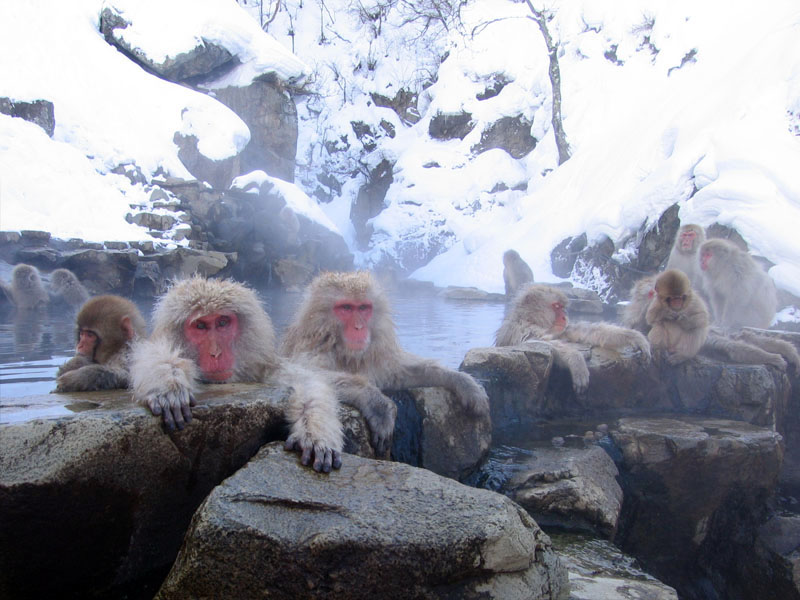
Japanese monkeys love Onsen hot springs.
B- Safari Animals (and Others)
There is no Kanji for animals that originate from places that are very far away from Japan, such as safari animals or those from Oceania. They’re typically expressed in Katakana as loanwords or named in Japanese after their characteristics.
Some animals—such as elephants, tigers, and leopards—have Kanji because they’re indigenous to Asian countries (China, India, etc.), and they became known to Japan through trading. Such Kanji were directly imported from the Chinese language, but the names (phonetic readings) are original to Japanese.
| English | Kanji | Hiragana / Katakana | Reading |
| “elephant” | 象 | ゾウ | zō |
| “giraffe” | ー | キリン | kirin |
| “lion” | ー | ライオン | raion |
| “tiger” | 虎 | トラ | tora |
| “panda bear” | ー | パンダ | panda |
| “zebra” | ー | シマウマ | shimauma*literally “striped horse” in Japanese. |
| “hippopotamus” | ー | カバ | kaba |
| “rhinoceros” | ー | サイ | sai |
| “ostrich” | ー | ダチョウ | dachō*It means “camel bird” in Japanese. |
| “baboon” | ー | ヒヒ | hihi |
| “hyena” | ー | ハイエナ | haiena |
| “cheetah” | ー | チーター | chītā |
| “leopard” | 豹 | ヒョウ | hyō |
| “koala bear” | ー | コアラ | koara |
| “kangaroo” | ー | カンガルー | kangarū |
| “camel” | ー | ラクダ | rakuda |

The キリン (kirin), or “giraffe,” was named after the Chinese dragon-like mythical animal called 麒麟 (qílín).
4. Sea Animals
A recent study revealed that there are about 34,000 species of sea animals living in the oceans near Japan, including everything from plankton to mammals. This means that about 13.5% of all confirmed marine life abound in less than 1% of the world’s ocean.
As a country blessed with lots of ocean, Japan has an abundance of words related to fish, called 魚 さかな (sakan), and sea animals. However, most of their Kanji are difficult, so Hiragana and Katakana are more commonly used to express their names.
Again, loanwords are used for sea animals that are not indigenous to Japan, such as ペンギン (pengin), or “penguin.”
| English | Kanji | Hiragana / Katakana | Reading |
| “whale” | 鯨 | くじら | kujira |
| “dolphin” | 海豚 | イルカ | iruka |
| “shark” | 鮫 | サメ | same |
| “seal” | 海豹 | アザラシ | azarashi |
| “sealion” | 海馬 | トド | todo |
| “penguin” | ー | ペンギン | pengin |
| “sea turtle” | 海亀 | うみがめ | umigame *literally “sea turtle” in Japanese |
| “jellyfish” | 海月 | くらげ | kurage |
| “pufferfish” | 河豚 | ふぐ | fugu |
| “octopus” | 蛸 | たこ | tako |
| “squid” | 烏賊 | いか | ika |
| “crab” | 蟹 | かに | kani |
| “shrimp” / “prawn” | 海老 | えび | ebi |
| “shell” | 貝 | かい | kai |
| “starfish” | 人手 | ヒトデ | hitode * literally “human hand” in Japanese |
You can also hear the pronunciation of these words (and more) in our vocabulary list Marine Animals & Fish.

鮫 サメ (same) – “shark”
5. Bugs and Insects
As with sea animals, there is a lot of vocabulary related to bugs and insects in Japan. Most of their Kanji are very difficult, so Hiragana and Katakana are more commonly used to express their names.
Considering the abundance of mountains and forests in Japan, it’s said that there could be as many as 100,000 insect species in the country. It’s possible that only about 10,000 of these species have been published in books.
Below are the names of some well-known bugs and insects that are commonly seen in Japan.
| English | Kanji | Hiragana / Katakana | Reading |
| “bugs” / “insects” | 虫 | むし | mushi |
| “bee” | 蜂 | ハチ | hachi |
| “fly” | 蠅 | ハエ | hae |
| “mosquito” | 蚊 | カ | ka |
| “butterfly” | 蝶 | チョウ | chō |
| “moth” | 蛾 | ガ | ga |
| “cicada” | 蝉 | セミ | semi |
| “dragonfly” | 蜻蛉 | トンボ | tonbo |
| “ant” | 蟻 | アリ | ari |
| “spider” | 蜘蛛 | クモ | kumo |
| “ladybug” | 天道虫 | てんとうむし | tentōmushi |
| “beetle” | 甲虫 | かぶとむし | kabutomushi |
| “grasshopper” | 飛蝗 | バッタ | batta |
| “mantis” | 蟷螂 | カマキリ | kamakiri |

てんとう虫 (tentōmushi) – “ladybug”
6. Birds
Thanks to the wealth of nature in Japan, the country is home to a diverse range of birds. There are 658 species of birds here, 22 of which are foreign.
Despite the rich variety of birds in Japan, the ones we see most often are pigeons, crows, sparrows, and swallows. In Japan, swallows are said to be “summer birds.” This is because seeing them is a sign that summer is coming, as swallows spend winter in the warmer southern areas (such as Taiwan, the Philippines, and Malaysia) before flying back to Japan in spring to raise their chicks.
There are also Japanese superstitions related to birds. For example, it’s believed that sparrows bring good luck and that crows bring bad luck.
| English | Kanji | Hiragana / Katakana | Reading |
| “bird” | 鳥 | とり | tori |
“small (baby) bird” | 小鳥 | ことり | kotori |
| “pigeon” | 鳩 | はと | hato |
| “crow” | 烏 | からす | karasu |
| “sparrow” | 雀 | すずめ | suzume |
| “swallow” | 燕 | つばめ | tsubame |
| “seagull” | ー | かもめ | kamome |
| “eagle” | 鷲 | わし | washi |
| “crane” | 鶴 | つる | tsuru |
| “owl” | 梟 | ふくろう | fukurō |

The フクロウ (fukurō), or “owl,” is considered an animal of good omen.
7. Reptiles
In Japanese, reptiles are called 爬虫類 はちゅうるい (hachūrui).
There are 142 reptile species in Japan (19 species of newt, 39 species of frog, 10 species of turtle, 32 species of lizard, and 42 species of snake). Some reptiles, such as turtles and snakes, are popular as pets in Japan.
Reptiles are normally expressed in Katakana, even though most of them have Kanji.
| English | Kanji | Hiragana / Katakana | Reading |
| “turtle” | 亀 | カメ | kame |
| “crocodile” / “alligator” | 鰐 | ワニ | wani |
| “snake” | 蛇 | ヘビ | hebi |
| “frog” | 蛙 | カエル | kaeru |
| “lizard” | 蜥蜴 | トカゲ | tokage |
| “chameleon” | ー | カメレオン | kamereon |

ワニ (wani) – “crocodile” / “alligator”
8. Animal Body Parts
Now that you’ve learned the names of several different animals in Japanese, you should take some time to study the words for animal body parts. Keep in mind that many of the basic body parts listed below are the same for humans and animals. You can learn even more useful words, along with their pronunciation, on our vocabulary list Body Parts in Japanese!
| English | Kanji | Hiragana / Katakana | Reading |
| “horn” | 角 | つの | tsuno |
| “beak” | 口ばし | くちばし | kuchibashi |
| “wing” (birds) | 翼 | つばさ | tsubasa |
| “wing” (insects) / “feather” | 羽 | はね | hane |
| “tusk” | 牙 | きば | kiba |
| “mane” | 立て髪 | たてがみ | tategami |
| “fur” | 毛皮 | けがわ | kegawa |
| “claw” | 鉤爪 | かぎつめ | kagitsume |
| “tail” | 尾 / 尻尾 | お / しっぽ | o / shippo |
| “hoof” | 蹄 | ひづめ | hizume |
| “fin” | 鰭 | ひれ | hire |
| “gill” | 鰓 | えら | era |
| “scale” | 鱗 | うろこ | uroko |

角 つの (tsuno) – “horn”
9. Animal Sounds
The Japanese language has a wide range of onomatopoeia, and animal sounds are one of the most common 擬声語 (gisei-go), or “animate phonomimes” we use.
Here are the sounds animals make in Japanese:
| Animal | Katakana | Reading |
| dog | ワンワン | wanwan |
| cat | ニャーニャー | nyānyā |
| mouse | チューチュー | chūchū |
| pig | ブーブー | būbū |
| sheep | メーメー | mēmē |
| cow | モーモー | mōmō |
| horse | ヒヒーン | hihīn |
| small bird | チュンチュン | chunchun |
| crow | カーカー | kākā |
| chicken | コケコッコー | kokekokkō |
| pigeon | ポッポー | poppō |
| owl | ホーホー | hōhō |
| lion | ガオー | gaō |
| elephant | パオーン | paōn |
| cicada | ミーンミーン | mīnmīn |

Lions say ガオー (Gaō) in Japanese.
10. Animal-Related Proverbs
There are many Japanese proverbs and sayings that mention animals. Here are some of the most common ones:
- 猿も木から落ちる。
Saru mo ki kara ochiru.
“Even monkeys fall off trees.”
Meaning: Even Homer sometimes nods. / Even someone who is the best at what they do can make mistakes.
Example:
気にすることないよ。猿も木から落ちると言うし、誰でも失敗することがあるよ。
Ki ni suru koto nai yo. Saru mo ki kara ochiru to iu shi, dare de mo shippai suru koto ga aru yo.
“Don’t worry. It says ‘Even monkeys fall off trees,’ and anyone can make mistakes.”
- 飼い犬に手を噛まれる
Kaiinu ni te o kamareru
“To have one’s hand bitten by one’s own dog”
Meaning: To be betrayed by one’s trusted follower
Example:
ずっと面倒をみていた部下に裏切られて、飼い犬に手を噛まれた気分だ!
Zutto mendō o mite ita buka ni uragirarete, kaiinu ni te o kamareta kibun da!
“I feel like I got my hand bitten by my dog, as my subordinate, whom I have been taking care of, betrayed me!”
- 猫の手も借りたい
Neko no te mo karitai
“Wanting even the help of a cat”
Meaning: Being extremely busy, so that you need every little bit of help you can get
Example:
昨日は猫の手も借りたいほど、とても忙しかったです。
Kinō wa neko no te mo karitai hodo, totemo isogashikatta desu.
“Yesterday was so busy that I even wanted to get help from a cat.”
- 捕らぬ狸の皮算用
Toranu tanuki no kawazanyō
“Counting fur of raccoon dogs which you haven’t caught yet”
Meaning: Don’t count your chickens before they hatch. / Do not count on something that has not yet happened. / Do not expect all your hopes to come true.
Example:
昇給とボーナスを期待して家を買うのは、捕らぬ狸の皮算用だよ。
Shōkyū to bōnasu o kitai shite ie o kau no wa, toranu tanuki no kawazanyō da yo.
“Buying a house because you expect a pay-raise and a bonus is like counting the fur of raccoon dogs which you haven’t caught yet.”
To learn more Japanese proverbs, please visit our blog post Japanese Proverbs – Gain Japanese Wisdom and Insight.

捕らぬ狸の皮算用
Toranu tanuki no kawazanyō
“counting fur of raccoon dogs which you haven’t caught yet” = “Don’t count your chickens before they hatch.”
11. Conclusion
In this article, we introduced Japanese animal words for a number of categories:
- Pets
- Farm animals
- Wild animals
- Sea animals
- Birds
- Insects
- Reptiles
In addition, we covered the most important animal body parts, Japanese animal sounds, and proverbs related to animals. If you happen to know of any other animal words, sounds, or idioms we didn’t include, please share them in the comments!
Do you want to continue learning about the Japanese language and culture? Then create your free lifetime account on JapanesePod101.com today! We provide a variety of free lessons designed to help improve your Japanese language skills. Also, with our Premium PLUS service, MyTeacher, you’ll have personal 1-on-1 coaching with your own private teacher.
If you want to increase your Japanese vocabulary even further, you’ll find the following articles quite useful:
- Guide to the Top 100+ Japanese Nouns
- Learn the Top 100 Essential Japanese Adjectives
- The 100+ Most Common Japanese Verbs
And there’s so much more! Learn Japanese faster (and enjoy every second of it) at JapanesePod101.com!
Before you go, let us know in the comments if there are any topics or situations you’d like to learn Japanese words for! We’d be glad to help, and we look forward to hearing from you.

The Most Useful Japanese Phone Phrases

Speaking on the phone can be stressful enough in your own language, let alone in a foreign language!
Even after you’re able to have face-to-face conversations with native speakers, you’ll find that communicating over the phone is rather difficult. Phone calls are different from in-person conversations in that you can’t rely on body gestures or facial expressions to help get your point across or to understand what the other person is trying to say.
Talking on the phone in Japanese may be especially difficult. You’ll need to memorize a specific set of Japanese phone phrases, as we use Honorific language, or 敬語 (Keigo), for most of our phone conversations. The exception is when we’re just having a casual chat with friends or family.
But don’t worry! There are only a few patterns to learn and you’ll see them all in this article from JapanesePod101.com.

Let’s learn some useful Japanese phone call phrases!
 Table of Contents
Table of Contents
- Picking up the Phone
- Introducing Yourself
- Stating the Reason for Your Call
- Asking to Speak to Someone
- Responding to the Caller / Asking Someone to Wait
- Leaving a Message
- Asking for Clarification
- Ending the Phone Call
- Sample Phone Conversations
- Conclusion
1. Picking up the Phone
First impressions are critical! Let’s start by looking at some Japanese phone call phrases you could use to answer the phone.
1. もしもし。
Romanization: Moshimoshi.
English: “Hello.”
This is the most common way to answer a phone call in Japanese.
もし もし (moshimoshi) comes from the word 申す もうす (mōsu), which is “to say” in a humble manner. You can also add the word はい (hai), meaning “yes,” in front:
- はい、もしもし。 (Hai, moshimoshi.) – “Yes, hello.”
Moshimoshi is typically used by the receiver to answer the phone, but the caller may also say moshimoshi before continuing in order to make sure the other person can hear.
2. はい、___です。
Romanization: Hai, ___ desu.
English: “Yes, this is ___.” [Polite]
When you pick up the phone, you say はい (hai), meaning “yes,” and then state who is speaking.
To give your name, make sure to place the general and polite predicate -です (-desu) at the end. Keep in mind that you should normally give your family name (as opposed to only your first name) when answering the phone in Japanese.
3. はい、___でございます。
Romanization: Hai, ___ de gozaimasu.
English: “Yes, this is ___.” [Very polite]
This phrase is very polite and often used in business contexts, such as when answering a company phone.
4. どちら様でしょうか。
Romanization: Dochira-sama deshō ka.
English: “Who is this?” [Very polite]
This phrase can be used later on when you want to know who’s calling, but some people ask this when they first receive a call. You can make the phrase even more polite by placing this in front:
- 失礼ですが… (Shitsurei desu ga…) – “Excuse me, but…”
Examples
- はい、もしもし、田中です。
Hai, moshimoshi, Tanaka desu.
“Yes, hello, Tanaka is speaking.”
- はい、ABC株式会社でございます。
Hai, ABC kabushikigaisha de gozaimasu.
“Yes, this is ABC company.”
- もしもし、鈴木です。どちら様でしょうか。
Moshimoshi, Suzuki desu. Dochira-sama deshō ka.
“Hello, this is Suzuki. Who’s calling?”

もしもし (moshimoshi) – “hello” on the phone
2. Introducing Yourself
When you make a phone call in Japanese, it’s expected that you introduce yourself by stating your name and/or the company you’re representing.
1. いつもお世話になっております。
Romanization: Itsumo o-sewa ni natte orimasu.
English: “Thank you for always being favorable.” / “It has always been a pleasure to work with you.”
Literally: “You always take care of me.”
This is a common Japanese phrase that does not translate well into other languages. It’s most often used in business communications, and it can be said by either the caller or the receiver.
- → To learn more untranslatable Japanese words, please see our article Untranslatable Japanese Words: Let’s Talk Like a Native!
2. 私は___です。
Romanization: Watashi wa ___ desu.
English: “This is ___.” [Polite]
This phrase literally means, “I am ___.” It’s a general and polite way to introduce yourself over the phone.
If you’re calling a close friend or family member, you can say:
- ___ だよ。 (___ da yo.) – “It’s ___.”
In this case, you can omit the subject (私 watashi).
3. 私は___と申します。
Romanization: Watashi wa ___ to mōshimasu.
English: “This is ___.” [Very polite]
This is a formal expression that denotes humbleness and respect. It’s often used in business situations and other official contexts.
4. 私は___の___です/と申します。
Romanization: Watashi wa ___ no ___ desu / to mōshimasu.
English: “I am ___ from ___.”
This is the phrase you would use if you were calling as a business person or staff member of a company/organization. In Japanese culture, the group is often considered more important than the individual (collectivism) and a business person or staff member is seen as a representative of their company. Thus, telling where you belong is important.
Examples
- いつもお世話になっております。本田です。
Itsumo o-sewa ni natte orimasu. Honda desu.
“Thank you for your continued support. This is Honda.”
- もしもし、私だよ。
Moshimoshi, watashi da yo.
“Hello, it’s me.” [Very casual]
- 私はXYZ株式会社の山本と申します。
Watashi wa XYZ kabushikigaisha no Yamamoto to mōshimasu.
“This is Yamamoto from XYZ company.”
3. Stating the Reason for Your Call
Once the greetings and introductions are over, it’s time to let the other person know why you’re calling. Below are some phone phrases in Japanese for making reservations, asking for information, and more!
1. ___ の予約をしたくて電話しました。
Romanization: ___ no yoyaku o shitakute denwa shimashita.
English: “I’m calling because I’d like to make a reservation for ___.”
This Japanese phone call phrase is useful for booking a table at a restaurant, hair salon, etc.
Vocabulary:
- 予約をする (yoyaku o suru) – “to book” / “to make a reservation”
- 電話する (denwa suru) – “to call”
2. ___について確認したくて電話しました。
Romanization: ___ni tsuite kakunin shitakute denwa shimashita.
English: “I’m calling because I’d like to confirm about ___.”
You can use this phrase when you want to check something. For example, you might say this while calling customer service to see if you can return an item or while calling a restaurant to see if you can change your reservation.
Vocabulary
- 確認する (kakunin suru) – “to check” / “to confirm”
3. ___のサポートが必要なので電話しました。
Romanization: ___ no sapōto ga hitsuyō na node denwa shimashita.
English: “I’m calling because I need support for ___.”
This phrase is useful for situations where you need some support. You might say this when calling a help center for software services or talking with a customer service representative for info on setting up a gadget.
4. 着信があったので折り返し電話しました。
Romanization: Chakushin ga atta node orikaeshi denwa shimashita.
English: “I received an incoming call, so I called back.”
When you call someone back, just give your name and use this phrase.
Vocabulary
- 着信 (chakushin) – “incoming call”
- 折り返し電話する (orikaeshi denwa suru) – “call back”
Examples
- もしもし、マッサージの予約をしたくて電話しました。
Moshimoshi, massāji no yoyaku o shitakute denwa shimashita.
“Hello, I’m calling because I’d like to make a booking for a massage.”
- 自然災害によるキャンセル料について確認したくて電話しました。
Shizen saigai ni yoru kyanseruryō ni tsuite kakunin shitakute denwa shimashita.
“I’m calling because I’d like to check about a cancelation fee due to a natural disaster.”
- 着信があったので折り返し電話したよ。何だった?
Chakushin ga atta node orikaeshi denwa shita yo. Nan datta?
“I received an incoming call and I’m calling you back. What was it?” [Very casual]

着信があったので折り返し電話しました。(Chakushin ga atta node orikaeshi denwa shimashita.)
“I received an incoming call, so I called back.”
4. Asking to Speak to Someone
What if the person who answers the phone is not who you intended to call? You can use the following phrases to ask if you can be transferred to the right person.
1. ___ さんをお願いします。
Romanization: ___-san o onegai shimasu.
English: “Mr./Ms. ___, please.”
This is a useful phrase that’s simple yet still polite. By stating the name of the person you want to speak to, it implies to the receiver that you’d like to be connected to him/her.
さん (san) is a general and polite Japanese honorific (敬称 keishō) that is placed after one’s name. It’s normally used after a family name (苗字 myōji / 姓 sei) in formal settings, but it can also be used after a given name (名 mei).
If we’re calling someone of a higher rank than us or just want to show more respect, we use 様 (sama). For example, we might use this when calling customers, clients, or guests.
2. ___ さんはいますか。
Romanization: ___-san wa imasu ka.
English: “Is Mr./Ms. ___ there?” [Polite]
This is a very simple and casually polite phrase.
3. ___ さんはいらっしゃいますか。
Romanization: ___-san wa irasshaimasu ka.
English: “Is Mr./Ms. ___ there?” [Very polite]
This phrase is even more polite and respectful, which makes it ideal for use in formal situations. Use this phrase if you’re calling someone who is superior to you or deserving of great respect.
4. ___ さんにつないでいただけますか。
Romanization: ___-san ni tsunaide itadakemasu ka.
English: “Could you connect with Mr./Ms. ___?”
This is another polite way you can ask to speak to someone.
Examples
- 吉田と申します。原田様はいらっしゃいますか。
Yoshida to mōshimasu. Harada-sama wa irasshaimasu ka.
“I am Yoshida. Is Mr. Harada there?” [Very polite and respectful]
- もしもし、お父さん?お母さんいる?
Moshimoshi, o-tō-san? O-kā-san iru?
“Hello, Dad? Is Mom there?” [Very casual]
- 人事部の中田さんにつないでいただけますか。
Jinjibu no Nakata-san ni tsunaide itadakemasu ka.
“Could you please connect me with Mr. Nakata of the Human Resources Department?”
5. Responding to the Caller / Asking Someone to Wait
If you’re the receiver and have been asked to connect someone, you may need to put the caller on hold for a moment and inform them if the person they’re inquiring after is not available. Here are some phrases you can use to do so politely:
1. 申し訳ございません、___はただ今外出中です。
Romanization: Mōshiwake gozaimasen, ___ wa tadaima gaishutsuchū desu.
English: “I’m sorry, ___ is out of office now.”
This phrase is often used in business situations. It is proper Japanese phone call etiquette to apologize to the caller when the person they’re asking for is not in office.
In Japanese business settings, you don’t use honorifics (such as さん san) when saying a colleague’s name.
2. ___は本日お休みをいただいております。
Romanization: ___ wa honjitsu o-yasumi o itadaite orimasu.
English: “___ is off today.” [Very polite]
This is a humbly respectful and very polite expression to use when the person they want is absent.
3. 確認いたします、少々お待ちください。
Romanization: Kakunin itashimasu, shōshō o-machi kudasai.
English: “I will check, please hold for a moment.”
When you need to check something and want the caller to wait for a moment, you can use this polite phrase.
4. ___へおつなぎいたしますので、少々お待ちくださいませ。
Romanization: ___ e o-tsunagi itashimasu node, shōshō o-machi kudasai mase.
English: “I will put you through to ___, please hold for a moment.”
You would use this phrase before transferring the caller to someone.
Examples
- 申し訳ございません、山田は本日お休みをいただいております。
Mōshiwake gozaimasen, Yamada wa honjitsu o-yasumi o itadaite orimasu.
“I’m sorry, Yamada is off today.”
- 確認するね、ちょっと待って。
Kakunin suru ne, chotto matte.
“I’ll check, one moment.” [Very casual]
- 上田へおつなぎいたしますので、少々お待ちくださいませ。
Ueda e o-tsunagi itashimasu node, shōshō o-machi kudasai mase.
“I will transfer you to Ueda, please hold for a moment.”

少々お待ちください。 (Shōshō o-machi kudasai) – “Please wait a moment.”
6. Leaving a Message
Especially during a business phone call, you might need to leave a message if the person you’re trying to reach is unavailable. Below are a few different ways you could do this.
1. 伝言をお願いできますか。
Romanization: Dengon o onegai dekimasu ka.
English: “Can I leave a message?”
Use this simple phrase when you want to leave a message.
Vocabulary
- 伝言 (dengon) – “a message”
2. ___さんに、私から電話があったと伝えていただけますか。
Romanization: ___-san ni, watashi kara denwa ga atta to tsutaete itadakemasu ka.
English: “Could you please tell Mr./Ms. ___ that I called?”
When you just want to let the person know that you have called, this phrase is useful and polite.
3. ___さんに、私へ折り返し電話するようお伝えいただけますか。
Romanization: ___-san ni, watashi e orikaeshi denwa suru yō o-tsutae itadakemasu ka.
English: “Could you please tell Mr./Ms. ___ to call me back?”
This is a polite way to ask for a call back.
Examples
- 山口さんへ伝言をお願いできますか。
Yamaguchi-san e dengon o onegai dekimasu ka.
“Could you give a message to Mr. Yamaguchi?”
- まゆみに、私から電話があったと伝えておいてね。
Mayumi ni, watashi kara denwa ga atta to tsutaete oite ne.
“Can you tell Mayumi that I called?” [Very casual]
- 中村さんに、明日私へ折り返し電話するようお伝えいただけますか。
Nakamura-san ni, ashita watashi e orikaeshi denwa suru yō o-tsutae itadakemasu ka.
“Could you please tell Mr. Nakamura to call me back tomorrow?”
7. Asking for Clarification
As a non-native speaker, you might need to ask for clarification at some point during your Japanese phone call conversation. There are a few polite phrases you can use.
1. すみません、もう一度言ってください。
Romanization: Sumimasen, mō ichi-do itte kudasai.
English: “I’m sorry, could you repeat again?”
If you can’t hear what the other person is saying, you can use this phrase to ask them to repeat.
Vocabulary
- すみません (sumimasen) – “sorry” / “excuse me”
- もう一度 (mō ichi-do) – “once again”
2. すみません、聞こえにくいです。
Romanization: Sumimasen, kikoenikui desu.
English: “I’m sorry, but it’s hard to hear you.”
You can use this phrase to tell the other person that you’re not hearing them well.
3. 電波が悪いようです。
Romanization: Denpa ga warui yō desu.
English: “It seems there is a bad signal.”
If you’re experiencing a bad connection, you can use this phrase to inform the other person.
Vocabulary
- 電波 (denpa) – “electric wave,” but it usually refers to a cell phone signal
4. もう一度ゆっくりおっしゃってくださいますか。
Romanization: Mō ichi-do yukkuri osshatte kudasaimasu ka.
English: “Could you please say it again slowly?”
This is a very polite phrase you can use if you need them to repeat what they said more slowly.
Vocabulary
- おっしゃる (ossharu) – the respectful version of 言う (iu), meaning “say”
5. 確認のため繰り返しますと、…
Romanization: Kakunin no tame kurikaeshimasu to, …
English: “Let me repeat it to double check…”
Use this phrase when you want to double check something, or to make sure you or the receiver understand things correctly.
Vocabulary
- 確認 (kakunin) – “check” / “conform”
- 繰り返す (kurikaesu) – “repeat”
Examples
- すみません、聞こえにくいです。もう一度言ってください。
Sumimasen, kikoenikui desu. Mō ichi-do itte kudasai.
“I’m sorry, but it’s hard to hear you. Could you say that again?”
- ごめん、聞こえなかった。もう一度ゆっくり言ってくれる?
Gomen, kikoenakatta. Mō ichi-do yukkuri itte kureru?
“Sorry, I couldn’t hear you. Can you say that again slowly?” [Very casual]
- 確認のため繰り返しますと、私の電話番号は012334567です。
Kakunin no tame kurikaeshimasu to, watashi no denwa bangō wa 012334567 desu.
“Let me repeat it to double check…my phone number is 012334567.”

もう一度言ってください。 (Mō ichi-do itte kudasai.) – “Please repeat again.”
8. Ending the Phone Call
Finally, let’s go over a few different ways of ending a phone call in Japanese.
1. はい、わかりました。
Romanization: Hai, wakarimashita.
English: “Yes, I understood.”
This phrase can be used during the conversation, but saying it at the end shows that you understood the conversation as a whole. In casual conversations, you can replace はい (hai) with:
- うん (un) – “yeah”
2. かしこまりました。
Romanization: Kashikomarimashita.
English: “Understood.” / “Certainly.”
This phrase is a humble and very polite version of わかりました (wakarimashita). It’s often used in business situations as well as in communications toward customers and guests.
3. よろしくお願いいたします。
Romanization: Yoroshiku onegai itashimasu.
This is one of the most frequently used untranslatable Japanese phrases. We often use it in business settings, especially when closing a conversation or ending an email.
It literally translates as “Suitable favor please,” but it can have various meanings depending on the situation. For example:
- “Nice to meet you”
- “Best regards”
- “Favorably please”
- “Please take care of me”
In phone conversations, it’s used as a final greeting.
4. 失礼します。
Romanization: Shitsurei shimasu.
This is another common untranslatable Japanese phrase used in formal situations.
The literal translation is: “I do rude/impolite.” But when ending a phone call or leaving an office/meeting room, it means: “May I be excused.”
失礼いたします(shitsurei itashimasu) is even more polite.
Examples
- かしこまりました。では、失礼いたします。
Kashikomarimashita. Dewa, shitsurei itashimasu.
“Certainly. Please excuse me now.”
- うん、わかったよ。じゃあね。
Un, wakatta yo. Jā ne.
“Yeah, understood. Bye then.” [Very casual]
- 明日の会議の件かしこまりました。よろしくお願いいたします。
Ashita no kaigi no ken kashikomarimashita. Yoroshiku onegai itashimasu.
“I understood about the meeting tomorrow. Favorably please.”
9. Sample Phone Conversations
Now that we’ve introduced you to several useful phone call phrases, it’s time to see them in action. Below, you’ll find two sample phone conversations: one casual and one formal.
1 – Casual Conversation (Two Friends)
A:
もしもし、まりこ?
Moshimoshi, Mariko?
“Hello, Mariko?”
B:
もしもし、かなちゃん! どうしたの?
Moshimoshi, Kana-chan! Dō shita no?
“Hello, Kana! What’s up?”
A:
今週の土曜日空いてる?
Konshū no do-yōbi aite ru?
“Are you free on Saturday this weekend?”
B:
うん、午後からなら暇だよ。
Un, gogo kara nara hima da yo.
“Yeah, I’m free from the afternoon.”
A:
___の映画の無料券もらったから、一緒に行きたいと思って。どうかな?
___ no eiga no muryōken moratta kara, issho ni ikitai to omotte. Dō ka na?
“I got the free movie tickets for ___ and I’d like to go with you. What do you think?”
B:
ありがとう。いいね、見に行こう!
Arigatō. Ii ne, mi ni ikō!
“Thank you. That’s nice, let’s go watch!”
A:
じゃあ、2時に新宿駅東口で待ち合わせしよう。
Jā, ni-ji ni Shinjuku Eki higashiguchi de machiawase shiyō.
“Well, then let’s meet at the east exit of Shinjuku Station at two o’clock.”
B:
うん、わかった。土曜日の2時に新宿駅ね。
Un, wakatta. Do-yōbi no ni-ji ni Shinjuku Eki ne.
“Okay, noted. At Shinjuku Station at two o’clock on Saturday.”
A:
じゃあ土曜日にね。バイバイ。
Jā do-yōbi ni ne. Baibai.
“See you on Saturday, then. Bye.”
B:
うん、よろしくね。バイバイ。
Un, yoroshiku ne. Baibai.
“Yeah, thank you. Bye.”
2 – Formal Conversation (Calling a Client’s Office)
A:
はい、XYZ株式会社でございます。
Hai, XYZ kabushikigaisha de gozaimasu.
“Hello, this is XYZ company.”
B:
もしもし、いつもお世話になっております。私はABC株式会社の田中と申します。
Moshimoshi, itsumo o-sewa ni natte orimasu. Watashi wa ABC kabushikigaisha no Tanaka to mōshimasu.
“Hello, it’s always a pleasure to work with you. I am Tanaka from ABC company.”
A:
いつもお世話になっております。ご用件は何でしょうか。
Itsumo o-sewa ni natte orimasu. Go-yōken wa nan deshō ka.
“Thank you for your continued support, too. How can I help you?”
B:
国際部の上野さんにつないでいただけますか。
Kokusaibu no Ueno-san ni tsunaide itadakemasu ka.
“Could you connect me with Mr. Ueno of the International Department?”
A:
確認いたします、少々お待ちくださいませ。
Kakunin itashimasu, shōshō o-machi kudasai mase.
“I will check, please hold for a moment.”
— a minute later —
A:
申し訳ございません、上野はただ今外出中です。ご伝言を承りましょうか。
Mōshiwake gozaimasen, Ueno wa tadaima gaishutsuchū desu. Go-dengon o uketamawarimashō ka.
“I’m sorry, Ueno is out of office now. Would you like to leave a message?”
B:
はい、お願いします。送り状の件について確認したくて電話しました。上野さんに、明日私へ折り返し電話するようお伝えいただけますか。
Hai, onegai shimasu. Okurijō no ken ni tsuite kakunin shitakute denwa shimashita. Ueno-san ni, ashita watashi e orikaeshi denwa suru yō o-tsutae itadakemasu ka.
“Yes, please. I called because I’d like to check about the invoice. Could you please tell Mr. Ueno to call me back tomorrow?”
A:
かしこまりました。上野へ田中様からのご伝言をお伝えいたします。
Kashikomarimashita. Ueno e Tanaka-sama kara no go-dengon o o-tsutae itashimasu.
“Certainly. I will send the message from Mr. Tanaka to Ueno.”
B:
ありがごうございます。よろしくお願いいたします。では、失礼いたします。
Arigatō gozaimasu. Yoroshiku onegai itashimasu. Dewa, shitsurei itashimasu.
“Thank you. Please do so. May I be excused now?”
A:
お電話ありがとうございました。失礼いたします。
O-denwa arigatō gozaimashita. Shitsurei itashimasu.
“Thank you for calling. Goodbye.”
10. Conclusion
In this article, we introduced the most useful and frequently used Japanese phone call phrases. Once you master this list of polite expressions, you can make or receive your next call in Japanese with confidence—whether you’re chatting with a friend or getting info from a customer service rep.
If you would like to learn more about the Japanese language and pick up additional Japanese phrases for different situations, you’ll find a lot of helpful content on JapanesePod101.com. We provide a variety of free lessons designed to help improve your Japanese language skills.
Not sure where to start? Check out these articles:
- The 10 Most Useful Japanese Sentence Patterns
- Essential Business Japanese: Learn the Most Useful Phrases
- The 10 Most Useful Japanese Questions and Answers
And there’s so much more! Learn faster and enjoy studying Japanese at JapanesePod101.com!
Before you go, let us know in the comments if there’s a topic you’d like us to cover in a future article. What words, phrases, or cultural topics would you like to learn more about? We’d be glad to help, and we look forward to hearing from you!

Japanese Words for Beginners

You’ve just started studying Japanese? Then you should build a solid foundation by learning the easiest and most frequently used Japanese words for beginners!
Japanese dictionaries list anywhere from 55,000 to 82,000 words, though the number of words used per day by ordinary Japanese adults is said to be around 800-900 (or 1000-1200 words for university students).
Some linguists state that Japanese is one of the most difficult languages for native English speakers to learn. The Foreign Service Institute (FSI) has labeled Japanese a Category IV language, which is the most difficult level.
However, there are a few things about Japanese that English speakers find easy. While it can take forever to master the Kanji system for reading and writing, learning how to listen and speak in daily conversations isn’t as difficult as you may think! You don’t have to worry about whether to use singular or plural forms, which article to add before a noun, or how to conjugate verbs (I am / she is / they are). These concepts do not exist in the Japanese language!
In this article, JapanesePod101.com will introduce the most useful Japanese beginner words that are used in everyday situations.

日本語の初級単語を学ぼう。
Nihon-go no shokyū tango o manabō.
“Let’s learn Japanese beginner words.”
 Table of Contents
Table of Contents
- Pronouns – 代名詞 (Daimeishi)
- Numbers – 数字 (Sūji)
- Nouns – 名詞 (Meishi)
- Verbs – 動詞 (Dōshi)
- Adjectives – 形容詞 (Keiyōshi)
- Conjunctions – 接続詞 (Setsuzokushi)
- Other – その他 (Sonota)
- Conclusion
1. Pronouns – 代名詞 (Daimeishi)
Pronouns are a major component of Japanese vocabulary, so learning them early on in your studies is a great idea. To give you a headstart, here’s a list of the most important pronouns in Japanese.
Personal Pronouns – 人称代名詞 (Ninshō daimeishi)
| English | Kanji | Hiragana | Reading |
| I (female/casual; unisex/formal) | 私 | わたし | watashi |
| I (male/casual) | 僕 | ぼく | boku |
| you (general) | ー | あなた | anata |
| you (casual) | 君 | きみ | kimi |
| he | 彼 | かれ | kare |
| she | 彼女 | かのじょ | kanojo |
| they | 彼ら | かれら | kare-ra |
Examples:
- 彼と彼女は同じ大学の学生です。
Kare to kanojo wa onaji daigaku no gakusei desu.
“He and she are students of the same university.”
- これは私からあなたへのプレゼントです。
Kore wa watashi kara anata e no purezento desu.
“This is a present for you from me.”
- 君と僕は同い年だ。
Kimi to boku wa onaidoshi da.
“You and I are the same age.”
Demonstrative Pronouns – 指示代名詞 (Shiji daimeishi)
| English | Kanji | Hiragana | Reading |
| this (close to the speaker) | ー | これ | kore |
| it / that (close to the listener) | ー | それ | sore |
| that (far from both the speaker and the listener) | ー | あれ | are |
| these (close to the speaker) | ー | これら | kore-ra |
| they / those (close to the listener) | ー | それら | sore-ra |
| those (far from both the speaker and the listener) | ー | あれら | are-ra |
Examples:
- それを取ってください。そう、それです。
Sore o totte kudasai. Sō, sore desu.
“Please pass me that [close to the listener]. Yes, that’s it.”
- これは私のです。あれはあなたのです。
Kore wa watashi no desu. Are wa anata no desu.
“This is mine. That is yours.”
- これらの作品をどう思いますか。
Kore-ra no sakuhin o dō omoimasu ka.
“What do you think about these works?””What do you think about these works?”
For more details about Japanese pronouns, please see Your Ultimate Guide to Japanese Pronouns.
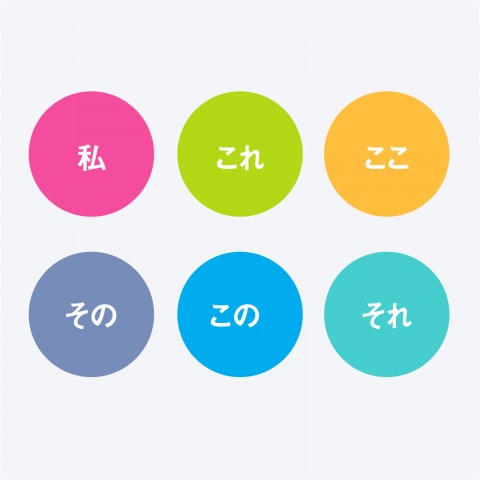
これは私の本です。
Kore wa watashi no hon desu.
“This is my book.”
Interrogative Pronouns – 疑問詞 (Gimonshi)
| English | Kanji | Hiragana | Reading |
| what | 何 | なに | nani |
| who | 誰 | だれ | dare |
| where | ー | どこ | doko |
| which | ー | どの | dono |
| why | ー | なぜ/どうして | naze / dōshite |
| when | ー | いつ | itsu |
| how much | ー | いくら | ikura |
| how many | ー | いくつ | ikutsu |
| how | ー | どうやって | dō yatte |
Examples:
- これは何ですか。これとあれは何が違いますか。
Kore wa nan desu ka. Kore to are wa nani ga chigaimasu ka.
“What is this? What is the difference between this and that?”
- 誰とどこに行くの?いつ帰る?
Dare to doko ni iku no? Itsu kaeru?
“With whom and where are you going? When will you come back?”
- あれはいくらですか。いくつ買えば割引になりますか。
Are wa ikura desu ka. Ikutsu kaeba waribiki ni narimasu ka.
“How much is that? How many should I buy to get a discount?”
For more information about asking and answering questions in Japanese, check out The 10 Most Useful Japanese Questions and Answers.
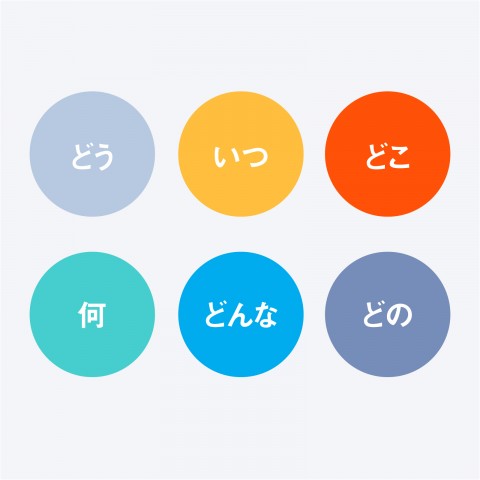
一番近い地下鉄の駅はどこですか。
Ichi-ban chikai chikatetsu no eki wa doko desu ka.
“Where is the nearest subway station?”
2. Numbers – 数字 (Sūji)
Japanese numbers are very simple.
The names of all numbers in Japanese consist of the ten basic numbers shown below, except for certain units such as: hundred (百 hyaku), thousand (千 sen), ten-thousand (万 man), etc. There are no particular names like “eleven,” “twelve,” “thirty,” or “fifty.”
For example:
- Eleven in Japanese is read as jū-ichi, which is literally “ten-one.”
- Fifteen in Japanese is read as jū-go, which is literally “ten-five.”
- Thirty-five in Japanese is read as san-jū go, which is literally “three-ten-five.”
| English | Kanji | Hiragana | Reading |
| one | 一 | いち | ichi |
| two | 二 | に | ni |
| three | 三 | さん | san |
| four | 四 | し/ よん | shi / yon |
| five | 五 | ご | go |
| six | 六 | ろく | roku |
| seven | 七 | しち / なな | shichi / nana |
| eight | 八 | はち | hachi |
| nine | 九 | く / きゅう | ku / kyū |
| ten | 十 | じゅう | jū |
Examples:
- 彼は今年27才になります。
Kare wa kotoshi ni-jū nana-sai ni narimasu.
“He will be 27 years old this year.”
- このペンは95円で、そのえんぴつは70円です。
Kono pen wa kyū-jū go-en de, sono enpitsu wa nana-jū-en desu.
“This pen is ninety-five yen and the pencil is seventy yen.”
- 私は英語を5年、イタリア語を1年勉強しています。
Watashi wa Eigo o go-nen, Itaria-go o ichi-nen benkyō shite imasu.
“I have been studying English for five years and Italian for one year.”
To learn more about counting in Japanese, please check out Japanese Numbers: Let’s Master the Basic Japanese Numbers!

There are several variations of Japanese counters, each one used according to what’s being counted.
Birds = 1羽 (ichi-wa)、2羽(ni-wa), Books = 1冊(issatsu)、2冊(ni-satsu), Shoes = 1足(issoku)、2足(ni-soku)
3. Nouns – 名詞 (Meishi)
Our next set of basic Japanese words consists of frequently used nouns. When used together with verbs, nouns allow you to form complete sentences and effectively express yourself—in a pinch, you can even use them alone in order to convey a basic idea!
Time
| English | Kanji | Hiragana | Reading |
| time | 時間 | じかん | jikan |
| minute | 分 | ふん / ぷん | fun / pun |
| o’clock | 時 | じ | ji |
| day | 日 | にち / ひ / び | nichi / hi / bi |
| month | 月 | つき / げつ / がつ | tsuki / getsu / gatsu |
| year | 年 | ねん | nen |
| morning time (until noon) | 午前 | ごぜん | gozen |
| afternoon | 午後 | ごご | gogo |
| morning | 朝 | あさ | asa |
| noon / noontime / daytime | 昼 | ひる | hiru |
| early evening | 夕方 | ゆうがた | yūgata |
| evening / night | 夜 | よる | yoru |
| Monday | 月曜日 | げつようび | getsu-yōbi |
| Tuesday | 火曜日 | かようび | ka-yōbi |
| Wednesday | 水曜日 | すいようび | sui-yōbi |
| Thursday | 木曜日 | もくようび | moku-yōbi |
| Friday | 金曜日 | きんようび | kin-yōbi |
| Saturday | 土曜日 | どようび | do-yōbi |
| Sunday | 日曜日 | にちようび | nichi-yōbi |
Examples:
- 私は月曜日から金曜日は朝6時に起きます。
Watashi wa getsu-yōbi kara kin-yōbi wa asa roku-ji ni okimasu.
“I get up at six o’clock from Monday to Friday.”
- 彼は1年に3ヶ月仕事で海外へ行きます。
Kare wa ichi-nen ni san-kagetsu shigoto de kaigai e ikimasu.
“He goes abroad for three months a year for work.”
- 彼女は夜遅くに寝ますが、朝は早く起きます。
Kanojo wa yoru osoku ni nemasu ga, asa wa hayaku okimasu.
“She goes to bed late at night, but gets up early in the morning.”
People
| English | Kanji | Hiragana | Reading |
| parent | 親 | おや | oya |
| parents | 両親 | りょうしん | ryōshin |
| father / dad | 父 / お父さん | ちち / おとうさん | chichi / o-tō-san |
| mother / mom | 母 / お母さん | はは / おかあさん | haha / o-kā-san |
| older brother | 兄 | あに | ani |
| older sister | 姉 | あね | ane |
| younger brother | 弟 | おとうと | otōto |
| younger sister | 妹 | いもうと | imōto |
| grandfather / grandpa | 祖父 / お爺ちゃん | そふ / おじいちゃん | sofu / o-jii-chan |
| grandmother / grandma | 祖母 / お婆ちゃん | そぼ / おばあちゃん | sobo /o-bā-chan |
| uncle | 伯父(叔父) | おじ | oji |
| aunt | 伯母(叔母) | おば | oba |
| cousin | 従兄弟 | いとこ | itoko |
| grandchild | 孫 | まご | mago |
| Mr. / Mrs. / Ms.(put after a name to refer to a person politely) | ー | さん | -san |
| Mr. / Mrs. / Ms.(put after a name to refer to a person respectfully) | 様 | さま | -sama |
| work | 仕事 | しごと | shigoto |
| employee of a company | 会社員 | かいしゃいん | kaishain |
| doctor | 医者 | いしゃ | isha |
| lawyer | 弁護士 | べんごし | bengoshi |
| teacher | 先生 / 教師 | せんせい / きょうし | sensei / kyōshi |
| student | 生徒 / 学生 | せいと / がくせい | seito / gakusei |
Examples:
- 私の父は弁護士で、母は高校の教師です。
Watashi no chichi wa bengoshi de, haha wa kōkō no kyōshi desu.
“My father is a lawyer and my mother is a highschool teacher.”
- 彼には兄と妹がいます。
Kare ni wa ani to imōto ga imasu.
“He has an older brother and a younger sister.”
- 彼女の両親は大企業で会社員をしています。
Kanojo no ryōshin wa daikigyō de kaishain o shite imasu.
“Her parents are employees of a large company.” / “Her parents work for a large company.”
Places Around Town
| English | Kanji | Hiragana/Katakana | Reading |
| town / city | 町 / 街 | まち | machi |
| hospital | 病院 | びょういん | byōin |
| school | 学校 | がっこう | gakkō |
| supermarket | ー | スーパーマーケット | sūpāmāketto |
| store | 店 | みせ | mise |
| post office | 郵便局 | ゆうびんきょく | yūbinkyoku |
| city/town hall | (市/区)役所 | (し/く)やくしょ | (shi / ku) yakusho |
| station | 駅 | えき | eki |
Examples:
- 私の町には、駅のとなりに大きな病院があります。
Watashi no machi ni wa, eki no tonari ni ōkina byōin ga arimasu.
“There is a big hospital next to the station in my town.”
- この道をまっすぐ行くと市役所があります。
Kono michi o massugu iku to shiyakusho ga arimasu.
“Go straight on this road and you will find the city hall.”
- 日曜日は、郵便局は休みです。
Nichi-yōbi wa, yūbinkyoku wa yasumi desu.
“The post office is closed on Sundays.”
School / Office Essentials
| English | Kanji | Hiragana/Katakana | Reading |
| pen | ー | ペン | pen |
| pencil | 鉛筆 | えんぴつ | enpitsu |
| eraser | 消しゴム | けしゴム | keshigomu |
| notebook | ー | ノート | nōto |
| textbook | 教科書 | きょうかしょ | kyōkasho |
| computer | ー | コンピューター | konpyūtā |
| internet | ー | インターネット | intānetto |
| wi-fi | ー | ワイファイ | waifai |
Examples:
- ワイファイのパスワードは何ですか。
Waifai no pasuwādo wa nan desu ka.
“What is the wi-fi password?”
- 彼の学校は紙の教科書を使わずコンピューターを使います。
Kare no gakkō wa kami no kyōkasho o tsukawazu konpyūtā o tsukaimasu.
“His school does not use paper textbooks, but computers.”
- 試験では、鉛筆と消しゴムのみ使用できます。
Shiken de wa, enpitsu to keshigomu nomi shiyō dekimasu.
“Only pencils and erasers can be used in the exam.”
Body Parts
| English | Kanji | Hiragana/Katakana | Reading |
| head | 頭 | あたま | atama |
| face | 顔 | かお | kao |
| eye | 目 | め | me |
| nose | 鼻 | はな | hana |
| mouth | 口 | くち | kuchi |
| ear | 耳 | みみ | mimi |
| neck | 首 | くび | kubi |
| body | 体 | からだ | karada |
| shoulder | 肩 | かた | kata |
| back | 背中 | せなか | senaka |
| chest / breast | 胸 | むね | mune |
| belly / abdomen | 腹 / お腹 | はら / おなか | hara / onaka |
| arm | 腕 | うで | ude |
| hand | 手 | て | te |
| finger | 指 | ゆび | yubi |
| leg | 足 | あし | ashi |
Examples:
- 目と鼻は顔の重要な部位です。
Me to hana wa kao no jūyō na bui desu.
“The eyes and nose are important parts of the face.”
- 彼は事故で足を骨折しました。
Kare wa jiko de ashi o kossetsu shimashita.
“He broke his leg in the accident.”
- 今日は朝からお腹が痛い。
Kyō wa asa kara onaka ga itai.
“I have abdominal pain from the morning today.”
6. Food
| English | Kanji | Hiragana/Katakana | Reading |
| meat | 肉 | にく | niku |
| vegetable | 野菜 | やさい | yasai |
| fruit | 果物 | くだもの | kudamono |
| fish | 魚 | さかな | sakana |
| egg | 卵 | たまご | tamago |
| milk | 牛乳 | ぎゅうにゅう | gyūnyū |
| rice | 米 | こめ | kome |
| cooked rice / meal | ご飯 | ごはん | gohan |
| noodle | 麺 | めん | men |
Examples:
- 私は肉と卵を食べません。
Watashi wa niku to tamago o tabemasen.
“I don’t eat meat or eggs.”
- 彼は牛乳のアレルギーがあります。
Kare wa gyūnyū no arerugī ga arimasu.
“He is allergic to milk.”
- 日本の主食はお米です。
Nihon no shushoku wa o-kome desu.
“The staple food in Japan is rice.”
To learn even more Japanese nouns for beginners, please check out Guide to the Top 100+ Japanese Nouns.
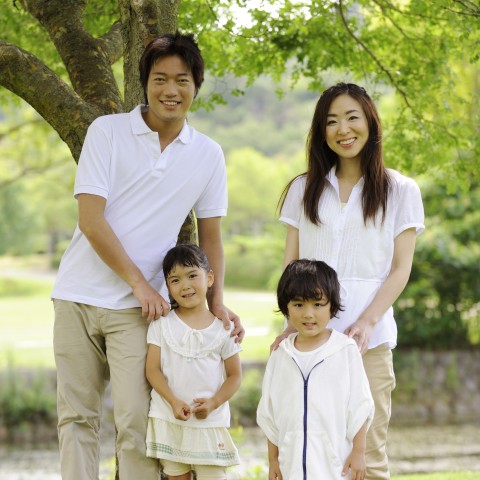
日本の平均的な家族は、両親と子供2人です。
Nihon no heikinteki na kazoku wa, ryōshin to kodomo futari desu.
“The average Japanese family has parents and two children.”
4. Verbs – 動詞 (Dōshi)
Verbs are used with nouns to form a complete thought. Learning the most common Japanese verbs will help you communicate more effectively with native speakers and provide a solid vocabulary base to build on.
Daily Activities
| English | Kanji | Hiragana | Reading |
| wake up / get up | 起きる | おきる | okiru |
| sleep | 寝る | ねる | neru |
| see / watch / look | 見る | みる | miru |
| hear / listen | 聞く | きく | kiku |
| say | 言う | いう | iu |
| eat | 食べる | たべる | taberu |
| drink | 飲む | のむ | nomu |
| go | 行く | いく | iku |
| come | 来る | くる | kuru |
| walk | 歩く | あるく | aruku |
| run | 走る | はしる | hashiru |
| enter | 入る | はいる | hairu |
| go out / come out | 出る | でる | deru |
| push | 押す | おす | osu |
| pull | 引く | ひく | hiku |
| English | Kanji | Hiragana | Reading |
| change | 変える | かえる | kaeru |
| read | 読む | よむ | yomu |
| write | 書く | かく | kaku |
| do | ー | する | suru |
| work | 仕事する | しごとする | shigoto suru |
| study | 勉強する | べんきょうする | benkyō suru |
| drive | 運転する | うんてんする | unten suru |
| cook | 料理する | りょうりする | ryōri suru |
| stand | 立つ | たつ | tatsu |
| sit | 座る | すわる | suwaru |
| get on | 乗る | のる | noru |
| get off | 降りる | おりる | oriru |
Examples:
- 私は甘いものを食べるのが好きです。
Watashi wa amai mono o taberu no ga suki desu.
“I like to eat sweets.”
- 何度も言うように、どこに行くか決まったら教えて。
Nando mo iu yō ni, doko ni iku ka kimattara oshiete.
“As I’ve said many times, let me know when you decide where to go.”
- このボタンを押して降りてください。
Kono botan o oshite orite kudasai.
“Please push this button to get off.”
Other Common Verbs
| English | Kanji | Hiragana | Reading |
| have / hold | 持つ | もつ | motsu |
| give | ー | あげる | ageru |
| take | 取る | とる | toru |
| make | 作る | つくる | tsukuru |
| let | ー | させる | saseru |
| think | 思う | おもう | omou |
| meet | 会う | あう | au |
| find | 見つける | みつける | mitsukeru |
| lose | 失くす | なくす | nakusu |
| wait | 待つ | まつ | matsu |
| start / begin | 始める | はじめる | hajimeru |
| finish | 終える | おえる | oeru |
| be / exist (living thing) | 居る | いる | iru |
| be / exist (non-living thing) | 在る | ある | aru |
| laugh / smile | 笑う | わらう | warau |
| get angry | 怒る | おこる | okoru |
| become sad | 悲しむ | かなしむ | kanashimu |
| enjoy | 楽しむ | たのしむ | tanoshimu |
| love | 愛する | あいする | aisuru |
| forget | 忘れる | わすれる | wasureru |
| apologize | 謝る | あやまる | ayamaru |
| rest | 休む | やすむ | yasumu |
Examples:
- 私が失くした財布を弟が見つけた。
Watashi ga nakushita saifu o otōto ga mitsuketa.
“My younger brother found the wallet that I lost.”
- 彼は両親を悲しませないために大学へ行く。
Kare wa ryōshin o kanashimasenai tame ni daigaku e iku.
“He goes to university in order not to make his parents sad.”
- 何があっても笑うことと愛することを忘れないでください。
Nani ga atte mo warau koto to aisuru koto o wasurenaide kudasai.
“No matter what happens, please do not forget to smile and love.”
To learn more about Japanese verbs, please check out The 100+ Most Common Japanese Verbs and Japanese Tenses: Simple Yet Unique.

カラオケで楽しむ
Karaoke de tanoshimu
“Enjoy at karaoke”
5. Adjectives – 形容詞 (Keiyōshi)
As you know, adjectives are used to describe nouns. Learning the most common Japanese words for describing things will allow you to add spice to your conversations and flair to your writing, so pay close attention!
Describing Objects
| English | Kanji | Hiragana | Reading |
| big / large | 大きい | おおきい | ōkii |
| small / little | 小さい | ちいさい | chiisai |
| long | 長い | ながい | nagai |
| short | 短い | みじかい | mijikai |
| round | 丸い | まるい | marui |
| square | 四角い | しかくい | shikakui |
| hard / stiff | 固い | かたい | katai |
| soft / flexible | 柔らかい | やわらかい | yawarakai |
| hot* | 熱い | あつい | atsui |
| cold (to the touch)** | 冷たい | つめたい | tsumetai |
* “hot” is 暑い (atsui) when referring to the weather.
** “cold” is 寒い (samui) when referring to the weather.
Examples:
- 熱いお茶と冷たいジュース、どちらが好きですか。
Atsui o-cha to tsumetai jūsu, dochira ga suki desu ka.
“Which do you prefer, hot tea or cold juice?”
- このパンは思ったよりも固い。
Kono pan wa omotta yori mo katai.
“This bread is harder than I thought.”
- 私は次のバスが来るまで長い時間待ちました。
Watashi wa tsugi no basu ga kuru made nagai jikan machimashita.
“I waited a long time until the next bus arrived.”
Describing People and Emotions
| English | Kanji | Hiragana | Reading |
| tall / high | 高い | たかい | takai |
| short / low | 低い | ひくい | hikui |
| thin / skinny / slim | 痩せた | やせた | yaseta |
| fat | 太った | ふとった | futotta |
| cute / pretty | 可愛い | かわいい | kawaii |
| beautiful | 美しい | うつくしい | utsukushii |
| handsome / cool | 格好良い | かっこいい | kakkoii |
| kind / gentle | 優しい | やさしい | yasashii |
| difficult | 難しい | むずかしい | muzukashii |
| scary | 怖い | こわい | kowai |
| fun / interesting | 面白い | おもしろい | omoshiroi |
| happy | 嬉しい | うれしい | ureshii |
| sad | 悲しい | かなしい | kanashii |
| fun / enjoyable | 楽しい | たのしい | tanoshii |
| sleepy | 眠い | ねむい | nemui |
Examples:
- 私は背が低いが、兄は背が高い。
Watashi wa se ga hikui ga, ani wa se ga takai.
“I’m short but my brother is tall.”
- 彼女は可愛いのに難しい性格です。
Kanojo wa kawaii noni muzukashii seikaku desu.
“She is pretty but has a difficult personality.”
- 怖い映画は嫌いです。
Kowai eiga wa kirai desu.
“I don’t like scary movies.”
Describing Weather
Technically, there is no one-word adjective to describe the weather in Japanese; weather is usually described using a weather noun and a particle, which together function like an adjective.
| English | Kanji | Hiragana | Reading |
| sunny | 晴れの | はれの | hare no |
| rainy | 雨の | あめの | ame no |
| cloudy | 曇りの | くもりの | kumori no |
| windy | 風の(ある/強い) | かぜの(ある/つよい) | kaze no aru / tsuyoi |
| snowy | 雪の | ゆきの | yuki no |
Examples:
- 風の強い日はよく電車が止まる。
Kaze no tsuyoi hi wa yoku densha ga tomaru.
“Trains often stop on windy days.”
- 雨の日は学校に行きたくない気分になります。
Ame no hi wa gakkō ni ikitakunai kibun ni narimasu.
“I feel like I don’t want to go to school on a rainy day.”
- 秋は晴れの日が多いです。
Aki wa hare no hi ga ōi desu.
“There are many sunny days in autumn.”
To learn more about Japanese adjectives, please check out our article Learn the Top 100 Essential Japanese Adjectives and -I vs. -NA Adjectives in Japanese.
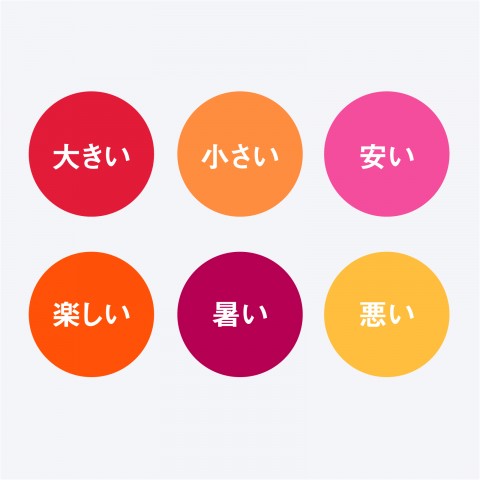
晴れの日は楽しい
hare no hi wa tanoshii
“sunny days are fun”
6. Conjunctions – 接続詞 (Setsuzokushi)
| English | Kanji | Hiragana | Reading |
| and / then | ー | そして | soshite |
| because / therefore / thus | ー | だから | dakara |
| but | ー | だが | daga |
| however / on the contrary | ー | ところが | tokoroga |
| also | ー | また | mata |
| or | 又は | または | matawa |
| by the way | ー | ところで | tokorode |
| moreover / furthermore | ー | さらに | sarani |
| for example | 例えば | たとえば | tatoeba |
Examples:
- 彼は学校へ行き、そして試験を受けた。
“He went to school, and took an exam.”
Kare wa gakkō e iki, soshite shiken o uketa.
- 朝はとても寒かった。ところが、午後はとても暑くなった。
Asa wa totemo samukatta. Tokoroga, gogo wa totemo atsuku natta.
“It was very cold in the morning. However, it became very hot in the afternoon.”
- お寿司またはラーメンを食べたいです。
O-sushi matawa rāmen o tabetai desu.
“I want to eat Sushi or Rāmen.”
For more information about Japanese conjunctions, please see Japanese Conjunctions: Learn Japanese Linking Words.
7. Other – その他 (Sonota)
Particles, or 助詞 (joshi), play a crucial role in Japanese grammar. Japanese particles are postpositional and they’re placed after nouns, verbs, and adjectives. In the table below are the most common beginner-level particles, as well as the basic predicates.
| English | Hiragana | Reading |
| Case marker: topic, theme, and subject | は * | wa |
| Case marker: topic, theme, and subject (emphasizing) | が | ga |
| too | も | mo |
| of | の | no |
| in / at / to | に | ni |
| by | で | de |
| a predicate that is placed at the end of a sentence (present tense / casual) | だ | da |
| a predicate that is placed at the end of a sentence (present tense / polite) | です | desu |
| a predicate that is placed at the end of a sentence(past tense / casual) | だった | datta |
| a predicate that is placed at the end of a sentence(past tense / polite) | でした | deshita |
* As a case marker particle, Hiragana “は” is read as “wa” instead of “ha.“
Examples:
- 彼も学生でした。
Kare mo gakusei deshita.
“He was a student, too.”
- 荷物は11月の第1週目に届きました。
Nimotsu wa jū-ichi-gatsu no dai isshū-me ni todokimashita.
“The package arrived in the first week of November.”
- 彼女は今学校にいます。
Kanojo wa ima gakkō ni imasu.
“She is at school now.”
Feeling a bit overwhelmed at this point? To learn more about the Japanese language in a simplified manner, please check out An Easy Guide to Japanese Grammar.
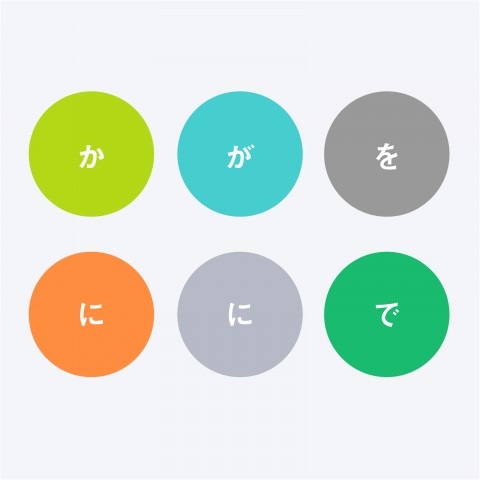
Particles play a very important role in Japanese grammar.
8. Conclusion
In this article, we introduced the most common Japanese beginner words, including pronouns, numbers, nouns, verbs, adjectives, conjunctions, and particles. Once you master this list, you’ll be able to understand quite a bit during your daily Japanese conversations in everyday situations!
If you would like to learn even more about the Japanese language, you’ll find more helpful content on JapanesePod101.com. We provide a variety of free lessons designed to help you improve your Japanese language skills.
If you’re a beginner, the following articles will be quite useful:
- Japanese Language Overview: All the Facts You Need to Know
- Japanese Sentence Structure & Word Order
- The 10 Most Useful Japanese Sentence Patterns
And there’s so much more! Learn faster and enjoy studying Japanese at JapanesePod101.com!
Before you go, let us know in the comments if there are Japanese words in any category you still want to know! We’d be glad to help and look forward to hearing from you!

The Top 10 Japanese Filler Words

When learning a foreign language, one studies the phrases and grammar rules laid out in their textbook or taught in the classroom. But once a language student begins to practice what they’ve learned in the real world, it’s not long until they encounter a number of unfamiliar expressions in the spoken language.
Filler words are a great example of this.
Japanese filler words are small words or sounds often used to fill pauses in conversation, emphasize a point, soften a statement, and so on.
Once you master Japanese filler words and start using them in conversations, you’ll begin to sound more and more like a native speaker. But while filler words can help your speech sound more natural, overusing them can be annoying or leave an undesirable impression of you on others. The key is to use them naturally and effectively.
In this article, we’ll introduce the top 10 Japanese filler words, explain the characteristics and functions of each, and discuss the pros and cons of using them.
- → If you’re looking for more ways to make your Japanese sound more natural, why not learn a few Japanese idioms or funny Japanese expressions?

ええと・・・ (eeto…) – “umm…” You can use this Japanese filler when you’re thinking.
 Table of Contents
Table of Contents
1. What are filler words?
Filler words are short words or sounds used to fill pauses in conversations, usually to let the other party know you’re not done speaking yet. In English, commonly used filler words and sounds include:
- “Uh…”
- “Um…”
- “Er…”
- “Well…”
- “So…”
- “You know…”
- “I mean…”
- “Like…”
Although filler words and sounds add no particular meaning to the speaker’s statement, they do have a function in speech. As mentioned, filler words are most often used to let the other party know that you’re thinking about what to say next and that you’re not finished speaking. This signals to the other party that they should keep listening rather than take their turn to speak.
Fillers can also be used for a variety of other purposes, depending on the context. For example, they can be used to…
- …speak more indirectly in order to be polite.
- …approach a delicate topic gently.
- …emphasize an idea.
- …provide clues about the speaker’s emotions or behaviors.
- …communicate uncertainty.

Filler words are used to fill the little pauses in conversations.
How are they used in Japanese?
Filler words in Japanese are used in almost the same way as those in English.
Most Japanese filler words are casual. That said, some of them—such as あの (ano) and その (sono)—can also be used in formal/official situations. Others are only used by young people or thoughtless adults and are referred to as 若者言葉 (wakamono kotoba) or “young people’s words.” Fillers that fall into this category include てゆーか (te yū ka) and てかさー (teka sā).
In the following section, we’ll go into more detail about the usage of each commonly used Japanese filler word.

The most frequently used Japanese filler words are あのー (anō), meaning “um…” / “er…,” and ええと (eeto…), meaning “well…”
2. Top 10 Japanese Filler Words
#1 ええと (eeto) / えっと (etto) / えー (ē)
English Equivalents: “er” / “err” / “uh” / “um”
This is one of the most common Japanese filler words. You can use it to indicate that you’re pausing to think or to precede something that you’re hesitant to say.
While ええと (eeto) and えー (ē) can be used both casually and in formal situations—such as in an official speech or a business presentation—えっと (etto) should only be used casually. These filler words may be used multiple times in one sentence.
Examples
- ええと、何を言おうとしていたんだっけ・・
Eeto, nani o iō to shite ita n dakke…
“Err, what I was trying to say…”
- えっと、今から授業が始まるから、後でね。
Etto, ima kara jugyō ga hajimaru kara, ato de ne.
“Um, maybe later because the class is starting now.”
- えー、先ほども述べた通り、えー、今期の営業利益はマイナスです。
Ē, sakihodo mo nobeta tōri, ē, konki no eigyō rieki wa mainasu desu.
“Uh, as I mentioned before, um, the operating profit of this period is negative.”
#2 あの (ano) / あのー (anō)
English Equivalents: “well” / “uh” / “um”
This is another frequently used Japanese filler word that can be used in both casual and formal situations. It’s very similar to ええと(eeto) and えー (ē), but this one can also be used to get the listener’s attention.
Examples
- あの、ちょっといいですか、あの、言いたいことがあります。
Ano, chotto ii desu ka, ano, iitai koto ga arimasu.
“Err, can I have a minute, um, I have something to say.”
- ええと、ここに問題があります。あのー、ようするに流通の問題です。
Eeto, koko ni mondai ga arimasu. Anō, yōsuruni, ryūtsū no mondai desu.
“Um, the problem lies here. Well, in a word, the distribution problem.”

田中さん、あの、ランチ一緒に行きませんか。
Tanaka-san, ano, ranchi issho ni ikimasen ka.
“Ms. Tanaka, um, would you like to have lunch together?”
#3 その (sono) / そのー (sonō)
English Equivalents: “well” / “uh” / “um”
These are similar to あの (ano) and あのー (anō). They’re used to pause a little so you can think of what to say next, or before talking about a delicate subject.
Examples
- 私は、その、これが良い案とは思いません。
Watashi wa, sono, kore ga ii an to wa omoimasen.
“I, uh, I don’t think this is a good idea.”
- そのー、いわゆる、それはザイアンス効果によるものです。
Sonō, iwayuru, sore wa Zaiansu kōka ni yoru mono desu.
“Well, so to speak, it is due to the mere-exposure effect.”
#4 うーん (ūn) / うーんと (ūnto)
English Equivalent: “umm”
This is the Japanese version of “umm.” It’s an example of 擬態語 (Gitaigo), or “onomatopoeia,” used to describe a state of “thinking.” You can use this filler to let the other person know you’re gathering your thoughts, or to precede something that you’re hesitant to say.
Examples
- うーん、どっちにしようかな。 うーん、この二つから決めるのは難しい。
Ūn, dotchi ni shiyō ka na. Ūn, kono futatsu kara kimeru no wa muzukashii.
“Umm, which one should I choose? Ummm, it’s hard to decide between these two.”
- うーんと、今週の土曜日なら大丈夫です。
Ūnto, konshū no do-yōbi nara daijōbu desu.
“Umm, it’s okay on this Saturday.”

うーん、それはちょっと難しいです。
Ūn, sore wa chotto muzukashii desu.
“Umm, that’s a bit difficult.”
#5 なんか (nanka)
English Equivalents: “like” / “you know”
As a casual filler word, なんか (nanka) is similar to the English word “like,” but it has a nuance that’s more like saying “hey” or “wait” after noticing or discovering something that you want to share with another party.
Examples
- なんか、私にとってはどっちでもいいって感じ。
Nanka, watashi ni totte wa dotchi demo ii tte kanji.
“Like, I don’t care whichever.”
- なんか、今日はいつもより道が混んでるよ。
Nanka, kyō wa itsumo yori michi ga konde ru yo.
“Hey, it seems there is more traffic today than usual.”
#6 ていうか (te iu ka)
English Equivalents: “I mean” / “you know”
This Japanese filler word is very casual and it’s often used to express disagreement with something in a softer way.
There are a few variations of this filler, including:
- なんていうか (nante iu ka) – “what do I say…” / “let me see..”
- This variation can also be used in formal situations.
- てゆーか (te yū ka) – “I mean” / “you know”
- This one is very casual, and used primarily among young people.
- てかさ (teka sa) – “I mean” / “you know”
- This one is very casual, and used primarily among young people.
Examples
- ていうか、むしろ彼に感謝したほうがいいよ。
Te iu ka, mushiro, kare ni kansha shita hō ga ii yo.
“I mean, you should rather thank him.”
- ええと、なんていうか、この計画は見直しが必要だと思います。
Eeto, nante iu ka, kono keikaku wa minaoshi ga hitsuyō da to omoimasu.
“Er, I mean, I think this plan needs to be reviewed.”
- てかさ、前にも言ったけど、勝手に私の部屋に入らないで。
Teka sa, mae ni mo itta kedo, katte ni watashi no heya ni hairanaide.
“You know, as I said before, don’t enter my room without asking me.”
#7 まぁ・・(mā)
English Equivalent: “well”
This filler word is used to express hesitance or to mildly approach a delicate topic.
For reference, the sound ま (ma) has different nuances depending on how it’s said. For example:
- まぁ!(mā!) – “Wow!” / “Oh!”
- In this variation, there is an accent over the a in ma. It’s often expressed with a small Hiragana “あ.”
- まぁ まぁ (mā mā) – “so-so”
- When the long mā is repeated, it means “so-so.”
Examples
- まぁ、別に私はいいけど、他の人にも意見を聞いた方がいいと思う。
Mā, betsu ni watashi wa ii kedo, hoka no hito ni mo iken o kiita hō ga ii to omou.
“Well, I don’t mind, but I think it’s better to ask other people their opinions.”
- まぁ、仕方ないです。誰も天気をコントロールできないですから。
Mā, shikatanai desu. Dare mo tenki o contorōru dekinai desu kara.
“Well, it can’t be helped, because nobody can control the weather.”
#8 それで (sorede)
English Equivalents: “so” / “and then”
This Japanese filler is typically used at the beginning of a sentence to start a new topic in the conversation or to ask for additional information. It can also be used to explain something involving a series of events.
The short version of それで (sorede) is just で (de), which is used very casually.
Examples
- それで、週末に釣りに行く計画はどうなったんですか。
Sorede, shūmatsu ni tsuri ni iku keikaku wa dō natta n desu ka.
“So, what happened to the plan to go fishing on the weekend?”
- で、何が言いたいの?
De, nani ga iitai no?
“So, what do you want to say?”

それで、第2話はどんな展開になったの?
Sorede, dai-ni-wa wa donna tenkai ni natta no?
“So, what happened in the second episode?”
#9 そうか (sōka)
English Equivalents: “is that so” / “I see” / “oh”
You could use this filler word to indicate that you’ve finally realized or understood something.
.
There are two other variations you could use:
1. そっか (sokka) – the very casual version
2. そうですか (sō desu ka) – the most polite version using 敬語 (Keigo), or honorifics
Examples
- そうか、その形には重要な意味があったのか。
Sōka, sono katachi ni wa jūyō na imi ga atta no ka.
“I see, there is an important meaning for that shape.”
- そっか、わかった!やっと謎が解けたよ。
Sokka, wakatta! Yatto nazo ga toketa yo.
“Oh, I understand it. Finally the mystery is solved.”
#10 そうそう (sō sō)
English Equivalent: “yes, yes” / “that’s right”
This filler word is used to affirm something or agree with someone.
Examples
- そうそう! まさにこれが欲しかったんです!ありがとう。
Sō sō! Masani kore ga hoshikatta n desu! Arigatō.
“Yes, yes! This is exactly what I wanted! Thank you.”
- そうそう、そういうこと!
Sō sō, sō iu koto!
“Yes, yes, that’s what I’m talking about!”
3. Pros and Cons of Filler Words
Japanese people use a variety of filler words in their daily conversations. As these words are short and often found at the beginning of a sentence, you may easily pick them up while watching Japanese anime or TV shows, for example.
But even though they’re simple to pick up, there are some tips to keep in mind regarding how to use Japanese filler words effectively and wisely!
1 – Pro: Using filler words makes you sound like a local.
Every language learner would appreciate the obvious benefit of using filler words: it instantly makes you sound more natural and “like-native” in everyday conversations.
For beginners and intermediate learners, filler words can serve two key functions:
1) Helping you avoid the awkward sentence examples sometimes found in textbooks
2) Giving you a simple way to gain time in a conversation to conjure up vocab words and construct sentences
If you have an advanced level of fluency, learning the differences in nuance and usage of similar Japanese conversation fillers can help you sound like a native speaker. Using them in the right contexts will impress locals and give the impression that you’re truly fluent.

Using filler words in conversations makes it sound natural.
2 – Con: Overusing them can leave a bad impression.
Here’s the tricky part of using filler words.
Overuse can create the impression that you’re indecisive and lack confidence. In addition, there are variations of Japanese filler words for different levels of formality; if you use overly casual ones all the time, people might think you’re childish or even stupid.
Especially in formal settings—such as when you’re giving a public speech, a business presentation, or an interview—it’s wise to avoid using filler words. This is because they will distract your listener(s) from the point you’re trying to make. It’s often pointed out that poor speakers frequently use えー (ē), あのー (anō), and そのー (sonō) in their speech.
In order to avoid overusing filler words in your important speech, and to give the impression that you’re a confident and smart professional, please consider the following tips.
(1) Use short sentences.
You probably use filler words unconsciously, especially when saying a long sentence or when you have a lot to say. To avoid this, make the important points clear and state them in short sentences. This will keep you from needing to pause often or connect your ideas with filler words. Stating things clearly also makes a confident and crisp impression.
(2) Don’t be afraid to pause.
Some people hate awkward silences in conversations. However, when giving a public speech or business presentation, you are the sole speaker. As such, you shouldn’t be afraid of long pauses or moments of silence.
While many people feel that they must continue speaking and rush to find their next words, a short pause is actually an effective way to draw the audience’s attention. In addition, it gives the listeners more time to follow along with and understand the content of the speech.
For these reasons, it’s better to pause every once in a while rather than filling that pause with unnecessary words.

The repetition of filler words like あのー (anō…) and ええと (eeto…) in a presentation does not give a good impression.
4. Conclusion
In this article, we introduced the top 10 Japanese filler words. We also outlined the pros and cons of using them in your speech and gave you tips on how to limit their use. How many of these Japanese filler words did you already know, and did you find any new useful ones?
If you would like to learn more about the Japanese language and other useful Japanese phrases, you’ll find lots of helpful content on JapanesePod101.com. We provide a variety of free lessons designed to help you improve your Japanese language skills.
To learn more everyday Japanese, make sure to see our article The 10 Most Useful Japanese Questions and Answers. Or, if you’re curious how to pick up the language even faster, you’ll enjoy reading The Top 10 Japanese YouTube Channels to Improve Your Japanese.
And there’s so much more! Learn the language faster and enjoy studying Japanese at JapanesePod101.com!
Before you go, let us know in the comments if there are any not-in-the-textbooks spoken Japanese phrases you still want to know! We’d be glad to help, and we look forward to hearing from you!

Say “I Love You” in Japanese with These Love Phrases

Love phrases are often very romantic…
“My sweet love.”
“Your eyes are very beautiful.”
“You’re my dream girl.”
But keep in mind that Japanese love phrases are usually mild in comparison to those above. People could view you as a player or sleazy flirt if you use such artificial romantic words in Japan!
There are some things to consider before expressing your love in Japanese.
Japanese people are usually shy compared to Western people when it comes to expressing love. For example, while hugs and kisses are a common greeting between couples or good friends in Western culture, this is not common in Japan—even between couples. In Japan, thoughtfulness (気遣い [kizukai]) and caring behavior (思いやりのある行動 [omoiyari no aru kōdō]) are much preferred over very amorous words in romantic relationships.
With such characteristics in mind, we’ll introduce natural and practical Japanese love phrases you can use at each stage of your romantic endeavors: first contact, your first date, taking your relationship to the next level, and even proposing marriage! At the end of this article, we’ll also show you some inspirational Japanese love quotes.
Learn Japanese love phrases here at JapanesePod101.com and win the heart of someone special!
 Table of Contents
Table of Contents
- First Contact / Show Your Interest: Pick-Up Lines
- Get Closer: Phrases to Use While Dating
- Fall in Deeper: “I Love You,” and More
- Take it One Step Further: “Will You Marry Me?” and More
- Japanese Love Quotes
- How JapanesePod101 Can Help You Learn More Japanese

Learn some romantic Japanese love phrases that touch his/her heart.
1. First Contact / Show Your Interest: Pick-Up Lines
When someone catches your interest at a bar, during an event, or even on the street, the following phrases are useful. For your first contact with this person, using the formal form (polite honorific) would be nice; it will give them the impression that you’re a polite and decent person. Unless you’re a teenager, talking to someone for the first time in the informal/casual form may sound like flirting. Nonetheless, we’ve included the casual form for each phrase as well.
1 – 今ちょっといいですか。
Reading: Ima chotto ii desu ka.
Meaning: Is it okay to talk for a second? / Can I talk to you now?
Informal / Casual Form: 今ちょっといい? (Ima chotto ii?)
Example:
A:
すみません、今ちょっといいですか。
Sumimasen, ima chotto ii desu ka.
“Excuse me, can I talk to you?”
B:
はい、なんですか。
Hai, nan desu ka.
“Yes, what is it?”
2 – ここによく来るんですか。
Reading: Koko ni yoku kuru n desu ka.
Meaning: Do you come here often?
Informal / Casual Form: ここによく来るの? (Koko ni yoku kuru no?)
Example:
A:
このバー、今年オープンしたんですよね。ここによく来るんですか。
Kono bā, kotoshi ōpun shita n desu yo ne. Koko ni yoku kuru n desu ka.
“This bar seems to have opened this year. Do you come here often?”
B:
いいえ、初めて来ました。
Iie, hajimete kimashita.
“No, I came here for the first time.”
3 – 名前はなんて言うんですか。
Reading: Namae wa nan te iu n desu ka.
Meaning: What is your name?
Informal / Casual Form: 名前はなんて言うの? (Namae wa nan te iu no?)
Example:
A:
名前はなんて言うんですか。聞いてもいいですか。
Namae wa nan te iu n desu ka. Kiite mo ii desu ka.
“What is your name? Can I ask?”
B:
ええと、、さとみです。
Ēto…Satomi desu.
“Well…I’m Satomi.”
4 – 友達 / 彼氏 / 彼女と来たんですか。
Reading: Tomodachi / kareshi / kanojo to kita n desu ka.
Meaning: Did you come with your friend(s) / boyfriend / girlfriend?
Informal / Casual Form: 友達 / 彼氏 / 彼女と来たの? (Tomodachi / kareshi / kanojo to kita no?)
Example:
A:
今日はここに友達と来たんですか。
Kyō wa koko ni tomodachi to kita n desu ka.
“Did you come here with your friend(s) today?”
B:
はい、友達と来ました。あそこにいるのが私の友達です。
Hai, tomodachi to kimashita. Asoko ni iru no ga watashi no tomodachi desu.
“Yes, I came with my friend. My friend is over there.”
5 – 連絡先を聞いてもいいですか。
Reading: Renrakusaki o kiite mo ii desu ka.
Meaning: Can I ask for your contact information?
Informal / Casual Form: 連絡先を聞いてもいい? (Renrakusaki o kiite mo ii?)
Example:
A:
連絡先を聞いてもいいですか。ライン使ってますか。
Renrakusaki o kiite mo ii desu ka. Rain tsukatte masu ka.
“Can I ask for your contact information? Do you use LINE?”
B:
はい、いいですよ。私のラインIDは____です。
Hai, ii desu yo. Watashi no rain ID wa ____ desu.
“Yes, it’s okay. My LINE ID is ____.”
6 – また会いたいです。
Reading: Mata aitai desu.
Meaning: I’d like to see you again.
Informal / Casual Form: また会いたいな。(Mata aitai na.)
Example:
A:
もっとゆっくり話したいので、また会いたいです。
Motto yukkuri hanashitai node, mata aitai desu.
“I’d like to see you again because I want to talk more when we have more time.”
B:
そうですね。ここは少しうるさいので、今度はどこか静かなところで話しましょう。
Sō desu ne. Koko wa sukoshi urusai node, kondo wa dokoka shizuka na tokoro de hanashimashō.
“I agree, it’s a bit noisy here, so let’s talk somewhere quiet next time.”
7 – 今度一緒に食事でもどうですか。
Reading: Kondo issho ni shokuji demo dō desu ka.
Meaning: How about dining out together next time?
Informal / Casual Form: 今度一緒に食事でもどう? (Kondo issho ni shokuji demo dō?)
Example:
A:
今度一緒に食事でもどうですか。
Kondo issho ni shokuji demo dō desu ka.
“How about dining out together next time?”
B:
いいですね。平日は忙しいですが、週末なら大丈夫です。
Ii desu ne. Heijitsu wa isogashii desu ga, shūmatsu nara daijōbu desu.
“Sounds good. I’m busy on weekdays but weekends are okay.”

今度一緒に食事でもどうですか。 (Kondo issho ni shokuji demo dō desu ka.) – “How about dining out together next time?”
2. Get Closer: Phrases to Use While Dating
After the first meeting and maybe a few message exchanges, you may think you’re getting to know the person better and feel closer to them. At this point, it’s okay to use the informal/casual form if you’re in the same age group as her/him and if you feel comfortable enough to talk casually. If the other person is much older than you, or if you still feel like you don’t know her/him very much, then talking in the formal register would be better.
8 – また会えて嬉しいです。
Reading: Mata aete ureshii desu.
Meaning: I’m happy to see you again.
Informal / Casual Form: また会えて嬉しいよ。 (Mata aete ureshii yo.)
Example:
A:
来てくれてありがとう、また会えて嬉しいよ!
Kite kurete arigatō, mata aete ureshii yo!
“Thank you for coming, I’m happy to see you again!”
B:
こちらこそ、誘ってくれてありがとう。
Kochira koso, sasotte kurete arigatō.
“Likewise, thank you for asking me out.”
9 – 手をつないでもいいですか。
Reading: Te o tsunaide mo ii desu ka.
Meaning: Can I hold your hand?
Informal / Casual Form: 手をつないでもいい? (Te o tsunaide mo ii?)
Example:
A:
手をつないでもいい?
Te o tsunaide mo ii?
“Can I hold your hand?”
B:
うん、いいよ。
Un, ii yo.
“Yeah, it’s okay.”
10 – ___ は 優しい / かわいい / かっこいい / 面白い ですね。
Reading: ___ wa yasashii / kawaii / kakkoii / omoshiroi desu ne.
Meaning: ___ (insert their name*) is thoughtful / cute / handsome / fun. **
Informal / Casual Form: ___ は 優しい ね。 (___ wa yasashii ne.)
*Add さん (san) after their name when using the formal form. This gives a polite impression.
**In Japanese, calling someone by their name is more common than saying “you are…” (あなたは [anata wa]).
Example:
A:
仕事で表彰されたんですか、けんじさんはかっこいいですね!
Shigoto de hyōshō sareta n desu ka, Kenji-san wa kakkoii desu ne!
“You got awarded at work? Kenaji-san, you are cool!”
B:
ありがとう、褒めてくれて嬉しいよ。
Arigatō, homete kurete ureshii yo.
“Thank you, I’m happy you gave me a compliment.”
11 – 今日はとても楽しかったです。
Reading: Kyō wa totemo tanoshikatta desu.
Meaning: Today was really fun. / I enjoyed today very much.
Informal / Casual Form: 今日はとても楽しかったよ。 (Kyō wa totemo tanoshikatta yo.)
Example:
A:
一緒に過ごせて、今日はとても楽しかったです。
Issho ni sugosete, kyō wa totemo tanoshikatta desu.
“It was really fun today to spend time together with you.”
B:
私も楽しかったです。
Watashi mo tanoshikatta desu.
“I enjoyed it, too.”
12 – 彼氏 / 彼女 になってほしいです。
Reading: Kareshi / kanojo ni natte hoshii desu.
Meaning: I want you to be my boyfriend / girlfriend.
Informal / Casual Form: 彼氏 / 彼女になってほしいな。 (Kareshi / kanojo ni natte hoshii na.)
Example:
A:
僕の彼女になってほしいな。
Boku no kanojo ni natte hoshii na.
“I want you to be my girlfriend.”
B:
嬉しい、私も同じこと考えていたよ!
Ureshii, watashi mo onaji koto kangaete ita yo!
“I’m happy to hear that, I was thinking the same!”
13 – 私 / 僕 と付き合ってください。
Reading: Watashi / boku to tsukiatte kudasai.*
Meaning: Please go out / go steady with me.
Informal / Casual Form: 私 / 僕 と付き合って。(Watashi / boku to tsukiatte.)
*私 (watashi), which is “I” in neutral, is normally used by females; 僕 (boku), which is “I” in mild masculine, is used by males.
In Japan, 告白 (kokuhaku), which is a “confession” of one’s romantic feelings, is very common before becoming boyfriend-girlfriend in order to make it clear.
Example:
A:
はるかちゃん、僕と付き合ってください。
Haruka-chan, boku to tsukiatte kudasai.
“Haruka-chan, please go steady with me.”
B:
嬉しいけど、もっとお互いを知るために友達から始めよう。
Ureshii kedo, motto otagai o shiru tame ni tomodachi kara hajimeyō.
“I’m glad, but let’s start from friends to know each other more.”

君と一緒にいると楽しいよ。 (Kimo to issho ni iru to tanoshii yo.) – “It’s fun to be with you.”
3. Fall in Deeper: “I Love You,” and More
Once you’ve been seeing each other for a while, you might want to start expressing your deeper feelings for the other person. Here are a few romantic Japanese phrases commonly used among couples—feel free to try them out yourself, keeping in mind that they’re typically used in the informal/casual form.
14 – 好きだよ。
Reading: Suki da yo.
Meaning: I like you.
This is the most common way to express your affection in Japan. When used toward someone special, the Japanese word 好き (suki), meaning “like,” conveys a more affectionate nuance than the English word “like.”
Example:
A:
好きだよ、早く会いたい。
Suki da yo, hayaku aitai.
“I like you, I want to see you soon.”
B:
私も、週末が待ち遠しい!
Watashi mo, shūmatsu ga machidōshii!
“Me too, I can’t wait for the weekend!”
15 – 大好きだよ。
Reading: Daisuki da yo.
Meaning: I like you very much.
This phrase is similar in nuance to “I love you,” in English. This is the most common phrase to express love toward a boyfriend or girlfriend.
Example:
A:
はるき、大好きだよ!
Haruki, daisuki da yo!
“Haruki, I like you very much!”
B:
何、いきなり。僕もだよ。
Nani, ikinari. Boku mo da yo.
“What is it suddenly? Me, too.”
16 – 愛してる(よ)。
Reading: Aishite ru (yo).
Meaning: I love you.
This phrase is used when you really want to express that you love someone. It conveys a profound nuance, so it might sound cheesy if you were to use it too often.
Example:
A:
亡くなった妻の最後の言葉は「愛してるよ」でした。
Nakunatta tsuma no saigo no kotoba wa “aishite ru yo” deshita.
“The last word of my wife who passed away was, ‘I love you’. ”
B:
彼女はとても愛していたんですね。
Kanojo wa totemo aishite ita n desu ne.
“She must have loved very much.”
17 – XXXがいないと寂しいよ。
Reading: ___ ga inai to samishii yo.
Meaning: I feel lonely without ___ (insert their name). / I miss you.
Example:
A:
たかしがいないと寂しいよ。いつ出張から帰ってくるの?
Takashi ga inai to samishii yo. Itsu shucchō kara kaette kuru no?
“I feel lonely without you, Takashi. When do you come back from your business trip?”
B:
来週の金曜日だよ。
Raishū no kin-yōbi da yo.
“Friday next week.”
18 – 次はいつ会える?
Reading: Tsugi wa itsu aeru?
Meaning: When can we see/meet next?
Example:
A:
寂しいな。次はいつ会える?
Samishii na. Tsugi wa itsu aeru?
“I miss you. When can we meet next?”
B:
土曜日はどう?
Do-yōbi wa dō?
“How about Saturday?”
19 – 泊まりに行ってもいい?
Reading: Tomari ni itte mo ii?
Meaning: Can I come to stay over (at your place)?
Example:
A:
今すぐ会いたい!今日泊まりに行ってもいい?
Ima sugu aitai! Kyō tomari ni itte mo ii?
“I want to see you right away! Can I come to stay over tonight?”
B:
ごめん、明日は朝早く起きるから無理。
Gomen, ashita wa asa hayaku okiru kara muri.
“Sorry, you can’t because I have to get up early tomorrow morning.”

大好きだよ。(Daisuki da yo.) – “I like you very much.”

愛してるよ。(Aishite ru yo.) – “I love you.”
4. Take it One Step Further: “Will You Marry Me?” and More
Are you ready to commit? Do you look forward to spending the rest of your life with this person? Below are several love phrases in Japanese you can use to let your boyfriend or girlfriend know that you want to take your relationship to the next level.
20 – 一緒に住もう。
Reading: Issho ni sumō.
Meaning: Let’s live together.
Example:
A:
一緒に住もう!どうかな?
Issho ni sumō! Dō ka na?
“Let’s live together! What do you think?”
21 – ずっと一緒にいたい。
Reading: Zutto issho ni itai.
Meaning: I want to be with you forever.
Example:
A:
これから先、ずっと一緒にいたい!
Kore kara saki, zutto issho ni itai!
“From now on, I want to be with you forever.”
B:
うん、一生一緒だよ。
Un, ishhō issho da yo.
“Yeah, we will be together for the rest of our lives.”
22 – ___ がいない人生は考えられないよ。
Reading: ___ ga inai jinsei wa kangaerarenai yo.
Meaning: I can’t think of my life without you / ___ (insert their name).
Example:
A:
ゆかがいない人生は考えられないよ。
Yuka ga inai jinsei wa kangaerarenai yo.
“I can’t think of my life without you, Yuka.”
B:
私もだよ。
Watashi mo da yo.
“Me, too.”
23 – 一生 幸せ / 大事 にするよ。
Reading: Isshō shiawase / daiji ni suru yo.
Meaning: I will make you happy for the rest of my life.
Example:
A:
愛してる。一生幸せにするよ。
Aishite ru. Isshō shiawase ni suru yo.
“I love you. I will make you happy for the rest of my life.”
B:
嬉しい!私も愛してる。
Ureshii! Watashi mo aishite ru.
“I’m happy to hear that! I love you, too.”
24 – 私 / 僕 の両親に紹介したい。
Reading: Watashi / boku no ryōshin ni shōkai shitai.
Meaning: I want to introduce you to my parents.
Example:
A:
私の両親に紹介したいんだけど、いつがいい?
Watashi no ryōshin ni shōkai shitai n da kedo, itsu ga ii?
“I want to introduce you to my parents, when is good for you?”
B:
僕はいつでもいいよ。
Boku wa itsu demo ii yo.
“Anytime is okay for me.”
25 – 結婚しよう。
Reading: Kekkon shiyō.
Meaning: Let’s get married.
Example:
A:
大好きだよ、結婚しよう!
Daisuki da yo, kekkon shiyō!
“I like you very much (I love you), let’s get married!”
B:
え?これはプロポーズってこと?
E? Kore wa puropōzu tte koto?
E? Kore wa puropōzu tte koto?
26 – 私 / 僕 と結婚してください。
Reading: Watashi / boku to kekkon shite kudasai.
Meaning: Will you marry me? [In a polite/official way.]
Example:
A:
僕と結婚してください!
Boku to kekkon shite kudasai!
“Will you marry me?”
B:
はい、喜んで。
Hai, yorokonde.
“Yes, I’d love to.”
27 – 一緒に幸せな家庭を作ろう。
Reading: Issho ni shiawase na katei o tsukurō.
Meaning: Let’s make a happy family together.
Example:
A:
結婚しよう、一緒に幸せな家庭を作ろう!
Kekkon shiyō, issho ni shiawase na katei o tsukurō!
“Let’s get married and let’s make a happy family together!”
B:
嬉しくて泣きそう。
Ureshikute nakisō.
“I’m about to cry with joy.”

一生幸せにするよ。(Isshō shiawase ni suru yo.) – “I will make you happy for the rest of my life.”
5. Japanese Love Quotes
A quote is a concise and comprehensible statement of a general principle that often expresses the truth of things. Here are some words of wisdom about love by well-known Japanese people.
自分に誠実でないものは、決して他人に誠実であり得ない。
[ by Japanese novelist 夏目漱石 (Sōseki Natsume) ]
Reading: Jibun ni seijitsu de nai mono wa, kesshite tanin ni seijitsu de arienai.
Meaning: Anyone who is not honest with oneself can never be honest with others.
Sōseki Natsume is a famous novelist and literary person, whose portrait is printed on the Japanese 1000 yen note.
This quote is a famous line from one of his novels. It’s an enlightening phrase that tells us we need to be honest with ourselves before dealing with others.
恋愛は、チャンスではないと思う。私はそれを意志だと思う。
[ by Japanese novelist 太宰修 (Osamu Dazai) ]
Reading: Ren’ai wa, chansu de wa nai to omou. Watashi wa sore o ishi da to omou.
Meaning: Love is not a chance. I think it is a will.
Osamu Dazai was a talented but distressed famous author who left behind many well-known novels. Though he completed many written works, he also had many romantic relationships throughout his agonized life; he eventually decided his own fate (and that of his lover at the time) by committing a double suicide.
His words are compelling, telling us that loving someone does not always occur by chance; we can also make the choice to love someone.
本当の愛は見返りを求めない無償の愛。
[ by Japanese singer, actor, director, composer, and author 美輪明宏 (Akihiro Miwa) ]
Reading: Hontō no ai wa mikaeri o motomenai mushō no ai.
Meaning: True love is love that asks nothing in return.
Akihiro Miwa is a famous entertainer who survived the atomic bombings of Nagasaki when he was young and has led a life full of ups and downs. Being viewed as a unique and unusual character back in the day, he went through a lot of difficult times. Considering his life experiences, his message is persuasive and resonates with many people’s hearts.
そのときの出会いが人生を根底から変えることがあるよき出会いを。
[ by Japanese poet 相田みつを (Mitsuo Aida) ]
Reading: Sono toki no deai ga jinsei o kontei kara kaeru koto ga aru yoki deai o.
Meaning: Have a good encounter that can change your life from the ground up.
Mitsuo Aida was a famous Japanese calligrapher and poet who had studied Buddhism and zen when he was young. His poetry conveys messages about humanity and life, written in his unique style of calligraphy.
This message tells us that an encounter with someone may completely change our lives thereafter, so it’s important to have good encounters.
- → To learn more Japanese quotes, please take a look at our article Japanese Quotes That Will Enrich Your Life.

愛の格言 (Ai no kakugen) – “love quotes”
How JapanesePod101 Can Help You Learn More Japanese
In this article, we introduced Japanese love phrases you can use at various stages of your romantic relationship. We also covered a few famous Japanese quotes about love to inspire and encourage you to act on your crush!
If you would like to learn more about the Japanese language, you’ll find even more helpful content on JapanesePod101.com. We provide a variety of free lessons to help you improve your Japanese language skills. To get you started, here are some more Japanese love vocabulary lists and inspiring Japanese quotes for language learners:
And we have so much more to offer you!
For instance, you’ll gain access to our personal 1-on-1 coaching service, MyTeacher, when you sign up for a Premium PLUS membership. Your private teacher will help you practice your pronunciation and offer you personalized feedback and advice to ensure effective learning.
Learn Japanese in the fastest and easiest way possible with JapanesePod101.com!
Before you go, let us know in the comments which of these Japanese love phrases is your favorite, and why! We look forward to hearing from you.

Japanese Negation: How to Make Negative Japanese Sentences

When learning a language, negation is an essential part of grammar that should be mastered as early on as possible. This skill allows us to answer “no” to questions and form negative sentences, which in turn improves our communication with others.
Japanese negation is not very complicated, but there are some points to note.
As is often said, a language reflects the culture surrounding it. In Japanese culture, where people are expected to be polite and respect others, saying “no” directly is often considered to be rough and rude as it may offend others’ feelings. In order to avoid conflict and maintain 和 (wa), or “harmony,” Japanese people have particular ways of saying “no.”
In this article, we’ll introduce the Japanese negative forms and show you how to answer “no.” You’ll learn frequently used phrases that make polite impressions, in addition to other Japanese negating words and double negative expressions.
Ready to master Japanese negation with JapanesePod101.com?

Negation is an essential topic to master when learning a new language.
 Table of Contents
Table of Contents
- Negate a Statement
- Giving a Negative Response to a Question
- Other Japanese Negating Words and Phrases
- Double Negatives
- Conclusion
1. Negate a Statement
In order to make a sentence or phrase negative, you must negate the verb. There are two types of expressions used for Japanese verb negation: Informal (Plain / Casual) and Formal (Polite). In the following sections, we’ll show you how to conjugate verbs to the negative form for both informal and formal expressions, as well as in both present tense and past tense.
Before learning verb conjugations in the negative form, however, you first need to know the classification of Japanese verbs. All Japanese verbs are categorized into three classes:
- Ru-verbs
- U-verbs
- Irregular verbs
Note that there are only two irregular verbs in the positive form (する [suru] – “do” // くる [kuru] – “come”) and three for the negative form (the previous two, with the addition of ある [aru] – “be” for the existence of non-living things).
While Ru-verbs end in る (ru), U-verbs can end in various Hiragana with u-vowel sounds. These include る (ru), う (u), く (ku), す (su), つ (tsu), む (mu), る (ru), ぶ (bu), etc.
Please check the Japanese Alphabet page on our website as well as our Japanese Verb Conjugation article for more details.
1. Informal Negative Form (Present Tense)
For the informal/plain negative form in the present tense, verbs in different classes conjugate in the following ways.
- Ru-verbs
Add ない (nai) instead of る (ru) after the verb stem. Let’s look at the Japanese verb for “to eat” as an example:
食べる (taberu) → 食べない (tabenai)
Here, 食べ/ たべ (tabe) is the verb stem.
| English | Verb(Informal/Plain) | Hiragana | Reading | Negative Form(Informal/Plain) | Reading |
| see / look / watch | 見る | みる | miru | 見ない | mi-nai |
| eat | 食べる | たべる | taberu | 食べない | tabe-nai |
| sleep | 寝る | ねる | neru | 寝ない | ne-nai |
| change | 変える | かえる | kaeru | 変えない | kae-nai |
| think | 考える | かんがえる | kangaeru | 考えない | kangae-nai |
Examples:
私は朝ごはんを食べない。
Watashi wa asagohan o tabenai.
“I don’t eat breakfast.”
かな子は夜テレビを見ない。
Kanako wa yoru terebi o minai.
“Kanako does not watch TV at night.”
彼はよく考えない。
Kare wa yoku kangaenai.
“He does not think well.”
- U-verbs
To conjugate U-verbs in the informal negative form, conjugate the Hiragana after the verb stem into あ段 (a-dan), which is the line in the Hiragana chart with vowel sound “a,” and add ない (nai).
Let’s look at an example using the Japanese verb for “talk” or “speak.”
話す (hanasu) → 話さない (hanasa nai)
As you can see, はな (hana) is the verb stem, and we changed the す(su) into さ (sa).
| English | Verb(Informal/Plain) | Hiragana | Reading | Negative Form(Informal/Plain) | Reading |
| talk / speak | 話す | はなす | hanasu | 話さない | hana-sa–nai |
| go | 行く | いく | iku | 行かない | i-ka–nai |
| wait | 待つ | まつ | matsu | 待たない | ma-ta–nai |
| buy | 買う | かう | kau | 買わない | ka-wa–nai |
| listen / hear | 聞く | きく | kiku | 聞かない | ki-ka–nai |
*For U-verbs that end in う (u), replace う (u) with わ (wa).
Examples:
夏休みの間、子供たちは学校へ行かない。
Natsuyasumi no aida, kodomo-tachi wa gakkō e ikanai.
“Children don’t go to school during the summer vacation.”
彼は親の言うことを聞かない。
Kare wa oya no iu koto o kikanai.
“He does not listen to what his parents say.”
彼女は安い服を買わない。
Kanojo wa yasui fuku o kawanai.
“She does not buy cheap clothes.”
- Irregular Verbs
There are only three exceptions to the conjugation rules above, as shown in this table:
| English | Verb(Informal/Plain) | Hiragana | Reading | Negative Form(Informal/Plain) | Reading |
| do | する | する | suru | しない | shi-nai |
| come | 来る | くる | kuru | 来ない | ko-nai |
| be(existence of non-living thing) | ある | ある | aru | ない | nai |
Examples:
私は休日に何もしない。
Watashi wa kyūjitsu ni nani mo shinai.
“I don’t do anything on a day off.”
バスが時間通りに来ない。
Basu ga jikandōri ni konai.
“The bus does not come on time.”
銀行口座にお金がない。
Ginkō kōza ni o-kane ga nai.
“There is no money in the bank account.”
2. Formal Negative Form (Present Tense)
- Ru-verbs
For Ru-verbs, change ない (nai) to ません (masen).
So, for the verb “to eat,” this would look like:
食べない (tabe-nai) → 食べません (tabe-masen)
| Negative Form (Formal / Polite) | Reading |
| 見ません | mi-masen |
| 食べません | tabe-masen |
| 寝ません | ne-masen |
| 変えません | kae-masen |
| 考えません | kangae-masen |
Examples:
私は朝ごはんを食べません。
Watashi wa asagohan o tabemasen.
“I don’t eat breakfast.”
かな子は夜テレビを見ません。
Kanako wa yoru terebi o mimasen.
“Kanako does not watch TV at night.”
彼はよく考えません。
Kare wa yoku kangaemasen.
“He does not think well.”
- U-verbs
Conjugate the Hiragana after the verb stem into い段 (i-dan), which is the line in the Hiragana chart with vowel sound “i,” and add ません (masen):
話さない (hanasa nai) → 話しません (hana shi masen)
As you can see, we changed さ (sa) into し (shi).
| Negative Form (Formal / Polite) | Reading |
| 話しません | hana-shi–masen |
| 行きません | i-ki–masen |
| 待ちません | ma-chi–masen |
| 買いません | ka-i–masen |
| 聞きません | ki-ki–masen |
Examples:
夏休みの間、子供たちは学校へ行きません。
Natsuyasumi no aida, kodomo-tachi wa gakkō e ikimasen.
“Children don’t go to school during the summer vacation.”
彼は親の言うことを聞きません。
Kare wa oya no iu koto o kikimasen.
“He does not listen to what his parents say.”
彼女は安い服を買いません。
Kanojo wa yasui fuku o kaimasen.
“She does not buy cheap clothes.”
- Irregular Verbs
In the formal negative form, irregular verbs change as follows:
| Negative Form (Formal / Polite) | Reading |
| しません | shi-masen |
| 来ません | ki-masen |
| ありません | ari-masen |
Examples:
私は休日に何もしません。
Watashi wa kyūjitsu ni nani mo shimasen.
“I don’t do anything on a day off.”
バスが時間通りに来ません。
Basu ga jikandōri ni kimasen.
“The bus does not come on time.”
銀行口座にお金がありません。
Ginkō kōza ni o-kane ga arimasen.
“There is no money in the bank account.”
3. Informal Negative Form (Past Tense)
In the past tense of the informal/plain negative form, change the ない (nai) of the present tense informal/plain form to なかった (nakatta). This is done for all Ru-verbs, U-verbs, and irregular verbs.
- Ru-Verbs
| Negative Form (Informal / Past) | Reading |
| 見なかった | mi-nakatta |
| 食べなかった | tabe-nakatta |
| 寝なかった | ne-nakatta |
| 変えなかった | kae-nakatta |
| 考えなかった | kangae-nakatta |
Examples:
私は朝ごはんを食べなかった。
Watashi wa asagohan o tabenakatta.
“I didn’t eat breakfast.”
かな子は夜テレビを見なかった。
Kanako wa yoru terebi o minakatta.
“Kanako did not watch TV at night.”
彼はよく考えなかった。
Kare wa yoku kangaenakatta.
“He did not think well.”
- U-Verbs
| Negative Form (Informal / Past) | Reading |
| 話さなかった | hana-sa-nakatta |
| 行かなかった | i-ka-nakatta |
| 待たなかった | ma-ta-nakatta |
| 買わなかった | ka-wa-nakatta |
| 聞かなかった | ki-ka-nakatta |
Examples:
夏休みの間、子供たちは学校へ行かなかった。
Natsuyasumi no aida, kodomo-tachi wa gakkō e ikanakatta.
“Children didn’t go to school during the summer vacation.”
彼は親の言うことを聞かなかった。
Kare wa oya no iu koto o kikanakatta.
“He did not listen to what his parents said.”
彼女は安い服を買わなかった。
Kanojo wa yasui fuku o kawanakatta.
“She did not buy cheap clothes.”
- Irregular Verbs
| Negative Form (Informal / Past) | Reading |
| しなかった | shi-nakatta |
| 来なかった | ko-nakatta |
| なかった | nakatta |
Examples:
私は休日に何もしなかった。
Watashi wa kyūjitsu ni nani mo shinakatta.
“I didn’t do anything on a day off.”
バスが時間通りに来なかった。
Basu ga jikandōri ni konakatta.
“The bus did not come on time.”
銀行口座にお金がなかった。
Ginkō kōza ni o-kane ga nakatta.
“There was no money in the bank account.”
4. Formal Negative Form (Past Tense)
In the past tense of the formal/polite negative form, add the expression でした (deshita) after the present tense formal/polite form for all Ru-verbs, U-verbs, and irregular verbs.
- Ru-Verbs
| Negative Form (Formal / Past) | Reading |
| 見ませんでした | mi-masen deshita |
| 食べませんでした | tabe-masen deshita |
| 寝ませんでした | ne-masen deshita |
| 変えませんでした | kae-masen deshita |
| 考えませんでした | kangae-masen deshita |
Examples:
私は朝ごはんを食べませんでした。
Watashi wa asagohan o tabemasen deshita.
“I didn’t eat breakfast.”
かな子は夜テレビを見ませんでした。
Kanako wa yoru terebi o mimasen deshita.
“Kanako did not watch TV at night.”
彼はよく考えませんでした。
Kare wa yoku kangaemasen deshita.
“He did not think well.”
- U-Verbs
| Negative Form (Formal / Past) | Reading |
| 話しませんでした | hana-shi-masen deshita |
| 行きませんでした | i-ki-masen deshita |
| 待ちませんでした | ma-chi-masen deshita |
| 買いませんでした | ka-i-masen deshita |
| 聞きませんでした | ki-ki-masen deshita |
Examples:
夏休みの間、子供たちは学校へ行きませんでした。
Natsuyasumi no aida, kodomo-tachi wa gakkō e ikimasen deshita.
“Children didn’t go to school during the summer vacation.”
彼は親の言うことを聞きませんでした。
Kare wa oya no iu koto o kikimasen deshita.
“He did not listen to what his parents said.”
彼女は安い服を買いませんでした。
Kanojo wa yasui fuku o kaimasen deshita.
“She did not buy cheap clothes.”
- Irregular Verbs
| Negative Form (Formal / Past) | Reading |
| しませんでした | shi-masen deshita |
| 来ませんでした | ki-masen deshita |
| ありませんでした | ari-masen deshita |
Examples:
私は休日に何もしませんでした。
Watashi wa kyūjitsu ni nani mo shimasen deshita.
“I didn’t do anything on a day off.”
バスが時間通りに来ませんでした。
Basu ga jikandōri ni kimasen deshita.
“The bus did not come on time.”
銀行口座にお金がありませんでした。
Ginkō kōza ni o-kane ga arimasen deshita.
“There was no money in the bank account.”

彼は肉を食べません。でも、魚は食べます。
Kare wa niku o tabemasen. Demo, sakana wa tabemasu.
“He does not eat meat. However, he eats fish.”
2. Giving a Negative Response to a Question
There are a few different Japanese negative forms and set phrases used to answer questions in the negative. Remember that saying “no” directly is often considered impolite, so this is reflected in how Japanese speakers give negative responses as well.
1. How to Say “No” to a Question
When you’re asked a yes-or-no question and want to reply “no,” typical answers are as follows:
With verb:
| いいえ (iie) – “no” 、+ — Negative Form |
Without verb:
| いいえ (iie) – “no”、 + —では ない — de wa nai [Informal] いいえ (iie) – “no”、 + —では ありません —de wa arimasen [Formal] |
では (de wa) can be substituted with じゃ (ja), which is typically used in spoken conversations.
Examples:
[With verb]
Q: お肉を食べますか。(O-niku o tabemasu ka.) – “Do you eat meat?”
A: いいえ、食べません。(Iie, tabemasen.) – “No, I don’t eat it.”
Q: 普段運動をしますか。(Fudan undō o shimasu ka.) – “Do you usually do exercise?”
A: いいえ、日常的な運動はしません。(Iie, nichijōteki na undō wa Iie.) – “No, I don’t do daily exercise.”
[Without verb]
Q: この本はあなたのですか。(Kono hon wa anata no desu ka.) – “Is this book yours?”
A: いいえ、それは私の本ではありせん。(Iie, sore wa watashi no hon de wa arimasen.) – “No, it’s not my book.”
Q: 映画館の入り口はここですか。(Eigakan no iriguchi wa koko desu ka.) – “Is the entrance to the cinema here?”
A: いいえ、入り口はここではありません。(Iie, iriguchi wa koko de wa arimasen.) – “No, the entrance is not here.”
- → To learn more about Japanese questions and answers, please visit our article The 10 Most Useful Japanese Questions and Answers.

いいえ、お肉は食べません。
Iie, o-niku wa tabemasen.
“No, I don’t eat meat.”
2. Polite Expressions for Saying No in Japanese
Japanese people are expected to be polite and respectful to others, and they tend to avoid saying “no” directly because it sounds rough and rude. In order to say “no” without sounding rude, we often use クッション言葉 (kusshon kotoba), literally “cushion words,” or words to soften awkward topics, when rejecting an unwanted offer or invitation.
Following is a list of frequently used kusshon kotoba for saying “no” politely.
3. 残念ですが ___。(Zannen desu ga ___.) – “I’m afraid but ___.”
Example:
A:
ビールをどうぞ。
Bīru o dōzo.
“Please have a beer.”
B:
残念ですが、私はお酒を飲めません。
Zannen desu ga, watashi wa o-sake o nomemasen.
“I’m afraid but I cannot drink alcohol.”
4. せっかくですが ___。 (Sekkaku desu ga ___.) – “Unfortunately ___.”
Example:
A:
無料券があるので、明日一緒に映画を見に行きませんか。
Muryōken ga aru node, ashita issho ni eiga o mi ni ikimasen ka.
“I have a free ticket, would you like to go see a movie together tomorrow?”
B:
せっかくですが、明日は予定があるのでご一緒できません。
Sekkaku desu ga, ashita wa yotei ga aru node go-issho dekimasen.
“Unfortunately I have a plan tomorrow and we can’t go together.”
5. 申し訳ないのですが ___。(Mōshiwake nai no desu ga ___.) – “I’m so sorry but ___.”
Example:
A:
来週末にホームパーティをやるので来ませんか。
Raishūmatsu ni hōmu pātī o yaru node kimasen ka.
“I will have a home party next weekend and would you like to come?”
B:
申し訳ないのですが、来週末は兄の結婚式があるので行けません。
Mōshiwake nai no desu ga, raishūmatsu wa ani no kekkonshiki ga aru node ikemasen.
“I’m so sorry, but I can’t go because there’s my brother’s wedding on that weekend.”
6. お気持ちは嬉しいのですが ___。(O-kimochi wa ureshii no desu ga ___.) – “I’m glad for your thoughtfulness but ___.”
Example:
A:
クッキーをたくさん焼いたので食べませんか。
Kukkī o takusan yaita node tabemasen ka.
“I baked a lot of cookies, would you like to have some?”
B:
お気持ちは嬉しいのですが、小麦アレルギーなので食べられません。
O-kimochi wa ureshii no desu ga, komugi arerugī na node taberaremasen.
“I’m glad for your kindness, but I’m allergic to wheat and I can’t eat them.”

Saying “no” directly sounds a bit too strong, or even rude, in Japanese.
3. Other Japanese Negating Words and Phrases
The basic Japanese negation forms are ない (nai) [Informal / Plain] and ません (masen) [Formal / Polite]. However, there are other negation expressions, such as those for partial negation, emphatic negation, and the imperative form.
Negation in Japanese can take the following forms:
| Partial Negation 決して (kesshite) ほとんど (hotondo) これ以上 (kore ijō) | [Verb] (ない [nai] / ません [masen]) |
| [Noun] + ではない (de wa nai) | |
| [な na-adjective] + ではない (de wa nai) | |
| [い i-adjective] + |
1. 決して ___ない (kesshite ___nai) – “never ___”
Examples:
同じ日は決して来ない。
Onaji hi wa kesshite konai.
“The same day will never come.”
彼は決して嘘をつきません。
Kare wa kesshite uso o tsukimasen.
“He never lies.”
その部屋へ防護服なしに決して入ってはいけません。
Sono heya e bōgofuku nashi ni kesshite haitte wa ikemasen.
“Never enter that room without protective suits.”
2. ほとんど ___ない (hotondo ___nai) – “barely/hardly ___”
Examples:
この公園にはほとんど人がいない。
Kono kōen ni wa hotondo hito ga inai
“There are barely even a few people in this park.”
Mサイズはほとんど残っていません。
Emu saizu wa hotondo nokotte imasen.
“There is hardly/almost no M size left.”
商店街のお店はほとんど開いていません。
Shōtengai no o-mise wa hotondo hiraite imasen.
“Most of the shops in the shopping district are not open.”
3. これ以上 ___ない (kore ijō ___nai) – “no more/no longer/anymore ___”
Examples:
その子は怖くて、これ以上目を開けていられない。
Sono ko wa kowakute, kore ijō me o akete irarenai.
“The kid is scared and can’t open his eyes anymore.”
これ以上の幸せはありません。
Kore ijō no shiawase wa arimasen.
“There is no more happiness than this.”
今日はこれ以上勉強したくない。
Kyō wa kore ijō benkyō shitakunai.
“I don’t want to study anymore today.”
4. 誰もいない (dare mo inai) – “nobody”
Examples:
ここには誰もいない。
Koko ni wa dare mo inai.
“There is nobody here.”
この映画を見たい人は誰もいません。
Kono eiga o mitai hito wa dare mo imasen.
“There is no one who wants to watch this movie.”
その試験に合格した人は誰もいませんでした。
Sono shiken ni gōkaku shita hito wa dare mo imasen deshita.
“There is no one who passed the exam.”
5. どこにもない (doko ni mo nai) – “nowhere”
Examples:
完全に自由になれる場所はどこにもない。
Kanzen ni jiyū ni nareru basho wa doko ni mo nai.
“There is nowhere you can be completely free.”
靴下の片方がどこにも見つからない。
Kutsushita no katahō ga doko ni mo mitsukaranai.
“I can’t find one of my socks anywhere.”
金のなる木はどこにもありません。
Kane no naru ki wa doko ni mo arimasen.
“There is no tree that money grows on anywhere.”
6. どちらも ___ない (dochira mo ___nai) – “neither ___ nor ___”
Examples:
りんごもみかんも、どちらも食べたくない。
Ringo mo mikan mo, dochira mo tabetakunai.
“I don’t want to eat either apples or oranges.”
桜もひまわりも、どちらも咲いていません。
Sakura mo himawari mo, dochira mo saite imasen.
“Neither cherry blossoms nor sunflowers are in bloom.”
どちらも大したことはありません。
Dochira mo taishita koto wa arimasen.
“Neither of them is a big deal.”
7. [Imperative Form] (“Do not ___.”)
[casual/strong] ___(する)な ___(suru) na
[polite/mild] ___ないでください ___naide kudasai
Examples:
壁に落書きするな。
Kabe ni rakugaki suru na.
“Don’t scribble / do graffiti on the wall.”
ここで子供を遊ばせないでください。
Koko de kodomo o asobasenaide kudasai.
“Please don’t let children play here.”
この危険区域に立ち入らないでください。
Kono kiken kuiki ni tachiiranaide kudasai.
“Please do not enter this dangerous area.”

私は決してお酒を飲みません。
Watashi wa kesshite o-sake o nomimasen.
“I never drink Sake/alcohol.”
4. Double Negatives
When negative forms are used twice in the same sentence, it’s called a double negative. While some double negative expressions intensify the negation, most double negatives cancel each other out and produce a positive.
Keep in mind that when a double negative constructs a positive meaning, the nuance is not the same as that of a normal positive sentence. Rather, its meaning is closer to that of a negative sentence. Such expressions often lose their nuance when translated into English.
There are various double negative expressions in Japanese, but it’s recommended not to use them often (especially in business contexts), because using double negatives is not straight to the point and is a bit difficult to understand.
1. ___ないはずがない (___nai hazu ga nai) – “can’t be ___”
Examples:
彼がお酒を飲まないはずがない。
Kare ga o-sake o nomanai hazu ga nai.
“It can’t be true that he doesn’t drink.”
[He definitely drinks.]
ここに置いた財布がないはずがない。
Koko ni oita saifu ga nai hazu ga nai.
“The wallet I put here can’t be gone.”
[The wallet I put here should be here.]
天気予報によると、明日は晴れないはずがない。
Tenki yohō ni yoru to, ashita wa harenai hazu ga nai.
“According to the weather, it can’t be not sunny tomorrow.”
[It must be sunny tomorrow.]
2. ___ないとも限らない (___nai to mo kagiranai) – “may possibly ___” / “perhaps it might be ___”
Examples:
いつも上手くいくからといって、次は失敗しないとも限らない。
Itsumo umaku iku kara to itte, tsugi wa shippai shinai to mo kagiranai.
“Just because it always works well doesn’t mean it won’t fail next time.”
[It may possibly fail.]
その件について親が反対しないとも限らない。
Sono ken ni tsuite oya ga hantai shinai to mo kagiranai.
“It is not always the case that parents do not object to the matter.”
[Parents may possibly object.]
努力すれば必ず夢が叶うわけではないが、叶わないとも限らない。
Doryoku sureba kanarazu yume ga kanau wake de wa nai ga, kanawanai to mo kagiranai.
“Although making efforts does not mean a dream will definitely come true, it may not be the case that the dream won’t come true.”
[The dream may possibly come true.]
3. ___ ないことはない (___ nai koto wa nai) – “There is nothing ___ not do.”
Examples:
期限内に完了できないことはない。
Kigennai ni kanryō dekinai koto wa nai.
“There is nothing I cannot complete within the deadline.”
[I am probably able to complete everything within the deadline.”
彼が知らないことは何もない。
Kare ga shiranai koto wa nani mo nai.
“There is nothing at all that he doesn’t know.”
[He knows everything.]
強い意志と努力があれば、あなたは難関試験に合格できないことはない。
Tsuyoi ishi to doryoku ga areba, anata wa nankan shiken ni gōkaku dekinai koto wa nai.
“With a strong will and effort, there is no way you cannot pass the difficult exam.”
[You may be able to pass the difficult exam.]
4 ___なしには ___ない (___nashi ni wa ___nai) – “There is no / can’t ___ without ___.”
Examples:
この話は、涙なしには語れない。
Kono hanashi wa namida nashi ni wa katarenai.
“(I) can’t tell this story without tears.”
ここは許可なしには通れません。
Koko wa kyoka nashi ni wa tōremasen.
“You cannot pass here without permission.”
バナナケーキはバターなしには美味しく作れません。
Banana kēki wa batā nashi ni wa oishiku tsukuremasen.
“Banana cakes cannot be made delicious without butter.”

今日は雨が降らないとも限らない。
Kyō wa ame ga furanai to mo kagiranai.
(“It might rain today.” / “It wouldn’t be that it won’t rain today.”)
5. Conclusion
In this article, we introduced Japanese negation and discussed a number of relevant topics:
- negative expressions for answering “no” to questions
- being polite when rejecting an invitation
- using partial negation
- double negatives
Although Japanese has informal and formal forms to remember, Japanese negation is easy to handle once you learn the patterns!
If you would like to learn more about the Japanese language and other useful Japanese phrases for any situation, you’ll find more helpful content on JapanesePod101.com. We provide a variety of free lessons to help you improve your Japanese language skills.
To learn more about Japanese grammar and syntax, check out the following blog posts:
And there’s so much more! Learn Japanese faster and truly enjoy studying the language at JapanesePod101.com!
Before you go, let us know in the comments if there are any Japanese grammatical rules you still want to know! We’d be glad to help, and we look forward to hearing from you!

Why learn Japanese? Here are 10 great reasons.

Are you interested in learning Japanese but are not yet committed to the idea? Then you’ve come to the right place. In this article, we’ll outline a few reasons why you should learn Japanese for either personal (travel, entertainment, culture) or professional (career and business opportunities) gain.
Whether you’re a fan of Japanese anime, a Karate trainee, an adventurer who’s willing to travel around Japan to experience the amazing culture and enjoy the mouthwatering Japanese food, or an ambitious international businessperson, learning Japanese will bring you a lot of benefits. Japanese is not as common a language as English, for example, but it’s worth learning if you’re even remotely interested in Japan.
Get to know the benefits that are in store for you with JapanesePod101.com!

Knowing the language will make your trip even more fun and satisfying.
 Table of Contents
Table of Contents
- Japan and the Japanese Language
- Benefits of Learning the Language
- Personal Aspects
- Professional Aspects
- Is Japanese Easy to Learn?
- Conclusion
1. Japan and the Japanese Language
If you’re wondering why to learn Japanese, you should consider the language’s remarkable history as well as its massive popularity as an internet language. Take a look:
1. Japan: A Country of Rich Culture and High Technology
Japan has an abundant and rich culture, as the country’s history can be traced back as far as 16,500 years ago to the 縄文時代 (Jōmon Period) via scientifically proven cultural records. Nowadays, both traditional Japanese culture from the ancient times and the modern subcultures are known worldwide and attract many foreigners.
A study carried out by the Bank of Korea found that of 5,586 companies older than 200 years in 41 countries, 56% were in Japan. Japan also has 32 companies that were established more than 500 years ago, and 7 companies older than even 1000 years. No other country has nearly as many centuries-old companies as Japan does.
While Japan is one of the top leaders of timeless tradition and universal craftsmanship in the world, Japan is also known for modern high-technology. Toyota, Sony, Cannon, Panasonic, Toshiba, Mitsubishi, Honda, Yamaha, Hitachi, Nintendo…the list of examples is endless. Although Japan is a small island country with scarce natural resources, it has the third largest economy in the world (with China having taken over Japan’s second-place position in the last decade).
Learning the language of a country with such amazing characteristics would never be a waste!
2. Japanese is a Popular Internet Language
What do you know about the Japanese language? While Japanese is not as commonly used worldwide as English or Romance languages are, it is one of the top 10 languages used on the internet.
Most of the languages on this list would not surprise you. After all, these languages are either spoken in many different countries (English and Spanish), essential for international business (Arabic), or spoken by a massive population (Chinese).
On the other hand, Japanese is spoken almost exclusively in Japan but has still earned a spot on this list. That is to say: There’s much information available in Japanese, especially when it comes to content regarding Japan. A lot of the most interesting and attractive information available online—whether it be about a new anime or manga series, the latest technology, the best local restaurants, or little-known but nice places to visit—is not translated into other languages.
Learning Japanese will allow you to access this exclusive content, make new friends online, or even create a new opportunity for yourself. If you own websites, localizing them into Japanese means creating more traffic and increasing your potential for business growth. Though the language is spoken almost exclusively in Japan, there are approximately 125 million Japanese speakers!
- → To learn more about the Japanese language, also check out our articles Japanese Language Overview: All the Facts You Need to Know and How Long Does it Take to Learn Japanese?

Japan is an incredible country that has a unique language and a fascinating culture.
2. Benefits of Learning the Language
While studying the Japanese language can help you gain insight into the culture and history of Japan—not to mention open up new business opportunities in the internet world—the potential gains do not end there! Other benefits of learning Japanese include gaining a broader perspective on the world and learning more about other Asian cultures.
3. Gain New Insights and Global Perspective
When you learn a new language, you’re doing so much more than studying vocabulary and grammar rules—you’re also giving yourself the opportunity to explore a new culture and a unique slice of history. The more dissimilar a language is from your mother tongue, the more you’ll expand your mind by learning it!
Through learning the Japanese language, you’ll deepen your understanding of unique values and philosophies that will allow you to see things from different perspectives. With this new knowledge and insight, you’ll be more flexible and resilient whenever you need to deal with cultural differences.
This whole process also trains your brain to expand your potential and enhance how attractive you are to potential employers (or romantic partners, or friends…).
4. Gateway to Other Asian Cultures and Languages
Because Japan’s history was closely influenced by other Asian countries, especially China and Korea, there are a few similarities between Japan and these countries.
For example, many of the Japanese Kanji characters were originally brought to Japan from China. If you know Japanese Kanji, you would be able to recognize some of the Chinese characters as well (especially traditional Chinese), even though the Chinese language is very different from Japanese grammatically and phonetically. On the contrary, Korean and Japanese share grammatical and phonetic similarities instead of a writing system.
While each country has its own culture, East Asian countries have many similarities to each other. These include things like religious beliefs (Buddhism, Confucianism), values, ethics, and aesthetics—all of which are very different from those of Western cultures.
In short: Learning Japanese will make it easier for you to learn and familiarize yourself with other East Asian languages and cultures.
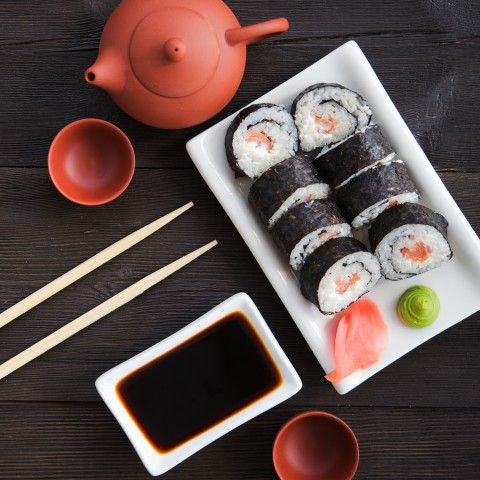
Sushi and Tempura are not the only Japanese words you should know!
3. Personal Aspects
Are you wondering how a knowledge of the Japanese language can improve your personal, everyday life? Here are three great examples for you to consider!
5. Enjoy Japanese Culture in the Original Language
Learning Japanese will allow you to enjoy the Japanese culture deeply.
Whether we’re talking about traditional Japanese calligraphy, martial or culinary arts, or a modern subculture represented by anime, manga, literature, movies, games, etc., there’s no better way to understand and enjoy them than in the original language!
There are actually a lot of Japanese words that cannot be translated into other languages, due to the culture’s unique concepts and philosophies. When such words are translated, they lose subtle nuances and implicit contexts. Speaking Japanese allows you to understand the culture more deeply and better enjoy the original version. You’ll discover a whole new world in the original version that you would never be able to in translated versions.
To learn more about this fun topic, please check out our article Untranslatable Japanese Words.

Enjoy Japanese anime, movies, and games in the original language!
6. Traveling Will Become Easier and More Fun
Japan is one of the most popular destinations to visit among Asian countries. In 2018, more than 31.2 million people traveled to Japan.
Although Japanese people are known to be very kind and polite, always willing to try their best to help you when you ask for directions, you’ll find that it’s difficult to communicate unless you speak Japanese. Most of the local people are not good at speaking English.
If you know Japanese, you’ll be able to easily get around, find the most useful local information, and discover the best eateries that don’t appear in travel guidebooks written for foreigners. And most of all, you’ll meet new people and communicate with locals, which will make your experience more enjoyable and memorable.

Knowing Japanese will allow you to find the best restaurants popular among locals easier.
7. It Will Make You a Different and Unique Person
Knowing Japanese will make you different from others, especially if you’re from an English-speaking country. Because many people choose to learn Spanish, French, or German as a second language, learning Japanese will automatically set you apart from others and will encourage others to see you as an earnest and open-minded person. You may enjoy special privileges and get rare opportunities that most people would not have access to.
In addition, because learning such a unique language gives you new insights and the ability to see things from other perspectives, you’ll be able to understand and appreciate your own language and culture better.
4. Professional Aspects
While learning Japanese can improve your personal life, it also comes with plenty of benefits for your professional life!
8. More Career Options
As mentioned, Japan has the third biggest economy in the world with multi-billion businesses in various industries. Even if you don’t live and work in Japan, knowing Japanese will enhance your professional value and increase your career options in various sectors, including import/export business, aviation, journalism, diplomacy, technology, and science (to name a few).
By learning Japanese, you’ll also understand the culture. Being aware of the Japanese work culture and business etiquette is valued in the professional world, and it means that you’re more likely to have a chance to work for branches of Japanese multinational corporations that are located all around the world (or for domestic companies that have offices in Japan).
Moreover, as the economies of Asian countries grow, more career opportunities are becoming available. And this includes areas outside of Japan, such as those in Asia-Pacific regions.
Wherever you are, knowing Japanese is beneficial for your career!

Tokyo is one of the biggest business cities in Asia.
9. More Business Opportunities
Likewise, having a good command of the Japanese language and understanding the culture behind it will create more business opportunities for you. If you’re a businessperson or diplomat, you’ll likely be expected to manage making deals and to avoid conflicts caused by misunderstandings.
Pushed by the growing popularity of Japanese culture, there are increasing business opportunities related to Japanese cultural exports/imports. In addition to things like Karaoke bars and Sushi restaurants, there are new types of businesses that are gaining fans nowadays. These include cat cafes, manga cafes, Ramen and Okonomiyaki restaurants, Real Escape Room games, cosplay events, etc. Knowing the Japanese language and culture will help you find local Japanese partners faster and boost your marketing efforts.
There are also business opportunities in tourism. Japanese people love traveling overseas, from budget backpackers to luxury resort-lovers who don’t hesitate to spend money on shopping and nice experiences. You can strengthen the marketing of local businesses toward Japanese tourists by posting ads and attractive information on social media and various websites in Japanese. You could also make booking/purchasing systems available in the Japanese language and list prices in Japanese Yen.
Even if you don’t live and work in Japan, there are countless ways to make use of your command of the Japanese language for business opportunities!
- → By the way, do you love Japanese food? Then check out A Guide to the Best Traditional Japanese Foods on JapanesePod101.com!

Knowing Japanese is useful for business opportunities.
5. Is Japanese Easy to Learn?
Anyone interested in learning Japanese has asked this question at some point. The FSI (Foreign Service Institute) ranks Japanese as a Category 5 language, meaning it’s one of the most difficult languages for native English speakers to learn.
However, that’s not technically true if you focus on oral communication alone. Which leads us to reason #10: Learning Japanese is actually a lot easier than you think.
The Japanese writing system with its three different character sets is, of course, very different from what speakers of alphabet languages are used to, and it takes a lot of time and effort to master. Still, learning Hiragana and Katakana as well as basic Kanji does not require endless effort. Once you master Hiragana, you’ll know how to pronounce any Japanese word. At the beginner level, using Roma-ji (romanization of Japanese) is really helpful in understanding and familiarizing yourself with Japanese.
Putting aside the writing system, speaking and listening to Japanese is much easier compared to doing so in English as there are fewer vowel and consonant sounds. In addition, Hiragana and Katakana are very simple; each character represents a specific sound and there’s no variation like there is in English (e.g. the pronunciation of “a” varies from word to word: “ant” / “ace” / “cat”). Therefore, Japanese phonetics is very easy to learn.
From a grammatical point of view, Japanese grammar is indeed very different from English grammar. However, it’s also said that Japanese grammar is simpler than that of English or Romance languages in many ways.
For example:
- There is no distinction between singular and plural.
- We do not use articles (such as “a” or “the”).
- There is no verb conjugation according to the speaker (“I do” / “she does”).
- Japanese only has two simple tenses: the present and the past (there is no “perfect tense” form or “future”).
Now, you can relax a bit and enjoy learning Japanese with this newfound hope!
- → For more details, please take a look at our article Is Japanese Hard to Learn?

Listening and speaking Japanese is not actually so difficult!
6. Conclusion
In this article, we’ve explained the reasons why you should learn Japanese. Learning Japanese will bring you to a new world where you can enjoy a lot of benefits in both your personal life and your professional life.
If you’re wondering where to learn Japanese online, look no further. Create an account with JapanesePod101.com for the fastest and easiest way to fluency. With a variety of rich, free lessons and tools, your Japanese-language skills will improve immensely.
Don’t forget that you’re not alone. When you use our Premium PLUS MyTeacher service, you get your very own tutor who can always help you practice and guide you through personalized assignments.
Before you go, let us know in the comments if you feel ready to start learning Japanese. If not, we’d love to hear your questions or concerns, and we’ll be glad to help any way we can.
Now, it’s time to get started at JapanesePod101.com!

Japanese Tenses: Simple Yet Unique

Did you know that the Japanese language does not have a future tense nor any perfect tenses like English does? Japanese tenses are much simpler to handle, as there are only two: the present tense and the past tense. However, there are some unique rules concerning tenses in Japanese that are quite different from what English speakers are used to.
Auxiliary verbs and post positional particles play important roles in the Japanese language, especially in verb conjugations. This is because Japanese tenses are expressed via auxiliary verbs that connect to verbs. So forget about how you form tenses in English (I do, I will do, I did, I have done, I had done, etc.), and learn Japanese tenses with new rules!
In this article, we’ll explain Japanese tenses and cover the following points:
- How Japanese verb conjugations work
- The role of auxiliary verbs
- The present and past tenses
- How to express things about the future in Japanese
By the end of this article from JapanesePod101.com, you’ll be able to grasp the whole picture of Japanese verbs and tenses—in fact, you’ll better understand Japanese grammar in general!

In Japanese, there’s no particular future tense form like the word “will” in English.
 Table of Contents
Table of Contents
- Japanese Tenses Overview
- Present Tense
- Past Tense
- How to Express the Future in Japanese
- How JapanesePod101 Can Help You Learn More Japanese
1. Japanese Tenses Overview
Before we get ahead of ourselves, let’s go over some basic information regarding Japanese verb tenses and forms.
How Many Tenses are There in Japanese?
Japanese has only two verb tenses, which are the present tense and the past tense. The present tense is also used to express things about the future in Japanese, so there’s no clear distinction between the present tense and the future tense.
Having said that, Japanese grammar technically does not treat verbs for tense. Rather, Japanese verbs take one of five basic conjugation forms and are followed by 助動詞 (jodōshi), or auxiliary verbs/post positional particles, in order to express and determine their tense.
Verb Conjugations and Auxiliary Verbs
As mentioned, there are five basic Japanese verb conjugation forms. When verbs conjugate, the verb base (or “stem”) does not change; the stem rather takes on a different suffix or auxiliary verb to convey the proper meaning.
The correct form is determined by elements such as voice, mood, tense, and politeness level.
- Voice
There are two types of grammatical voice:
能動態 (nōdōtai) – “active voice”
受動態 (judōtai) – “passive voice”
- Mood
Mood is the attitude of the speaker toward the action of the verb. Was the speaker giving an order? Making an assumption? Offering a suggestion?
- Tense
Tense refers to the time of the verb’s action: past, present, or future.
- Politeness Level
The Japanese language has honorific speech called 敬語 (keigo). There are three types of honorific language depending on the level of respect intended:
丁寧語 (teinei-go) – “polite language”
尊敬語 (sonkei-go) – “respectful language”
謙譲語 (kenjō-go) – “humble / modest language”
Example: Tense as an Influential Factor
- 食べる (tabe-ru) – “eat” [present and plain/informal form]
食べ (tabe-) is the verb stem and る (ru) is the suffix.
- 食べた (tabe-ta) – “ate” [past and informal form]
食べ (tabe-) is the verb stem and た (-ta) is an auxiliary verb that expresses the past form.
To learn more details about Japanese verbs and verb conjugations, please see our articles 100+ Most Common Japanese Verbs and Ultimate Japanese Verb Conjugation Guide.

Tenses are expressed by the post positional particles or auxiliary verbs that connect to the verbs:
寿司を食べる /食べた。
Sushi o tabe-ru / tabe-ta.
([I] eat / ate Sushi.)
Formal and Informal Forms
As mentioned in the previous section, there are three Japanese honorific speech levels. Native Japanese people, especially in official settings, are expected to have total command over the three different levels so they can use them according to the situation and to whom they’re talking. However, you won’t experience any problems as a foreigner, as long as you can use polite language in daily conversations.
The polite language usually ends with です(-desu) or ます (-masu) in the present/future tense, and でした (-deshita) or ました (-mashita) in the past tense.
The polite language is generally used as a formal form, and casual/plain language is used as an informal form. While the latter is used for talking with family and friends, most people use the former when talking to strangers or staff members at a store or restaurant.
Example:
歩く(あるく) (aru-ku) – “to walk”
- ある (aru-) = verb stem
- 歩く (あるく) (aru-ku) = informal/plain form
- 歩きます (あるきます) (aru-kimasu) = formal/polite form

Each Japanese tense has a formal form (honorific) and an informal form:
列車が到着します、ご注意ください。
Ressha ga tōchaku shimasu, go-chūi kudasai.
(The train is coming, please be careful.) [formal and polite form]
2. Present Tense
The Japanese present tense is used to talk about things that are happening now, recurring actions, and events set to happen in the future.
Present Tense
Japanese verbs in their informal form always end in -u or -ru. These suffixes correspond to the syllables found in the う段 (u-dan) or “U row” of the Hiragana table.
Japanese verbs in their formal or polite form end with an い段 (i-dan) or え段 (e-dan) syllable followed by ます (-masu): -imasu or -emasu.
Examples [Informal / Formal]
飲む・のむ (no-mu) – “drink”
[ の (no-) is the verb stem ]
- ➢ 私は水を飲む / 飲みます。
Watashi wa mizu o nomu / nomimasu.
I drink water.
付ける・つける (hira-ku) – “turn on”
[ つけ (tsuke-) is the verb stem ]
- ➢ 寒いので暖房をつける / つけます。
Samui node danbō o tsukeru / tsukemasu.
I turn on a heater because it’s cold.
開く・ひらく (hira-ku) – “open”
[ ひら (hira-) is the verb stem ]
- ➢ お店は午前9時に開く / 開きます。
O-mise wa gozen ku-ji ni hiraku / hirakimasu.
The store opens at 9:00 a.m.
Present Progressive Tense
The present progressive tense is used when expressing a continuous action or things that are happening now.
This tense is formed by adding -て いる (-te iru) for informal verbs or -て います (-te imasu) for formal verbs that conjugate in the te-form. Below is a quick description of how to conjugate in the te-form for different verb types.
For u-verbs (Class 1 Verbs):
Add either して (-shite), いて (-ite), って (-tte), or んで (-nde) after the verb stem.
- 話す (hanasu), “talk” → 話して (hanashite)
- 書く (kaku), “write” → 書いて (kaite)
- 買う (kau), “buy” → 買って (katte)
- 読む (yomu), “read” → 読んで (yonde)
For ru-verbs(Class 2 Verbs):
Drop the る (-ru) part of the verb and add て (-te).
- 食べる (taberu), “eat” → 食べて (tabete)
- 調べる (shiraberu), “investigate” → 調べて (shirabete)
As an exception to this pattern, some verbs change form slightly accompanying the sokuon (促音) “っ” before て (-te) for easier pronunciation (in the alphabet, it’s expressed with a double “t”).
- 座る (suwaru), “sit” → 座って (suwatte)
- 当たる (ataru), “hit on,” “bump into” → 当って (atatte)
- 降る (furu), “fall (such as rain, snow, etc.)” → 降って (futte)
Unlike that in English, the Japanese progressive tense cannot indicate an action that is going to happen in the near future. (E.g. In English, it’s okay to say: She is moving to the USA this coming summer.) The Japanese present progressive tense only indicates actions that are ongoing.
Examples [Informal / Formal]
- ➢ 私はいすに座っている / 座っています。
Watashi wa isu ni suwatte iru / suwatte imasu.
I’m sitting on a chair.
[座る・すわる (suwa-ru) or “sit”]: すわ (suwa-) is the verb stem.
- ➢ 彼はテレビを見ながら食べている / 食べています。
Kare wa terebi o minagara tabete iru / tabete imasu.
He is eating while watching TV.
[食べる・たべる (tabe-ru) or “eat”]: たべ (tabe-) is the verb stem.
- ➢ 猫と犬が庭で遊んでいる / 遊んでいます。
Neko to inu ga asonde iru / asonde imasu.
A cat and a dog are playing in the garden.
[遊ぶ・あそぶ (aso-bu) or “play”]: あそ (aso-) is the verb stem.

今行きます。(Ima ikimasu.) – “I go now.” [ in a polite/formal form ]
3. Past Tense
Forming the Japanese past tense is very simple! Whether an action took place just a few minutes ago, happened many centuries ago, or was being talked about by someone in the past who was talking about an even older past, the Japanese past tense has just one form. There are no such variations as “did,” “have done,” “had done,” etc.
Past Tense
Japanese verbs in the past tense normally end with た (-ta) in the informal form, though sometimes た (-ta) changes to った (-tta) or だ (-da) depending on the verb. In the formal form, verbs conjugating into い段 (i-dan) or え段 (e-dan) end with ました (-mashita). I-dan and e-dan refer to the rows of syllables on the Hiragana table that end with the vowel sound “i” or “e” respectively.
Examples [Informal / Formal]
- ➢ 彼は映画を見た / 見ました。
Kare wa eiga o mita / mimashita.
He watched a movie.
[見る・みる (mi-ru) or “watch”/”see”/”look”]: み (mi-) is the verb stem.
- ➢ 昨日友達と泳いだ / 泳ぎました。
Kinō tomodachi to oyoida / oyogimashita.
I swam with my friend yesterday.
[泳ぐ・およぐ (oyo-gu) or “swim”]: およ (oyo-) is the verb stem.
- ➢ 父親が昔宝くじに当たったことを話した / 話しました。
Chichioya ga mukashi takarakuji ni atatta koto o hanashita / hanashimashita.
My father told a story about winning a lottery in the past.
[当たる・あたる (ata-ru) or “win prize/lottery”]: あた (ata-) is the verb stem.
[話す・はなす (hana-su) or “talk”/”tell”]: はな (hana-) is the verb stem.
Past Progressive Form
The past progressive tense is used when expressing continuing actions in the past. In order to form the Japanese past progressive tense, add -て いた (-te ita) [informal] / -て いました (-te imashita) [formal] after a verb that conjugates in the te-form as explained in the Present Progressive Tense section.
Examples [Informal / Formal]
- ➢ 彼女が来た時、彼は寝ていた / 寝ていました。
Kanojo ga kita toki, kare wa nete ita / nete imashita.
When she came, he was sleeping.
[寝る・ねる (ne-ru) or “sleep”]: ね (ne-) is the verb stem.
- ➢ 買い物をしていた時、外は雨が降っていた / 降っていました。
Kaimono o shite ita toki, soto wa ame ga futte ita / futte imashita.
When I was shopping, it was raining outside.
[する (su-ru) or “do”] Irregular Verb: Please see the detailed explanation of irregular verbs in our conjugation article.
[降る・ふる (fu-ru) or “fall (rain/snow/etc.)”]: ふ (fu-) is the verb stem.
- ➢ そのとき、あなたは何をしていた / していましたか。
Sono toki, anata wa nani o shite ita / shite imashita ka.
What were you doing then?
[する (su-ru) or “do”]: Irregular Verb

先月家族と旅行に行った。(Sengetsu kazoku to ryokō ni itta.)
“(I) took a trip with (my) family last month.” [informal/casual]
4. How to Express the Future in Japanese
As mentioned, the Japanese present tense is also used to talk about actions in the future. Speakers can express the future using the present tense in the following ways.
Context
With context and extra information, listeners can understand that an action is set in the future.
Examples:
- ➢ 試験が終わったら、友達と何か美味しいものを食べに行きます。
Shiken ga owattara, tomodachi to nani ka oishii mono o tabe ni ikimasu.
When the exams are over, I will go to eat something delicious with my friends.
- ➢ 彼は毎日ピアノを練習しています。彼は絶対、プロのピアニストになります。
Kare wa mainichi piano o renshū shite imasu. Kare wa zettai, puro no pianisuto ni narimasu.
He practices piano everyday. He will definitely become a professional pianist.
- ➢ 全員の準備ができ次第、出発します。
Zen’in no junbi ga deki shidai, shuppatsu shimasu.
As soon as everyone is ready, we will depart.
Time Words
Using time words (such as specific dates or terms like “later” and “tomorrow”) is the easiest way to indicate that an action is set in the future.
Examples:
- ➢ 明日の午後、小包が届きます。
Ashita no gogo, kozutsumi ga todokimasu.
The parcel will arrive in the afternoon tomorrow.
- ➢ 私は3月に大学を卒業します。
Watashi wa san-gatsu ni daigaku o sotsugyō shimasu.
I will graduate from university in March.
- ➢ 私の両親は来月沖縄へ旅行に行きます。
Watashi no ryōshin wa raigetsu Okinawa e ryokō ni ikimasu.
My parents will take a trip to Okinawa next month.
Words That Indicate an Intention or Plan
Another way to express things about the future is to use words that indicate an intention or plan.
There are two words often used for this purpose:
- つもり(tsumori) – “intend to” or “plan to”
- 予定 (yotei) – “plan to”
Examples:
- ➢ 私はこの仕事を辞めるつもりです。
Watashi wa kono shigoto o yameru tsumori desu.
I intend to quit this job.
- ➢ 卒業パーティーには参加しない予定です。
Sotsugyō pātī ni wa sanka shinai yotei desu.
I plan not to participate in the graduation party.
- ➢ 彼女は看護師になる予定です。
Kanojo wa kangoshi ni naru yotei desu.
She plans to become a nurse.
The Particle に (ni)
A future intention is also expressed by placing the particle に (ni) between two verbs, with the latter verb often being:
- 行く (iku) – “go”
or
- 来る (kuru) – “come”
Examples:
- ➢ 彼氏が私に会いに来ます。
Kareshi ga watashi ni ai ni kimasu.
My boyfriend will come to see me.
- ➢ 美術館の特別展を見に行きます。
Bijutsukan no tokubetsuten o mi ni ikimasu.
I will go to see the special exhibition at the museum.
- ➢ 兄の引越しを手伝いに行きます。
Ani no hikkoshi o tetsudai ni ikimasu.
I will go and help (my) brother’s moving.

明日の朝9時までに書類を提出しに行きます。
Ashita no asa ku-ji made ni shorui o teishutsu shi ni ikimasu.
“I will go to submit the document by 9:00 in the morning tomorrow.”
How JapanesePod101 Can Help You Learn More Japanese
In this article, we introduced you to Japanese tenses and how they work. We also touched on verb conjugation and the role auxiliary verbs play in the process. Japanese tenses are quite simple, yet there are unique rules that learners of the language should study early on. Once you get used to it, you’ll find that Japanese tenses are very easy!
If you would like to learn more about the Japanese language and pick up some useful Japanese phrases for any situation, you’ll find tons of helpful content on JapanesePod101.com. We provide a variety of free lessons to help you improve your Japanese language skills and become familiar with the culture. To get you started, here’s some more information regarding the basics of Japanese:
To learn more about Japanese verbs and other grammar-related topics, check out Basic Kanji for Verbs and The 50 Most Common Japanese Verbs You’ll Find in Textbooks. Useful pages for improving your conversation skills in Japanese include How to Improve Your Speaking Skills and Must-Know Adverbs and Phrases for Connecting Thoughts.
And there’s so much more! Learn Japanese faster and enjoy every minute of your studies at JapanesePod101.com!
Before you go, let us know in the comments if you still have any questions about Japanese tenses. We’d be glad to help, and look forward to hearing from you!

How Long Does it Take to Learn Japanese?

If you’re like most aspiring learners, you may be wondering: How long does it take to learn Japanese? Some people think that learning Japanese is too hard, that it takes forever and requires tremendous painstaking effort. But is that really true?
The answer to this question varies depending on multiple factors, such as your…
- …mother tongue.
- …educational background.
- …previous language learning experience.
- …level of interest and enthusiasm.
- …learning goals.
- …study methods.
In this article, we’ll give you some insight on how long it takes to learn Japanese for the different proficiency levels, keeping these influencing factors in mind. We’ll also provide tips to help you make the most of your study time.
Are you ready? Set your goals and join JapanesePod101.com on the first step of your language learning journey!

How long does it take to learn Japanese and how can you reach your goals faster?
 Table of Contents
Table of Contents
- Japanese Learning Overview
- How Long Does it Take to Achieve Beginner Level?
- How Long Does it Take to Achieve Intermediate Level?
- How Long Does it Take to Achieve Advanced Level?
- Conclusion
1. Japanese Learning Overview
Before we get into the details, let’s go over how the proficiency levels are defined. This will give you a good idea of what to expect at each stage of your learning journey and give you the knowledge you need to prepare accordingly.
Language Difficulty Rankings
The Foreign Service Institute (FSI) projects how difficult it will be and how long it will take for an English speaker to achieve a “Professional Working Proficiency” level in a given language. The difficulty levels are grouped into five categories, from the easiest languages (Category I) to the most difficult (Category IV). Category I languages are the most similar to English, and Category IV languages are the least similar.
Although the length of time needed to achieve proficiency can vary depending on many factors, FSI estimates the average approximate time for Category I languages to be 24-30 weeks (600-750 class hours). On the other hand, Category IV languages like Japanese take about 88 weeks (2200 class hours) to learn. Japanese is considered an “exceptionally difficult” language for native English speakers to master.
This assessment includes proficiency in reading, one of the most difficult parts of le/arning Japanese. The Japanese writing system is very different from the English alphabet, so many English speakers struggle to adapt.
That said, you can expect the learning process to be less difficult if your goal has more to do with speaking and listening (such as being able to make conversation and watch Japanese movies without subtitles). There are also some areas where Japanese is simpler than English, which can make learning the language a bit easier. For example, Japanese has fewer vowel and consonant sounds, simple rules for using tense, no plural form or articles, and no verb conjugations according to person.
- → Please see our article Is Japanese Hard to Learn? in order to discover the easiest and most difficult aspects of the language.
JLPT: Japanese-Language Proficiency Test
The JLPT (Japanese-Language Proficiency Test) is an official standardized criterion-referenced test that evaluates and certifies the Japanese-language proficiency of non-native Japanese speakers. It assesses language knowledge (grammar and vocabulary), reading ability, and listening ability.
The JLPT has five levels: N1 (the most difficult), N2, N3, N4, and N5 (the easiest).
| N1 | Advanced | The ability to understand all of the Japanese used in different everyday contexts. |
| N2 | Pre-Advanced | The ability to understand the majority of Japanese phrases used in different everyday contexts. |
| N3 | Intermediate | The ability to understand some of the Japanese phrases used in everyday situations. |
| N4 | Elementary | The ability to understand basic Japanese. |
| N5 | Beginner | The ability to understand some basic Japanese. |
The Japanese Language Education Center shows the study-hour data for JLPT by level, as well as the comparison between students with and without prior Kanji knowledge. The information indicates that students without prior Kanji knowledge will need more study time to reach each level.
[JLPT Study-Hour Comparison Data 2010-2015]
| Students with Kanji Knowledge (e.g. speakers of Chinese or Korean) | Students without Kanji Knowledge | |
| N1 | 1700~2600 hours | 3000~4800 hours |
| N2 | 1150~1800 hours | 1600~2800 hours |
| N3 | 700~1100 hours | 950~1700 hours |
| N4 | 400~700 hours | 575~1000 hours |
| N5 | 250~450 hours | 325~600 hours |

Make progress step by step to increase your language proficiency level.
Influencing Factors
That being said, there are numerous factors that influence how long it takes to learn Japanese.
Your Mother Tongue / Language Learning Experience
If your native language is similar to your target language, the learning process will be much faster and easier than if you tried learning a very different language. Likewise, if you have some language learning experience and are somewhat familiar with your target language already, this will definitely help you learn faster and more effectively.
In this regard, English speakers and learners unfortunately have little privilege when it comes to learning Japanese.
The classification of the Japonic languages (Japanese and its dialects) is still unclear, but many linguists see the Japonic languages as an independent family. Thus, Japanese doesn’t really have a family of close and similar languages, such as the Romance languages (Spanish, Italian, and French).
However, Japanese Kanji characters were originally brought from Ancient China and incorporated into Japanese. Although Chinese people cannot read or pronounce Japanese Kanji, they can often guess their meanings. While Chinese grammar and phonetics are very different from those of Japanese, the Korean language has some grammatical and phonetic similarities. Therefore, Chinese and Korean speakers (as well as learners of these languages) have a slight advantage when it comes to learning Japanese.
- → For more about the Japanese language, please see Japanese Language Overview: All the Facts You Need to Know.
Your Learning Goal / Motivation
What is your definition of ‘learning Japanese’ and what is your learning goal?
If your goal is to learn basic survival Japanese for traveling, then it won’t take very long to achieve. You would only have to learn some essential greetings and other useful phrases.
However, it would take a lot of time and effort to reach a level where you could watch Japanese movies and anime without subtitles, or speak fluently with Japanese natives. This requires good speaking and listening skills.
Learning to read and write high-level Kanji would also require a lot of time and effort. You would need to attain solid grammatical knowledge and gain a good command of Kanji. This would allow you to read Japanese newspapers and write official documents.
Whatever your learning goal may be, your motivation and enthusiasm play an important role as well. Whether you’re a big fan of Japanese culture and anime or you wish to live and work in Japan, your motivation impacts your level of commitment and your attitude toward learning Japanese. Your level of motivation determines how much time and effort you’re willing to dedicate to learning.
Study Method / Time You Dedicate to Learning
As the proverb says, “There is no royal road to learning.” The more time you spend, the more knowledge you get. The accumulation of small but continuous effort is important.
Even for the same hour spent on language learning, the results you’d get will differ depending on how you’re learning and how that time was used. For example, were you watching Japanese anime, reading a textbook, or talking with a Japanese teacher in class?
If you want to focus on daily conversations, then reading a textbook about grammar may not be the best learning method. You would probably fare better talking with a Japanese tutor online and watching Japanese movies with subtitles, as this would improve your speaking and listening skills faster.
Once you set your goal, try to find the best learning methods for your purposes. There are multiple options you can work on from your home, even if you’re outside of Japan. These include online lessons and online tutoring for more effective learning, and using YouTube and Netflix for a more laid-back and fun approach to studying.

Thanks to the internet, there are numerous ways we can learn from anywhere.
2. How Long Does it Take to Achieve Beginner Level?
Those who are thinking of starting to learn Japanese often wonder where to start, what to aim for as a beginner, and how long it will take to reach the beginner level. In this section, we’ll answer these questions and provide you with tips for how to learn Japanese effectively at this stage.
JLPT: N5 & N4 Levels
Even if you don’t take an actual exam, JLPT can be a good guideline to help you know what needs to be done to achieve a certain level. If you want to reach the N5 & N4 levels, you’ll need to build a foundation by learning the basic Japanese grammar and vocabulary.
N5 Level: Beginner
Reading
You should be able to…
- …understand typical daily expressions and sentences written in Hiragana, Katakana, and very basic Kanji.
[Example Exercise]
| A: あの 人 は だれ です か。 Ano hito wa dare desu ka. Who is that person? B: かれ は 田中さん です。 Kare wa Tanaka-san desu. He is Mr. Tanaka. |
Listening
You should be able to…
- …listen to and comprehend conversations about topics regularly encountered in daily life and classroom situations.
- …pick up necessary information from short conversations spoken slowly.
[Example Exercise]
| Listen to a question and a conversation and choose the best answer. — 男の人と女の人が話しています。男の人は何時に寝ましたか。 Otoko no hito to onna no hito ga hanashite imasu. Otoko no hito wa nan-ji ni nemashita ka. The man and the woman are talking. What time did the man go to bed? — (女/woman) 眠そうな顔してるね。 Nemusō na kao shiteru ne. You look sleepy. (男/man) 昨夜は遅くまで勉強していて。 Sakuya wa osoku made benkyō shite ite. I was studying until late last night. (女/woman) 何時ごろ寝たの? Nan-ji goro neta no? Around what time did you go to bed? (男/man) 3時半ごろ。 San-ji han goro. Around three thirty. |
N4 Level: Elementary
Reading
You should be able to…
- …read and understand passages on familiar everyday topics written in basic vocabulary and Kanji.
[Example Exercise]
| パスポート ばんごう を おしえて ください。 Pasupōto bangō o oshiete kudasai. Please tell me the passport number. ここ に あなた の うちの じゅうしょ を かいて ください。 Koko ni anata no uchi no jūsho o kaite kudasai. Please write your home address here. |
Listening
You should be able to…
- …listen to and comprehend conversations encountered in daily life and generally follow their contents (provided that they’re spoken slowly).
[Example Exercise]
| Listen to the question and answer options, and choose the best answer. — 仕事が終わって帰ります。何と言いますか。 Shigoto ga owatte kaerimasu. Nan to iimasu ka. (You) finished work and are going home. What do you say? おじゃまします。(Ojama shimasu.) お大事に。(Odaiji ni.) お先に失礼します。(Osaki ni shitsurei shimasu.) |
Native English speakers, or those who do not have previous Kanji knowledge, need approximately 325-600 hours of studying for N5 and 575-1000 hours for N4 level.
JLPT assesses mainly reading and listening skills, so you may need to put in some extra effort to write and speak at such levels.
How to Get to Elementary Level Faster
The most important thing for beginners to do is familiarize themselves with the Japanese language. You can get used to Japanese sentence structure, pronunciation, and basic vocabulary by doing simple exercises and repeating them until you feel comfortable with the content or concepts. With apps and online lessons, you can study anytime and anywhere.
Imiwa? and Japanese by Renzo Inc. are dictionary apps that allow you to look up any Japanese word you want to know. You can also use them to check the reading of Kanji, learn how to write Kanji, and see some usage examples.
The NHK Easy Japanese News app is a news app provided by Japan’s national broadcaster. It provides news articles written in simple sentences with 振り仮名 (furigana), or reading aid, for Kanji.
Online Lessons:
JapanesePod101.com offers informative yet fun audio and video lessons for absolute beginners. Together with grammar essentials, you’ll learn real and practical spoken Japanese. Our short and easy-to-understand lessons will keep you hooked from Level 1.

To learn a language, the output of knowledge is just as important as the input.
3. How Long Does it Take to Achieve Intermediate Level?
Depending on your goals, the next logical step is probably to learn even more and reach an intermediate level of fluency. So how long will it take you to learn Japanese to such an extent, and how can you get there?
JLPT: N3 Level
Reading
You should be able to…
- …read and understand written materials with specific contents concerning everyday topics.
- …grasp summarized information such as newspaper headlines.
- …read the kind of writing encountered in everyday situations that may be a bit more difficult, understanding the main points (as long as alternative phrases are available to you if needed).
[Example]
| 山本さんはクラスの代表に選ばれた。 Yamamoto-san wa kurasu no daihyō ni erabareta. Mr./Ms. Yamamoto was selected as a representative of the class. その会社は海外から輸入したバッグを日本で売っている。 Sono kaisha wa kaigai kara yunyū shita baggu o Nihon de utte iru. The company sells bags in Japan which they imported from abroad. |
Listening
You should be able to…
- …listen to and comprehend coherent everyday conversations spoken at near-natural speed, while following most of the spoken content and determining the relationships of the people speaking.
[Example Exercise]
| Listen to the question and answer options, and choose the best answer. — 試験に合格したので先生に伝えたいです。何と言いますか。 Shiken ni gōkaku shita node sensei ni tsutaetai desu. Nan to iimasu ka. (You) passed the exam and you want to tell this to the teacher. What do you say? 1 – 今回はおめでとうございます。(Konkai wa omedetō gozaimasu.) – Congratulations this time. 2 – 今度、合格なさいました。(Kondo, gōkaku nasaimashita.) – This time (he) passed. [in respectful form for others] 3 – おかげさまで、試験に受かりました。(Okage-sama de, shiken ni ukarimashita.) – Thanks to you, I passed the exam. |
For native English speakers, it’s estimated that around 950-1700 hours of studying is needed to achieve the N3 level.
How to Get to Intermediate Level Faster
To reach the intermediate level, you need to increase your knowledge of more complex grammar concepts and memorize a variety of everyday vocabulary words and phrases. In addition, it’s time to get used to the natural and native speaking speed. In order to achieve that, the amount of output is just as important as the amount of input—in other words, you need to practice active listening as well as speaking. Textbooks and lessons can only teach you so much!
Paper Materials:
Master intermediate-level grammar from your textbooks, and consider reading light novels and magazines to increase your daily input of Japanese.
Apps:
Wondering how to learn more Japanese vocabulary? Anki is an intelligent flashcard app that helps you memorize words more easily and increase your vocabulary.
Once you know the basics of how to compose Japanese sentences and have a solid vocabulary base, it’s time to start practicing. Hello Talk is a language exchange app that you can download on iOS or Android devices. With this app, you can find Japanese online friends to talk to.
Audio/Video Materials:
There’s a variety of audio/video sources for learning Japanese out there. YouTube and Netflix are easy options. Immerse yourself in Japanese-speaking environments every day—right from the comfort of your couch!
Need some recommendations? Then check out the following blog posts on JapanesePod101.com:
- ★ Top 10 Japanese YouTube Channels to Improve Your Japanese
★ Japanese Netflix Programs: Learn Japanese with Netflix
Online Lessons and Online Tutoring:
In addition to online lessons, useful vocab lists, and insightful articles on various topics, JapanesePod101.com provides a one-on-one tutoring service called MyTeacher. This service allows you to interact with your own personal teacher, who can help you personalize your learning program based on your progress and provide you with valuable feedback.

4. How Long Does it Take to Achieve Advanced Level?
Are you looking to become completely fluent in Japanese? Then be prepared to dedicate a lot of your time and effort to the task. This is a long journey, and you might begin to feel like you’re not progressing anymore no matter how much time you spend studying. Your progress may be slower than it was reaching the previous two levels, but every small effort counts. You’ll surely advance if you keep at it and don’t give up!
1. JLPT: N2 & N1 Level
N2 Level: Pre-Advanced
Reading
You should be able to…
- …read and comprehend clearly written content on various topics, including articles and commentaries in newspapers and magazines, as well as simple critiques.
- …read written materials on various topics, follow their narratives, and understand the writers’ intent.
[Example Exercise]
| (1) _____の言葉を漢字で書くとき、最もよいものを一つ選びなさい。 _____ no kotoba o kanji de kaku toki, mottomo yoi mono o hitotsu erabinasai. Choose the most appropriate one when the word _____ is written in Kanji. — 今日は、ゴミのしゅうしゅう日ですか。 Kyō wa, gomi no shūshūbi desu ka. Is it garbage collection today? 1. 拾集、2. 収拾、3. 修集、4. 取集 (2) ( )に入るのに、最もよいものを一つ選びなさい。 ( ) ni hairu no ni, mottomo yoi mono o hitotsu erabinasai. Choose the most appropriate one for ( ). — 日本人の平均( )は、男性が79歳、女性が86歳である。 Nihon-jin no heikin( ) wa, dansei ga 79-sai, josei ga 86-sai de aru. The Japanese average( )is male 79 years old and female 86 years old. 1. 生命、2. 寿命、3. 人生、4. 一生 seimei jumyō jinsei isshō |
Listening
You should be able to…
- …understand orally presented materials (coherent conversations, news reports, etc.) on a variety of topics and in different settings, spoken at nearly natural speed.
- …follow the main ideas and content of such materials.
- …understand the relationships of the people involved.
[Example Exercise]
| Listen to the sentence and choose the best reply. — あの、今、お時間よろしいでしょうか。 Ano, ima, o-jikan yoroshii deshō ka. Excuse me, do you have time now? [Can I talk to you?] 1 – えっと、4時5分ですよ。(Etto, yo-ji go-fun desu yo.) – Well, it’s 4:05. 2 – あいにく私も時計がなくて。(Ainiku watashi mo tokei ga nakute.) – Unfortunately, I don’t have a watch either. 3 – 10分くらいなら。(Juppun kurai nara.) – [Yes, I have] about ten minutes. |
N1 Level: Advanced
Reading
You should be able to…
- …read texts featuring complex logic or abstract ideas on a variety of topics (newspaper editorials, critiques, etc.) and comprehend their structure and content.
- …read texts featuring profound content on various topics, follow their narratives, and understand the writers’ intent.
[Example Exercise]
| (1) _____の言葉の読み方として、最もよいものを一つ選びなさい。 _____ no kotoba o yomikata to shite, mottomo yoi mono o hitotsu erabinasai. Choose the most appropriate reading for the word_____. — 彼は今、新薬の研究開発に挑んでいる。 Kare wa ima, shin’yaku no kenkyū kaihatsu ni _____iru. He is now challenging the research and development of new drugs. 1. はげんで、2. のぞんで、3. からんで、4. いどんで (2) ( )に入るのに、最もよいものを一つ選びなさい。 ( ) ni hairu no ni, mottomo yoi mono o hitotsu erabinasai. Choose the most appropriate one for ( ). — 私の主張は単なる( )ではなく、確たる証拠に基づいている。 Watashi no shuchō wa tan naru( )de wa naku, kakutaru shōko ni motozuite iru. My claim is based on solid evidence, not just ( ). 1. 模索、2. 思索、3. 推測、4. 推移 mosaku shisaku suisoku suii |
Listening
You should be able to…
- …comprehend spoken content in the form of conversations, news reports, and lectures in various contexts, when spoken at natural speed.
- …follow the ideas and understand the implicit meaning of such spoken content.
- …understand important details of such spoken content, including the relationships of those involved, logical structures, and essential points.
[Example Exercise]
| Listen to the sentence and choose the best reply. — 今日は、お客さんからの苦情が多くて仕事にならなかったよ。 Kyō wa, o-kyaku-san kara no kujō ga ōkute shigoto ni naranakatta yo. I couldn’t work much today because there were many complaints from customers. 1 – いい仕事、できて良かったね。(Ii shigoto, dekite yokatta ne.) – That’s good you have done a great job. 2 – 仕事、なくて大変だったね。(Shigoto, nakute taihen datta ne.) – It must have been tough without work. 3 – お疲れ様、ゆっくり休んで。(Otsukare-sama, yukkuri yasunde.) – You must be tired (well done), rest well. |
It’s estimated that it takes about 1600-2800 hours to achieve N2 and 3000-4800 hours to achieve N1. However, if you also want to master the Japanese Kanji of these levels, you’ll probably need to put in even more hours.
How to Get to Advanced Level Faster
At this point, you probably don’t have any issues with daily Japanese conversations. You just need to focus on expanding your high-level vocabulary, getting a good working knowledge of official and formal language (including different honorifics), and picking up some spoken colloquial language that’s not often found in ordinary textbooks or written documents. Below are a few ways you can speed up your learning process.
Paper Materials:
You can gain exposure to a wider range of vocabulary (including official words and technical terms) by reading more advanced paper materials. These include Japanese newspapers, magazines, and books on topics that interest you (business, biographies, IT, health, etc.).
Apps:
If you can, utilize all of the dictionary apps we mentioned earlier; this will surely take you to the next level. Kanji Senpai is another useful app that you can use to brush up on your Kanji skills by practicing and writing characters. Using news apps for daily reading is another effective way to learn official language.
Audio/Video Materials:
When using audio/video materials, try to focus on quality. Watching Japanese anime is fun and interesting, but it won’t take you to an advanced level. If you get bored of watching serious news channels and want something fun, you can choose to watch Japanese movies/TV shows in more complex genres (mystery, science fiction, crime thriller, techno thriller, etc.).
Online Lessons / Online Tutoring:
JapanesePod101.com offers plenty of more advanced online lessons in the form of written, audio, and video content. Our materials are designed to help you learn practical and natural Japanese in a fun and effective way. As an intermediate or advanced learner, you’ll greatly benefit from our one-on-one tutoring service MyTeacher; you’ll need the guidance and corrections of a native speaker in order to advance more quickly.

Reading newspapers will help you expand your vocabulary and reach an advanced level of Japanese.
Conclusion
In this article, we talked about how long it takes to learn Japanese by level and discussed a number of influencing factors. As you can see, the amount of time it takes you to learn the language has a lot to do with what your goals are: becoming a fluent speaker and listener will be much easier than mastering the Japanese reading and writing system.
If you would like to explore the Japanese language further, stay with JapanesePod101.com for the fastest and easiest way to fluency. With our variety of rich, free lessons and tools, your Japanese language skills will improve immensely.
Don’t forget that you’re not alone. When you use our MyTeacher service, your own teacher can always help you practice through personalized activities and assignments. You can also reach out to native speakers and your fellow Japanese learners through the JapanesePod101 forum!
Before you go, let us know in the comments if you feel ready to start learning Japanese. If not, we’d love to hear your questions or concerns, and we’ll be glad to help any way we can.
Now, it’s time to get started with JapanesePod101.com!

Being able to use appropriate business-level Japanese proves that you’ve achieved the advanced level.













